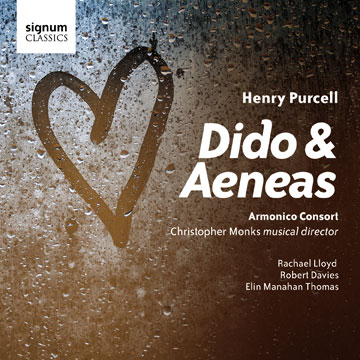June 30, 2015
Guillaume Tell, Covent Garden
Which is a shame for on the first night there much fine singing, strong musical direction from Antonio Pappano in the pit, and a convincing central trope. But, there was also a wealth of redundant stage business and an absence of meaningful stagecraft, with a series of tableaux replacing genuine dramatic development. And, then there is the director’s decision to foreground the sexual brutality of war, which so many in the audience — myself included — found sensationalist, distasteful and gratuitous.
Paolo Fantin’s plain white-cube set, with its soil-strewn sloping floor, evokes recent Balkan conflicts, though the context is widened by the costumes of Carla Teti which range from the 1940s to the present day. There is certainly nothing very pastoral about the opening Shepherd’s Festival — even though Michieletto repeatedly hammers home the need to connect with the spirit of one’s homeland as embodied in its earth. The villagers’ weddings celebrations are rather muted as they sit at bare tables, the dull brown alleviated by just a single unexceptional tree.
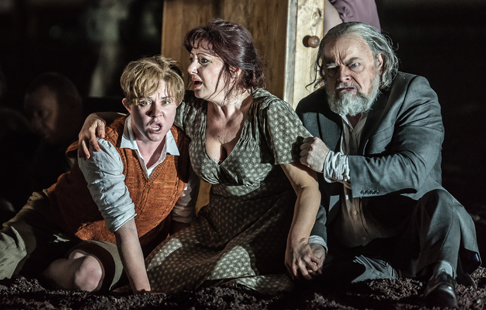 Sofia Fomina as Jemmy, Enkelejda Shkosa as Hedwige, and Eric Halfvarson as Melcthal
Sofia Fomina as Jemmy, Enkelejda Shkosa as Hedwige, and Eric Halfvarson as Melcthal
But, this tree is Michelietto’s big idea. Uprooted at the end of Act 1 by a marauding Austrian soldier, the tree returns to dominate the stage in the subsequent acts: horizontal and enlarged, its twisting branches and gnarled roots etch and score sharp gothic shadows onto the bare skies beyond. It is a striking symbol of the threat posed by colonial terrorists to a land and its people, but Alessandro Carletti’s lighting design is fairly unadventurous — a few juxtapositions of yellow and blue but otherwise muted — and over the succeeding three and a half hours the shadows blend into the prevailing greys and browns. More problematic is the fact that the tree is a hindrance to movement; so, the fallen trunk can revolve to reveal different locations but there is little meaningful choreography within those locations.
Perhaps we are supposed to imagine the various scenes as a sequence of story-book stills? For, as is made clear to us by the film projection which accompanies the overture, what we are witnessing is actually taking place in the imagination of William Tell’s son, Jemmy. This also helps to explain how and why the silent Robin Hood-figure who roams the stage, flamboyantly stabbed arrow-heads and later a shining cutlass into the table tops and soil, has found himself amid these rather bland mid-twentieth century insurgents. Thus, this feather-hatted, red-cloaked archer has stepped straight from the Illustrated Classics tale that Jemmy has been reading while manoeuvring his lime green and mustard yellow toy soldiers into strategic battle formations. And, the legendary medieval marksman provides a benchmark by which young Jemmy can measure his own father’s achievements and courage, culminating — when Tell has been captured — in a petulant outburst in which Jemmy rips the pages from his book, while the comic-strip narrative is projected on a front-stage screen.
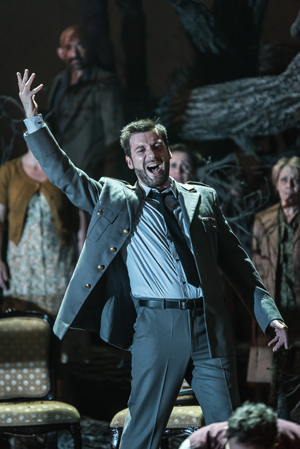 Nicolas Courjal as Gesler
Nicolas Courjal as Gesler
The red-cloaked figure comes into his own in the mimed scenes with which Michelietto replaces Rossini’s original dance sequences. In 1820s Paris, Rossini’s Opéra audience welcomed, indeed expected, lengthy ballet scenes; but the diegetic dance music presents a challenge for the modern director. In this production, the divertissement of Act 1 is an archery competition in which Jemmy finesses his skills, but even the presence of the master-archer cannot stop a few of the arrows falling shy of the bull’s-eye. And, such child’s-play is not entirely harmless, Michieletto suggests, when in Act 2 the Austrian soldiers try to teach the Swiss children how to a cross a sword or pull a trigger — not so dissimilar to the lesson in weaponry that Tell gives his son.
There’s a lot of superfluous business in these mime episodes, but they trundle along without causing undue alarm, until we reach Act 3. Now, the forest floor is decorated with, first, the genteel soft furnishings of Mathilde’s Habsburg palace, and then the elongated table and sparkling chandelier of the occupying Austrian officers’ banqueting room. The sadistic Austrian Governor, Gesler, orders festivities to mark the Empire’s benign sustenance of the pitiful Swiss nation; one would expect some innocuous folky stuff to follow. But, Michieletto gives us a prolonged sexual attack during which a female actor is abused by the officers, force-fed champagne, molested with a pistol and then stripped naked and gang-raped atop the banquet table.
These unwarranted, distasteful antics are not only entirely completely at odds with the spirit and style of Rossini’s music, but on this opening night they also upset a large proportion of the audience who proceeded to make their condemnation piercingly known; and as the jeering and hissing escalated, the hecklers were themselves barracked by those disapproving of such mid-performance raucousness. Pappano and the cast ploughed on regardless, only to be greeted with more hooting at the end of the dance sequence.
Cat-calling at the curtain has been common of late at Covent Garden but, clearly rattled by such an unprecedented mid-performance outburst, Kasper Holten subsequently felt obliged to issue an explanatory, mollifying statement: ‘The production includes a scene which puts the spotlight on the brutal reality of women being abused during war time, and sexual violence being a tragic fact of war. The production intends to make it an uncomfortable scene, just as there are several upsetting and violent scenes in Rossini’s score. We are sorry if some people have found this distressing.’
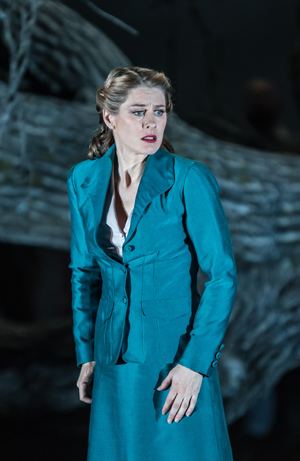 Malin Byström as Mathilde
Malin Byström as Mathilde
In truth, the sexual violence was probably no more explicit than that presented in any number of modern opera, theatre or cinema productions; but, it was prolonged and uncalled-for. Few can be unaware of the ‘brutality, the suffering [people in war zones] have had to face’ (which Michieletto has insisted it was his intent to illuminate for us) given the newsfeed from war-torn lands which we see on a daily basis. But, the heckling was excessive too, and it made it difficult for Pappano and the cast to establish a fittingly poignant mood for the beautiful duet between Guillaume and Jemmy which follows, as the former prepares for his apple-target challenge.
The sneering of a few malcontents threatened to resume at the start of Act 4, just as John Osborn prepared to tackle one of the most demanding scenas in the opera, indeed in the repertoire, but it was silenced by the hushings of the majority. In the role of Arnold Melcthal, Osborn gave the performance of the evening, surmounting the registral challenges with confidence and security. Arnold was understandably tense in Act 1, and he tended to launch vigorously at the top notes, sometimes over-reaching and the tone a little taut. But, he relaxed into the role — his Act 2 duet with Mathilde, ‘Oui, vous l'arrachez à mon âme’ (Yes, you wring from my soul) was beautifully phrased — and he showed great stamina, going from strength to strength as the drama unrolled. Osborn has both the dark weight and bel canto lyricism that the role demands, and he exhibited flexibility, bright clarity and superb enunciation in the stirring lament that opens Act 4, and tremendous power and projection in ‘Amis, amis, secondez ma vengeance’ (Friends, friends, assist my vengeance) despatching the repeating top Cs with dramatic and musical conviction.
Malin Byström was clear-voiced as Mathilde, using varying tone to convey emotion and passion. She and the other soloists were not always sympathetically supported by Michieletto: at the start of her first aria — ‘Sombre forêt, désert triste et sauvage’ (Somber forest, sad and savage wilderness) in Act 2 — Byström was asked to climb onto the twisted tree trunk at a time when she must have had other, more important, musical matters to contemplate than focusing on not slipping from her precarious platform. It was also unclear why she needed to take off some of her clothes during this aria — surely it was cold in the forest — unless it was to embrace the tree with her bare flesh in order to imbibe the spirit of her fatherland?
Gerard Finley’s William Tell is a rather dejected and jaded people’s champion, seemingly worn out by the struggle both to resist his oppressors and to inspire his countrymen. But, while at times dramatic low-key, Finley was a characteristically dignified musical presence; each phrase was carefully considered and his legato phrasing and even tone production gave Tell stature and won our compassion. His anguished guidance to Jemmy, ‘Sois immobile’ (Stay completely still), before his young son must face his father’s cross-bow, was deeply moving. And, Finley was a striking figure at the end of Act 2 as, stripped to the waist and smeared with the blood and earth of the Swiss brotherhood, he raised his fist aloft, urging his fellowmen to revolution.
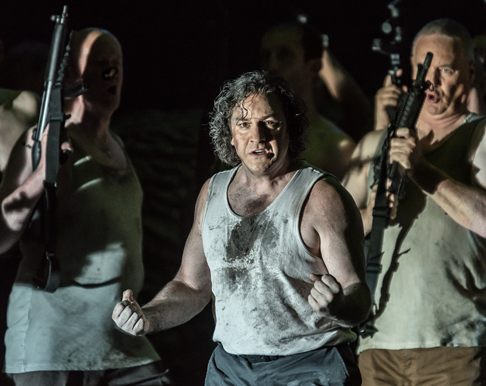 John Osborn as Arnold Melcthal
John Osborn as Arnold Melcthal
If Tell was rather world-weary at times, his son Jemmy bounced about in his knee-length trousers like a boisterous Hansel who’d strayed into the wrong opera. Sofia Fomina sang with fresh sweetness, but her caricature Jemmy was out of kilter with the general tone.
There were strong performances from the supporting cast. Enkelejda Shkosa was a convincing Hedwige, Tell’s wife; in the Act 4 trio in which she is reunited with her son, and in her premature aria of mourning for the husband she fears is dead, ‘Sauve Guillaume! Il meurt victime de son amour pour son pays’ (Save William! He died a victim of his love for his country), the Albanian mezzo-soprano showed that she is a genuine singing actress. Jette Parker Young Artist Samuel Dale Johnson was a confident, smooth-toned Leuthold and Michael Colvin’s rich lyrical tenor evoked the sinister cruelty of Rodolphe, Gelser’s commander. Nicolas Courjal’s Gesler is vivid, though perhaps a shade too close to becoming a comic-book sadist; but Courjal used the words and his black-hued bass effectively. Ruodi’s harp-accompanied fisherman’s song was delivered with a gentle lilt by Mikeldi Atxalandabaso, and Eric Halfvarson’s Malcthal senior had strong presence, once he’d got his rather wayward vibrato under control.
Given the dearth of dramatic drive on stage, Pappano worked hard to maintain the musical momentum. The overture was somewhat disappointing: the five solo cellos’ ‘Dawn Prelude’ was a little tentative and the trombones’ running scales in the Storm lagged behind the beat. But, things settled down and Pappano exploited Rossini’s emotive textures and colourings to the full. The horns, particularly, were on terrific form all night — heartily bombastic in the Act 2 huntsmen’s chorus — and there was finely nuanced playing from the woodwind complemented by accurate rapid passagework in the strings.
Rossini relies heavily on the chorus in this opera, but the Royal Opera Chorus gave an inconsistent performance. At their best — when the men of the three Swiss cantons swear to fight or die for the freedom of Switzerland at the close of Act 2 (when they were illuminated by the blinding gleam of revolutionary fervour), or in the triumphal choruses of Act 3 — they sang with vigour and heartiness; but the Act 1 choruses of young people and villagers were pretty lacklustre, and the chorus were persistently adrift of Pappano’s beat; almost irretrievably so in Act 4. It was perhaps not entirely the chorus’s fault that they failed to make a more dependable impact. Given that the stage was dominated by the fallen tree, there was barely room for them to stand, let alone move; and it was not clear why Michieletto thought that asking the down-at-heel Swiss rebels to remove their shirts, revealing their greying old vests, would enhance their image as valiant revolutionaries.
There is nothing very epic, heroic or spectacular about this Guillaume Tell. Michieletto misses the target by a mile, though the final image perhaps offers some consolation. The chorus sift through the soil rejoicing at the resurgence of their homeland and as the toppled tree is raised aloft, a young boy comes to the fore-stage and, in a bright spotlight, plants the sprigs of a sapling: the roots of a culture can never be entirely expunged. One must hope that the same is true for Covent Garden itself: that, as it continues in good musical health, new directorial roots will forge down into the achievements of the past and revived shoots will emerge.
Claire Seymour
Cast and production information:
Guillaume Tell: Gerald Finley, Arnold Melcthal: John Osborn, Mathilde: Malin Byström, Walter Furst: Alexander Vinogradov, Jemmy: Sofia Fomina, Hedwige: Enkelejda Shkosa , Gesler: Nicolas Courjal, Melcthal:Eric Halfvarson, Rodolphe:Michael Colvin, Leuthold: Samuel Dale Johnson, Ruodi: Enea Scala , Huntsman: Michael Lessiter; Director: Damiano Michieletto, Conductor:Antonio Pappano, Set designs: Paolo Fantin, Costume designs: Carla Teti, Lighting design: Alessandro Carletti, Royal Opera Chorus, Orchestra of the Royal Opera House. Royal Opera House, Covent Garden, London, Monday 29th June 2015.
image=http://www.operatoday.com/150623_1096-tell-2-adj-GERALD-FINLEY-AS-GUILLAUME-TELL-%28C%29-ROH.-PHOTOGRAPHER-CLIVE-BARDA.png image_description=Gerald Finley as Guillaume Tell [Photo: ROH / Clive Barda] product=yes product_title=Guillaume Tell, Covent Garden product_by=A review by Claire Seymour product_id=Above: Gerald Finley as Guillaume TellPhotos: ROH / Clive Barda
Sara Gartland Takes on Jenůfa
A few weeks ago, when I spoke with her by phone, she told me her story and why she thought she was ready to add this new role.
MN: Where did you grow up?
SG: I was born and grew up in a suburb of St. Paul, Minnesota. Both my mom and dad are from there. Even now, I’m the only one in the family who no longer lives in that area, although my parents spend winters in Florida. They come back for the summers, which, unfortunately, are no longer what they used to be. Now it rains more and does not get warm until August. We are lucky if we get one good week before the leaves begin to turn.
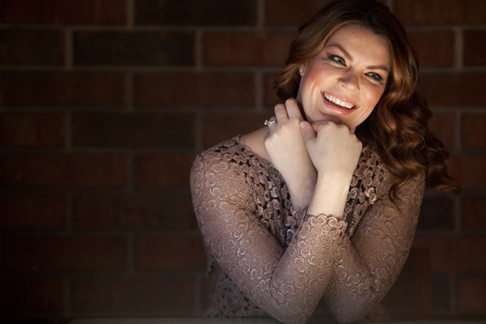 Sara Gartland [Photo by Marysol Flores]
Sara Gartland [Photo by Marysol Flores]
MN: Did you study piano?
SG: Yes, my mom had me take piano as a child and although I can’t play well enough to accompany myself, I can play chords and my vocal line. That was very helpful in college because I had to pass piano proficiency tests for both my bachelor and master’s degrees. I started voice lessons the summer before I entered high school. At that time I was participating in so many activities that my mom let me drop piano. Now I wish I had kept up those lessons because I would like to be better able to accompany myself.
MN: When did you see your first opera?
SG: I saw Bizet’s Carmen at Minnesota Opera when I was a senior in high school. I don’t remember the cast but I loved the dramatic staging. The action and music made a big impact on me. I still love Carmen. It has everything in it.
MN: Where did you go after high school?
SG: I did my undergrad work at the University of Wisconsin at Madison and my master’s degree at the University of Colorado at Boulder (CU). In 2004, when I had just finished my master’s, CU implemented an opera certificate degree. They accepted me into their program and I became the first official recipient of CU’s Professional Certificate in Opera and Solo Vocal Performance. For me it was a fine opportunity because I needed time to marinate and learn more about my voice. Eventually, I went on to become an Adler Fellow at San Francisco opera. The opera certificate program at CU was very helpful to me because I worked on refining my languages and learned many roles there.
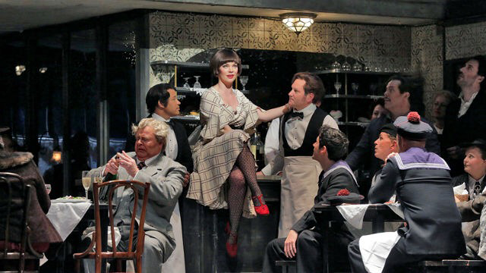 A scene from La bohème at San Diego Opera [Photo by Ken Howard]
A scene from La bohème at San Diego Opera [Photo by Ken Howard]
MN: What did you learn from your teachers that you would like to pass on to the next generation of singers?
SG: My current teacher, Anthony Manoli, talks about a suppressed yawn and deep, low, connected breath. My first teacher, Ilona Kombrink, taught this way as well. These concepts are fundamental to singing. Understanding breathing is of maximum importance. Singing should be as natural to a singer as crying is to a baby. Breathing for singing really is that simple. Babies don’t worry about being heard . . . and they most certainly are heard.
MN: How finished an artist should a young singer be when leaving school?
SG: Young singers need to know what they want from this career, and whom they trust with their instrument. The teacher is everything. Opera companies and Young Artist programs want to be able to plug them into existing holes in their programs. Most expect their young artists to be ready to perform onstage.
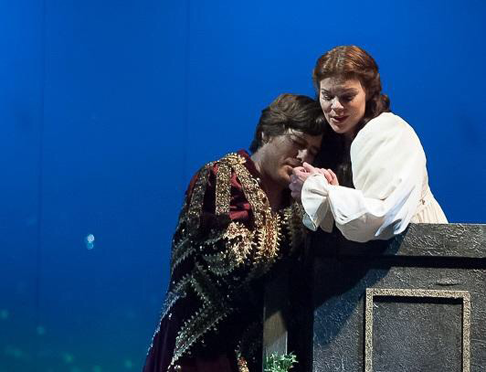 A scene from Roméo et Juliette at Des Moines Metro Opera
A scene from Roméo et Juliette at Des Moines Metro Opera
MN: Did you sing at Irene Dalis’s Opera San Jose?
SG: I did. I was most fortunate in the opportunities that were available to me. When I had completed the Adler program at San Francisco Opera (SFO), Maestro Joseph Marcheso who works at both SFO and at Opera San Jose, asked if I would be interested in singing Gretel in Hansel and Gretel. He had heard me when I was a cover in the SFO Nixon in China because he was the cover conductor for that production. I had already sung Gretel in German in college. Opera San Jose was presenting it in English and I relished the fact that I would learn it in my own language. The program at San Jose is fantastic and I loved my time there.
MN: Do you sometimes say no to a role because you don’t think it suits your voice?
SG: Not so far. Jenůfa, which I will be singing in July at Des Moines Metro Opera, is a change for me, but I don’t find it to be a problem. The music is incredible, and the Czech language feels so good to sing. It is really an Italianate language. Janáček wrote these beautiful verismo-like passages with dense orchestration. It is everything a singer wants in a role. The production, led by director Kristine McIntyre and conductor David Neely, is truly epic. They pay every possible attention to detail and drama. The cast, which includes Brenda Harris, Richard Cox, Joseph Dennis, and Joyce Castle, is phenomenal. It is going to be a real ride for the audiences at Des Moines Metro Opera this season.
MN: What is your interpretation of the title role?
SG: When approaching a role like this, I always focus on the language first. Speaking the Czech text and translating it helps the meaning and emotion sink in. Then I listen to every single recording I can find. Once I begin to learn the music, I take it to my teacher, Anthony Manoli, in New York City. He knows my voice and temperament, and he helps to mold and guide my vocal journey through every new character. A strong solid vocal technique is the key. With Tony’s technique and ears, I’m able to use my voice to communicate the composer’s musical intention without compromising my vocal integrity.
 Click here for information regarding Des Moines Metro Opera’s production of Leoš Janáček’s Jenůfa
Click here for information regarding Des Moines Metro Opera’s production of Leoš Janáček’s Jenůfa
image=http://www.operatoday.com/Gartland_01.png
image_description=Sara Gartland [Photo by Marysol Flores]
product=yes
product_title=Sara Gartland Takes on the Dramatic Role of Jenůfa
product_by=An interview by Maria Nockin
product_id=Above: Sara Gartland [Photo by Marysol Flores]
June 26, 2015
Aida, Opera Holland Park
But the wonderfully taut plot, tensions between public duty and private desire, strongly drawn characters and challenging music can provide a highly satisfying experience, especially as the leading roles are some of the most challenging and rewarding in the repertoire. Opera Holland Park has a track record for daring, producing operas which stretch the limited technical resources of their stage, so it was with great interest that I went along to the company’s very first production of Aida, which debuted on 24 June 2015. Daniel Slater directed, with designs by Robert Innes Hopkins and lighting by Tim Mascall, with Gweneth-Ann Jeffers as Aida, Peter Auty as Radames, Heather Shipp as Amneris, plus Graeme Broadbent as Ramfis, Jonathan Veira as Amonasro, Keel Watson as the King and Emily Blanch as a priestess. Manlio Benzi conducted the City of London Sinfonia.
Inevitably we could not expect pyramids, camels and large scale theatrical effects. But Daniel Slater’s production was certainly not without surprises. The basic set consisted of a museum-like using the Holland Park House façade as backdrop and with statues from Ancient Egypt in a museum display. During the prelude, the chorus in modern dress (dinner suits and long dresses) exploded onto the stage and the opening scene was a party. Clearly we were in a modern Kingdom, albeit one obsessed by the past as Radames was inducted as general by dressing him in Ancient Egyptian garb, and for much of the second half the populace were dressed in neo-Ancient Egyptian fancy dress. Aida was a cleaning lady, busy cleaning up after the party-goers. The production was secularised, with Ramfis becoming a rather nasty political fixer. But the production had more surprises for us, when the captured Ethiopians are brought on in a small huddle they were dressed as service workers - cleaning ladies, janitors etc. Were they real Ethiopian captives who had been dressed like that to demonstrate that they were unimportant, or was the war on invading ‘Ethiopians’ really a border war with illegal immigrants? It was never made clear, but I inclined to the latter. Whichever, the Egyptians were displayed as rather nasty, selfish and unsympathetic.
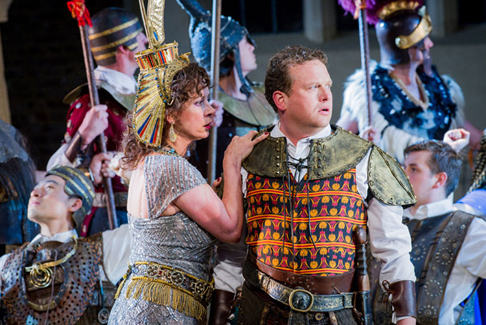 Heather Shipp as Amneris and Peter Auty as Radames
Heather Shipp as Amneris and Peter Auty as Radames
But the removal religion from the plot, and the modernisation of the milieu also removed an essential element from the plot, the tension between public duty and private desires. In Daniel Slater's production I was not clear what Radames meant when he says he is renouncing his duty to his country, certainly he seemed to be emptying his wallet? The end result was gripping theatre, but it wasn't quite the Aida that Verdi envisaged.
When staging the opera the biggest question is not where to set it, after all Verdi’s plot works in a whole variety of situations, but what to do with the triumph scene. Aida came between the grand French version of Don Carlos and the first Italian version of that opera, Don Carlo. In Aida, with its combination of intimate scenes, and a conflict between public duty and private emotional desires in the context of a grand historical narrative, Verdi would seem to have been interested in re-working the French grand opera form to suit the Italian stage. This means that the triumph scene functions very like some of the large scale historical scenes with ballets in French grand opera. Wherever you set it, it needs large forces to bring it off, and frankly a lot of the music is not top-notch Verdi. A logical step would seem to be to cut it, but no-one does. Daniel Slater and movement director Maxine Braham gave us an orgy like party scene in which the Egyptians seemed to over indulge in everything in celebration of their ‘triumph’ over the Ethiopians. It made dramatic sense, and the chorus was clearly having fun, but the scene went on far too long, yet it was clearly appreciated by most of the audience.
The production worked because Opera Holland Park had assembled a strong and balance team of soloists under conductor Manlio Benzi. Whatever you thought of the ideas behind the production, the musical values were very high indeed and Daniel Slater had drawn vibrant performances from all concerned.
Aida is rather a passive role, and one of Gweneth Ann Jeffers (many) strengths was that even before she sang a note she had conveyed much of the character’s interior life. Throughout the opera her face, eyes and body language were profoundly expressive and gave us real insight into Aida’s mental stress. Gweneth Ann Jeffers has a substantial, vibrant voice (previously she has sung La Gioconda, Leonora in La forza del destino and Santuzza at Opera Holland Park and she has performed Aida at a number of theatres including Finish National Opera), yet she was also able to spin a beautiful long line. The Nile scene was sung with real expressive finesse with some finely extended quiet high notes. Throughout there was this sense of line, combined with a vibrant, well filled feeling for Verdi’s phrasing. She and Peter Auty’s Radames developed a really intense relationship, again using eyes and body language well before they sang a note together. Both brought out the secure core of the underlying relationship, the ending was never in doubt. The final scene gave us some finely sinuous lines in Verdi’s glorious melodies, though Daniel Slater did not help matters here by making both of them fatally ill and having the scene performed crawling about the floor. This was one area where I felt that less would have been more.
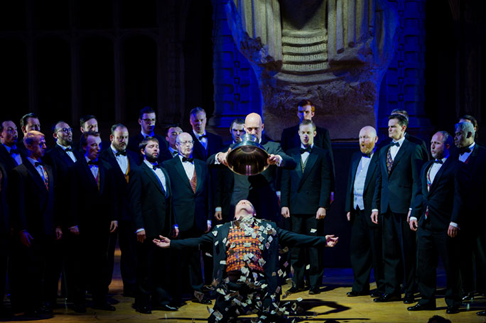 Graeme Broadbent as Ramfis and Peter Auty as Radames
Graeme Broadbent as Ramfis and Peter Auty as Radames
If I said that Peter Auty’s Radames was a good steady portrayal of the hero, making him solid and dependable, then though sounds unexciting then it must be set into context of a role which few tenors today can sing with any degree of credit. Peter Auty gave a robust account of Celeste Aida with a climax which was secure, and expressive even if a trifle louder than ideal. But once past this hurdle he developed in strength, intensity and a feeling of the heroic, this was no stand and deliver performance.
Heather Shipp was a powerful Amneris, combining a vibrant vocal performance with a highly musical personality. She was very much an Amneris who chewed the scenery, but did so with a musical sense too. The Act 2 scene with Aida, where Amneris tricks Aida into revealing she loves Radames, was particularly strong with the two singers making a balance pairing. And Heather Shipp’s performance revealed what we already knew, Amneris was a complete bitch goddess - attractive, powerful, power-dressed and vicious. Her wonderful final solo scene was superbly done, Heather Shipp really held the stage with her strong, vibrant voice and intense dramatic presence, but the effect was weakened by making Peter Auty’s Radames run around, fleeing from the priests. Another example of the feeling that Daniel Slater was over-egging the drama.
Jonathan Veira made highly sympathetic Amonasro, bringing intensity to the role but he seemed to want to punch each note out so that his performance though vibrant rather lost any sense of line. He and Gweneth-Ann Jeffers poignantly brought out the tension in their relationship.
Graeme Broadbent's Ramfis was a far stronger personality, far more involved in the drama than is sometimes the case and he turned in a wonderfully vivid, at times alarming portrayal of a nasty piece of work. Keel Watson brought his large voice to bear on the King to create a really larger than life musical personality.
Emily Blanch made a fine impression in the small role of the priestess, now reduced simply to a cabaret vamp, and Peter Davoren was the messenger in Act One.
The chorus (chorus master Nicholas Jenkins), with no extra dancers involved in the production, were hard working and delivered a really strong musical performance throughout, singing with strong, vividly focussed tone. Whilst I might have had doubts about the staging of the Triumph scene, the quality of the musical and dramatic performance from the chorus was never in doubt. In the men only sections of the opera, the male chorus made a fine, firm sound and had a nice line in threatening behaviour. The women were seductive in the extreme in their scenes.
I was slightly worried about balance at first, as Manlio Benzi seemed to encouraging a strong and colourful account of the score from the orchestra but this settled down after a while and we were able to sit back and enjoy a vibrantly dramatic account of the score.
Robert Hugill
Cast and production information:
Aida: Gweneth-Ann Jeffers, Radames: Peter Auty, Amneris: Heather Shipp, Ramfis: Graeme Broadbent, Amonasro: Jonathan Veira, the King: Keel Watson, priestess: Emily Blanch, messenger: Peter Davoren Conductor: Manlio Benzi with the City of London Sinfonia. Director: Daniel Slater, Designer: Robert Innes Hopkins, Lighting: Tim Mascall. Opera Holland Park, 24th June 2015.
image=http://www.operatoday.com/aida-ohp-054---Gweneth-Ann-Jeffers.png image_description=Gweneth-Ann Jeffers as Aida [Photo by Robert Workman] product=yes product_title=Aida, Opera Holland Park product_by=A review by Robert Hugill product_id=Above: Gweneth-Ann Jeffers as AidaPhotos by Robert Workman
Welsh National Opera explores Madness for autumn season
Madness descends upon Welsh National Opera for its autumn 2015 season, with three new productions that will explore human turmoil through some of the finest musical expressions of madness and the human condition.
The season launches WNO’s 70th birthday year which will see the company stage seven new productions over the course of the year — including two world premières — and a classic revival.
Press Release: Welsh National Opera explores Madness for autumn season
The season launches WNO’s 70th birthday year which will see the company stage seven new productions over the course of the year — including two world premières — and a classic revival.
Opening the autumn season is a new production of Bellini’s I puritani; the composer’s final opera and widely regarded as a bel canto masterpiece. Following the season theme, the heroine Elvira’s descent into madness inspired Bellini to create one of the most exquisitely refined musical portraits of insanity in opera.
I puritani will be directed by former WNO staff director Annilese Miskimmon, Artistic Director of Den Jyske Opera/Danish National Opera who are also co-producers. Following critical acclaim for both William Tell and Moses in Egypt with WNO, Carlo Rizzi returns to conduct I puritani, and celebrated bel canto tenor Barry Banks returns to sing Arturo. Rising Italian lyric soprano Rosa Feola will sing Elvira in Cardiff, Southampton and Bristol, with Linda Richardson singing the role for the remainder of WNO’s UK tour. David Kempster will sing Riccardo Forth and Wojtek Gierlach, Giorgio.
One of Handel’s greatest operas — Orlando — comes to WNO in a production that originated at Scottish Opera in 2011. It provides a fascinating insight into musical virtuosity as a metaphor for insanity as Orlando’s vertiginous descent into madness at the end of Act II is sublimely depicted through Handel’s music, balancing his inner suffering with fevered anguish to immense effect. Directed by Harry Fehr, Orlando will be set in 1940s London during World War II, providing a fitting backdrop to heighten the emotional impact of the story against the devastation of the Blitz.
Baroque virtuoso, Rinaldo Alessandrini will conduct the impressive cast which includes international countertenor Lawrence Zazzo in the lead role; his debut performance as Orlando. WNO welcomes back internationally-acclaimed Welsh soprano Rebecca Evans to sing Angelica. Fflur Wyn also returns to WNO following her performance in Autumn 2014’s William Tell to sing Dorinda. Robin Blaze and Daniel Grice will sing Medoro and Zoroastro.
The season is completed with Sondheim’s musical masterpiece, Sweeney Todd, which explores not only the madness of the protagonist but of society as a whole. This production promises a musical with all the emotional impact of opera and will be a rare opportunity to hear Sweeney Todd with the celebrated WNO Chorus and Orchestra. This production is set in the late 1970s/early 1980s and provides a fresh take on the story with echoes of Thatcher’s Britain.
A co-production between Welsh National Opera, Wales Millennium Centre and West Yorkshire Playhouse in association with Royal Exchange Theatre, Sweeney Todd will be directed by WYP Artistic Director James Brining and conducted by James Holmes in a staging adapted for WNO. This is the first time that WNO and Wales Millennium Centre have worked together as co-producers, and there will be an extra run of the production presented with Wales Millennium Centre following WNO’s autumn UK tour.
The cast will feature opera and musical theatre singers with German baritone David Arnsperger as Sweeney Todd and Scottish soprano Janis Kelly as Mrs Lovett. Anthony will be sung by Jamie Muscato, with Soraya Mafi singing Johanna. Welsh tenor Aled Hall will sing Beadle Bamford and Charlotte Page will sing Beggar Woman. Also joining the cast are Steven Page as Judge Turpin and George Ure as Tobias Ragg.
During the autumn season, WNO will be working with primary schools in Cardiff, Bristol, Oxford and Birmingham on The Sweeney Adventures. 330 pupils in total across the four cities will take place in workshops where they will use music and drama to explore the hardships faced in Victorian Britain for themselves; a key aspect of the KS2 history curriculum. The project is the third in a series of interactive adventures and follows on from the Tudors — Killing Cousins project in 2013 and My Perfect World in 2014.
Commenting on the season, WNO Artistic Director David Pountney says: “The paradox of music is that it is a highly rational means of expression, much more logically organised than the language of speech for instance, and yet it is at the same time the supreme means of expressing all kinds of extreme emotional states. Among these, madness has been a constant inspiration to composers eager to test the ability of music to penetrate the most radical states of mental disorder. Our season presents a fascinatingly wide range of musical expression dedicated to this phenomenon, from the virtuosic roulades of Handel, via the elegant refinement of Bellini to the raw craziness of Sondheim’s gruesome Barber.”
Wales Millennium Centre will also present WNO in a concert performance of Tosca on Monday 2 November featuring Bryn Terfel as Scarpia. Ainhoa Arteta will perform the title role with Teodor Ilincãi as Cavaradossi. The performance will form part of the finale of Wales Millennium Centre’s 10th anniversary celebrations.
Graeme Farrow, Artistic and Creative Director at Wales Millennium Centre says: “Working collaboratively with our resident partners has always played a fundamental role in our vision to becoming a world class Centre for the arts, and the many successes the Centre has achieved in its first 10 years have been reached with the support and expertise of our residents. It is our ambition in the years to come to create new work of exceptional quality that delights, surprises and impresses. Developing partnerships, within Wales and internationally, is essential in fulfilling this ambition, and it’s a privilege to be collaborating with Welsh National Opera with their inimitable reputation for producing exciting and ambitious opera.”
David Pountney adds: “We are delighted to join with Wales Millennium Centre to celebrate their 10th anniversary. The Centre is one of the finest purpose built opera houses in Europe, and its presence in Cardiff has transformed opera making for us, and opera going for people from Wales and far beyond. As such, it is an invaluable asset to Wales’ cultural portfolio, and a symbol of its aspiration to the highest levels of artistic expression and achievement.”
Following the autumn tour, WNO will present two performances of A Christmas Carol at Wales Millennium Centre in December; Iain Bell’s adaptation of Charles Dickens’ Christmas favourite. This seasonal show will be an opportunity to experience Bell’s work prior to the world première of In Parenthesis during WNO’s summer 2016 season. The one-man show will feature tenor Mark Le Brocq as Narrator alongside a chamber orchestra. Conducted by James Southall, the production will be directed by former WNO Genesis Assistant Director Polly Graham.
More information on WNO’s autumn 2015 season is available at wno.org.uk
image=http://www.operatoday.com/Wales_Millennium_Centre.png image_description=Wales Millennium Centre product=yes product_title=Press Release: Welsh National Opera explores Madness for autumn season product_by= product_id=Above: Wales Millennium CentreJune 25, 2015
A Chat with Pulitzer Prize Winning Composer Jennifer Higdon
The following year she won the Pulitzer Prize in Music for her violin concerto. On August 1, 2015, her opera, Cold Mountain, will have its world premiere at Santa Fe Opera. On June tenth, I phoned her for an interview to be published in Opera Today and was greeted by a friendly, “How ya doin?”
MN: Where are you from?
JH: I was born in Brooklyn but we moved to Atlanta, GA, when I was six months old. Later, we moved to Seymour, TN, near Knoxville. After high school I went to Bowling Green State University in Ohio where, during my last year of undergraduate work, Robert Spano led the university orchestra and I was allowed to study conducting with him. Although I did not see him for a number of years after that, he was the first to record one of my orchestral works. He is a great champion of contemporary music. I got my master’s degree and doctorate from the University of Pennsylvania. I also have an artist diploma from the Curtis Institute, which is a really great school. Currently, I occupy the Milton L. Rock Chair in Compositional Studies there.
MN: George Crumb is said to define music as "a system of proportions in the service of spiritual impulse." What did you learn from him at the University of Pennsylvania?
JH: I learned how to handle instruments and think beyond the norm. His extended techniques on the instruments are always unusual and sometimes unique. Examples of extended techniques might include bowing under the bridge of a string instrument, blowing into a wind instrument without a mouthpiece, or inserting objects on top of the strings of a piano. Crumb is very inventive and he made me think about color a great deal. Many of today’s listeners think of music in terms of its rhythm. That may be one of the reasons for the popularity of my music, which usually has a strong rhythm.
MN What do you play besides the flute and how do you handle composing for instruments you don’t play?
JH: I play the flute and a little bit of piano. You’re right, it’s not easy to write for the instruments I don’t play. (She adds with a knowing laugh). I have to be sure to learn a great deal about each instrument because I don’t play most of the instruments for which I am composing. It’s a pretty big thing.
MN: When did you start composing?
JH: I began during my undergrad days. I was about twenty years old and had been working on a performance degree for a couple of years. I know some people have started composing as children. I am a late bloomer who taught herself to play the flute at age fifteen. I did not begin to study music formally until I was eighteen and went off to college. At Curtis I was unusual. Most of the students had begun music lessons at the age of three or four.
MN: How did you meet violinist Hilary Hahn?
JH: She was in a class I taught entitled Twentieth Century Theory and Music History. It was a fun class to teach and a serious responsibility because the amount of material to be covered between 1900 and 1999 is enormous. The class is a requirement for all Curtis students.
MN: The end of the last century produced a great deal of dissonant music. Are we now returning to melody?
JH: Oh yeah! People are asking for more melodic music. My new opera, Cold Mountain, is definitely melodic.
MN: Do you have a routine for composing?
JH: I write every day. For two years while composing the opera, I wrote eight hours a day, seven days a week because I felt that was absolutely necessary. Writing an opera has been very different from composing symphonic or chamber music. It simply does not feel at all the same. I did not expect composing an opera to be that different, but I knew it was the minute I started working on it.
MN: How do you allow for individual differences among singers?
JH: It is really the same thing as writing the violin concerto for Hilary Hahn and then having other violinists play it. I just had to make the best possible guesses. Before I composed Cold Mountain I knew that Nathan Gunn would sing the leading part of Inman, but I did not know who would sing the other roles. Later, we selected the renowned Isabel Leonard to sing Ada and Emily Fons, who made a fine impression as Zerlina in the San Diego Opera Don Giovanni, to be Ruby. The Siegfried from the Met’s HD Ring Cycle, Jay Hunter Morris, will be the villain, Teague. Ticket sales for Cold Mountain have been impressive. The first two performances are already sold out.
MN: How did you come to work with Gene Scheer?
JH: When I realized that I was going to write an opera, I knew I needed to work with an experienced librettist. I asked a lot of people for recommendations and the consistent answer was Gene Scheer. We got together for lunch and within five or ten minutes I knew that he would be ideal. We connected. It was important because composer and librettist spend a lot of time discussing creative ideas. When you’re going to work with a person for a long time, it’s important to choose someone with whose personality you are comfortable.
MN: I’m told Cold Mountain has more than twenty scenes. How did you decide which parts of the book to use?
JH: We primarily followed the three main characters, Inman, the hero, Ada and Ruby. We searched for scenes that advanced the story and showed the changes that occurred to in those characters. An opera has to have strong roles. I just looked for situations that resonated with me. You live with an opera for a long time so you need to feel it. We also needed scenes that presented good musical possibilities. We both read the book over and over.
MN: Where does Cold Mountain go after Santa Fe?
JH: It goes to Opera Philadelphia, which will present it in February of 2016. Cold Mountain will be part of their American Repertoire Program, which is committed to produce an American work in each of ten consecutive seasons. It then goes to Minnesota Opera, which tentatively plans to stage the opera in its 2018-2019 season. It will be part of Minnesota Opera’s New Works Initiative. Many more companies have asked about it as well but nothing is firm enough to talk about yet. I expect that Cold Mountain will be recorded as well.
MN: What is next for you?
JH: I’ve already written six pieces since I finished the opera. I did a song cycle for Thomas Hampson that he premiered at Carnegie, and a viola concerto commissioned by the Library of Congress. I had a whole bunch of commissions stacked up. Right now, I’m writing a string orchestra piece for Nadja Salerno-Sonnenberg and her group, The New Century Chamber Orchestra. She will premiere it in San Francisco in early May 2016. I’m working on that right now. I’m also looking at subjects for another opera. I also have other pieces coming down the road so I have quite a bit on my plate. I have work lined up until 2020. I only teach two hours a week at Curtis so most of my time is spent composing.
MN: Do you have any stories about recent events?
JH: A couple of weeks ago the White House called me and left a message wishing me well for Cold Mountain. I get recognized now. Sometimes I get stopped on the street, which surprises me. One time when my wife, Cheryl, and I were in the Delta Airlines Lounge in Paris a kid came up to me and asked if I was the composer of the violin concerto that Hilary Hahn had just premiered.
MN: Do you have time for a private life?
JH: Cheryl and I like to watch movies and travel when we can. I have to admit I have so much going on right now that my career takes up most of our time. Once the work on the opera got going, everything else slowed down and I did far fewer residencies than usual. My life is really full and it’s lots of fun. I feel very fortunate that I get to make my living writing music. That’s sheer heaven.
image=http://www.operatoday.com/Higdon-Smile-1.png
image_description=Jennifer Higdon [Photo by J. Henry Fair]
product=yes
product_title=A Chat with Pulitzer Prize Winning Composer Jennifer Higdon
product_by=An interview by Maria Nockin
product_id=Above: Jennifer Higdon [Photo by J. Henry Fair]
June 23, 2015
Death in Venice, Garsington Opera
And yet, risks have been taken, with surprising and stimulating results. Yoshi Oida’s 2007 production is more Japanese minimalism than Venetian splendour, and when revived by Opera North at Snape in 2013, Tom Schenk’s set designs exploited the natural fabrics of the Snape Maltings Hall for which the production was designed. Deborah Warner’s 2007 ENO production, though the stage is largely bare, manages to suggest through movement and light both an exquisitely sumptuous décor and a melancholy barrenness of soul.
Kevin Knight’s designs for Paul Curran’s new production for Garsington Opera offer both orthodox Venetian motifs and striking abstraction. A sand-coloured floor curves up, like a wave in the lagoon, meeting a Turner-esque blue sky; upon the horizon, the familiar shoreline is intermittently projected. Bruno Poet’s lighting bathes the shore in golden sunbeams, then bleaches it with the pallor of sickness; the gleaming beauty of La Serenissima casts its heavenly illumination, before the dull shadows of canal-borne disease darken the hues.
The stage is bare; in place of set and props we have four billowy white curtains which intersect on the diagonal, wafting in the nascent scirocco humidity. These curtains serve to separate Aschenbach from reality, to trap him in the cold sterility of his intellect. Their whiteness is both the creative purity of Apollonian discipline and the emotional emptiness of a life repressed. They part to reveal the city and its inhabitants; they frame the gondola that bears him southwards; they close to prevent communication. So far, so good: but the ceaseless swishing back and forth of these drapes becomes rather tedious after two and a half hours. And sometimes the abstraction is imprecise or misleading. As Aschenbach strolls dejectedly amid the suburbs of an imagined Munich, the Traveller appears in an imagined cemetery; but, through the drifting chiffon we glimpse smartly dressed tourists promenading along the Venetian strand – is Aschenbach envisioning a journey that he does not yet know he will shortly undertake? The absence of a set also necessitates the never-ending carriage of esplanade benches, hotel sofas, anteroom palms and other paraphernalia to suggest the various locations in which Aschenbach’s demise unfolds.
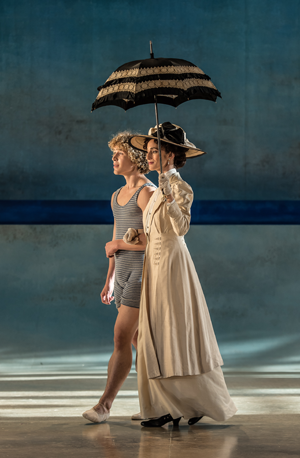 Celestin Boutin as Tadzio and Nina Goldman as Polish Mother
Celestin Boutin as Tadzio and Nina Goldman as Polish Mother
There’s a lot of to-ing and fro-ing. Indeed, movement takes centre-stage in this production, in which Curran and his choreographer Andreas Heise prioritise and supplement the opera’s dance episodes. The choreography for the five male dancers blends classical balletic grace with striking muscularity. The powerfully persuasive gestures draw just about everyone into the dance: Tadziu’s mother (Nina Goldman), governess (Georgie Rose Connolly), siblings (Minna Althaus and Poppy Frankel), even the strawberry seller (Emily Vine) are swept up in the athletic arabesques.
The set-pieces hook our attention but, in their erotic evocations, often go far beyond the allusion and suggestiveness of Myfanwy Piper’s libretto and Britten’s score. Apollo is no longer a disembodied voice, but rather appears in person, attired in golden cloak and laurel crown – both a deity of pure light and a dangerous sun-god – to oversee the Games which bear his name, and which are watched by a chorus of sinister Carnival-goers: harbingers of death, clad in black hooded cloaks and gold-leaf masks. Tom Verney’s countertenor is not a voice of ethereal purity or the honeyed mellifluousness of Elysium, but his unearthly cries certainly emphasise the ‘unnaturalness’ of the god’s pronouncements, sending a chill down the spine if not always complementing the beauty of the beach Games’ vigour. Here, Heise’s gestures drew directly and precisely upon the text: the running race was a frenetic tumult of ‘flashing forms’ and ‘working arms’; the dancers used astonishing elasticity to ‘spring high’ and ‘shoot forward’ in the long jump; ‘swinging up and back’, they swirled hypnotically in the discus. The tightly wound formations of the final game reached the height of erotic tension: ‘forehead to forehead/ fist to fist/ limbs coiled around limbs/ panting with strain’, they youthful competitors lifted Tadziu aloft, to the pervasive reverberations of harp, double bass, pizzicato cello, gong and tom tom.
These Games of Apollo anticipate Aschenbach’s subsequent Dionysian dream. Again, the gods do battle, not within the writer’s troubled psyche, but on the stage before us, as the revellers’ shrieks, ‘Aaoo!’, blend with the violently pulsing uproar of the drums and the terrible sweetness of the flute. Although Piper had initially noted that it would be necessary to ‘avoid the obviousness of the homosexual theme’, she later made the well-intentioned but somewhat naïve suggestion that during the second beach ballet the boys should be ‘really naked so as to remove the whole thing slightly from reality, as the whole of Aschenbach’s attitude is removed from reality’; Britten thought this was an excellent idea, which ‘could be wonderfully beautiful, Hellenically evocative’, but the plan was later, and perhaps fortunately, abandoned. Curran, however, follows Piper’s suggestion and the Dream ends with Tadziu being stripped of his sailor-suit by the carousing hordes, who caress and writhe around his naked legs. Hellenic evocation seems far from Curran’s mind in this Dionysian nightmare …
Even the Travelling Players’ suggestive lewdness is transformed into outright vulgarity, as four male dancers indulge in mock offensiveness, raising their skirts to expose their be-trousered behinds to the hotel guests, and engaging in faux sodomy.
The remarkable central energy in the production is Celestin Boutin’s mesmerising Tadziu. It’s impossible to state unequivocally how old Tadziu should be or look but, despite his blond curls – which, like some of the visual vignettes, seem to allude to the first performance by dancer Robert Huguenin to whom Peter Pears’s Aschenbach fell victim – Boutin’s physical maturity and strength, and sheer brazenness, foreground the physical over the spiritual. Mann’s text formulates a theory relating beauty to man’s spiritual and intellectual purity: beauty partakes in a higher reality, a world beyond corruption where the artist seeks to create his work. Boutin, however, is too physical to be god-like; not a statuesque divinity but a mortal tempter.
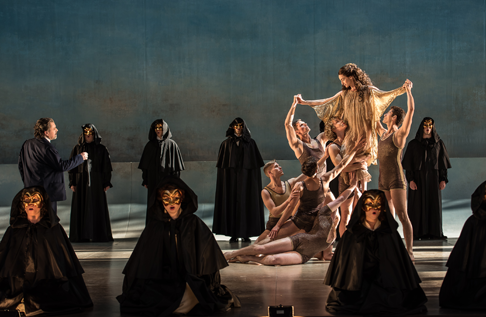 Paul Nilon (Aschenbach) with Company
Paul Nilon (Aschenbach) with Company
Boutin’s first entrance did convey a timeless immobility; the drums were silenced by the shimmering vibraphone as he stepped slowly across the stage, relishing the onlookers’ admiring gaze. Certainly, Britten and Piper suggest that Tadziu shares the incipient knowingness and coquetry of Miles in The Turn of the Screw; he is on the cusp of sexual awakening. But, Boutin boldly exults in the intensity of veneration. Moreover, by making Tadziu mute, Britten suggests that any communication and consummation between Aschenbach and the Polish boy is impossible: he is not a ‘real’ boy, but an idealization. In Curran’s vision, though, Tadziu’s allure is all too ‘flesh-and-blood’. The score’s invitational glances become physical advances, most notably at the end of Act 1 as the boy reaches out to brush the straining fingertips of the infatuated Aschenbach.
In the title role, Paul Nilon presents an astonishingly powerful portrait of physical and moral decline. Nilon’s tenor is dark-coloured and plangent, and he delivers the writer’s self-castigating monologues with unwavering dramatic focus, smoothing over the florid verbosity of Piper’s lengthy, high-falutin monologues with their heavy-handed symbolism and indulgent Hellenic philosophising. Every word is clearly enunciated and the free recitatives are thoughtfully phrased.
Nilon’s Aschenbach is the embodiment of emotional anguish – and, surprisingly animated, swinging wildly from joy to despair. The self-restraint of the opening moments is quickly swept away by fatal passion; this Aschenbach does not languish in the hinterland, wearied and depleted by his self-consuming devotion, but endeavours to engage directly with the object of his adoration. Denied, by a hair’s breadth, the ecstasy of physical touch at the end of Act 1, his howl, ‘I – love you’, drains into a desperate sob: the moral and artistic discipline which have upheld his entire life have been brutally shattered by self-honesty, as foreshadowed by the Traveller at the start of the Act, when he tears and scatters the pages of the esteemed writer’s book before throwing the latter disparagingly to the ground. In Act 2 Nilon’s decline is rapid and disturbingly palpable; and it is enhanced by the potent lighting design as Poet takes advantage of the looming darkness, conjuring volatile shadows which convey the protagonist’s fragmentation and torment. After his visit to the barber, Aschenbach abandons all pretence, clutching frenetically at the alarmed hotel guests as they prepare to depart, seemingly indifferent to his own humiliation and disgrace.
William Dazeley is excellent in the composite role of the Traveller-Elderly Fop-Gondolier-Hotel Manager-Barber-Leader of the Players-Dionysus, metamorphosing between these disparate incarnations with sinister ease. Dazeley’s bass may not quite be sufficiently deep-toned for the Hadean Gondolier, but he was firm-voiced and authoritative as the mysterious Traveller and bright and energised as the Hotel Manager, transforming his voice skilfully. The falsetto of the Leader of the Players and the Barber eerie echoed the Elderly Fop of Act 1, confirming the compound figure’s role as a deathly herald.
In the minor roles, baritone Henry Manning was a fine English Clerk/Youth, announcing the arrival of the cholera with clarity, while tenor Joshua Owen Mills was a confident, bright-voiced Hotel Porter. The Garsington Chorus was superb, suavely embodying the European clientele at the Lido Hotel and forming an impassioned band of Dionysian followers. As hawkers and beggars, they straggled along the esplanade, pestering and troubling the protagonist; as youthful travellers, they soothingly crooned the Serenissima theme.
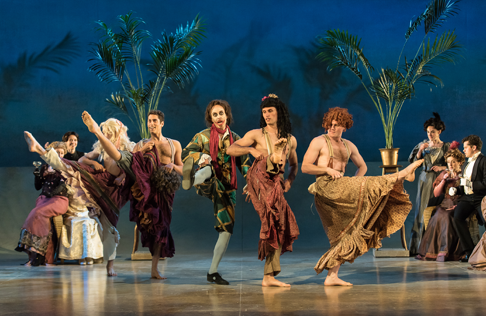 William Dazeley (Leader of the Players) with Company
William Dazeley (Leader of the Players) with Company
Undoubtedly, the coherence and impact of this production owes much to conductor Steuart Bedford. Bedford conducted the first performance of the opera at the Aldeburgh Festival on 16th June 1973, and the passing of forty-two years has only served to strengthen his appreciation of the role of precise motivic and timbral details within the overall structure, and of the musical and narrative trajectory of the work. We heard every instrumental detail, the Garsington Opera Orchestra playing with intensity and precision. Flamboyant harp glissandi, throbbing timpani outbursts, the dark rumbles of the tuba, penetrating string lines and eloquent woodwind solos created a concentrated sound-world which drew us into the evolving psycho-drama. But there was warmth too, as when the ‘view theme’ expanded with a softening gleam.
Some productions err on the side of ambiguity and elusiveness, the suggestive exoticism of the score counterbalanced by the text’s Platonic theorising. For, while one might suggest that in Death in Venice Britten located an explicit account of the energies which had for so long been strong undercurrents in his operas, there remains an evasive mist and there is little direct disclosure in Piper’s libretto.
But Curran doesn’t hedge his bets – the forces released when Aschenbach opens the heart which has for so long been imprisoned by artistic discipline and repressive self-respect are dark and deadly. When Britten was composing Death in Venice – during which time he was suffering from acute heart arrhythmia – Peter Pears is reported to have told the Australian painter, Sidney Nolan: ‘Ben is writing an evil opera, and it’s killing him!’ And, Curran presents us with what Ronald Duncan called ‘the public revelation of a private agony’; the danger Duncan foresaw when ‘imagination and reality become fused and identified’ is painfully played out. The final image is a disquieting master-stroke: lured by the enticing silhouette of Tadziu visible through the gauzy white hanging, Aschenbach leans forward, arms outstretched – but, at the moment that it seems their hands might at last touch, the lighting abruptly switches, the profile fades and all that remains for Aschenbach is his own lurching shadow.
Aschenbach had hoped, ‘The power of beauty sets me free’. In the event, it is Socrates whose words prove more germane: ‘beauty leads to passion, and passion to the abyss’. Curran seems to be urging us to ask, as did Peter Pears[1], if the pursuit of beauty and love must always lead only to chaos?
Claire Seymour
Cast and production information:
Gustav von Aschenbach, Paul Nilon; The Traveller, William Dazeley; The Voice of Apollo, Tom Verney; Hotel Porter, Joshua Owen Mills; English Clerk, Henry Manning; Polish Mother, Nina Goldman; Tadzio, Celestin Boutin; Governess, Georgie Rose Connolly; Jaschiu, Chris Agius Darmanin; Conductor, Steuart Bedford; Director, Paul Curran; Designer, Kevin Knight; Lighting Designer, Bruno Poet; Choreographer, Andreas Heise;Garsington Opera Orchestra and Chorus; Parsifal James Hurst, Garth Johnson, Alexandre Gilbert, Ygal Jerome Tsur (Dancers). Garsington Opera at Wormsley, Buckinghamshire, Sunday 21st June 2015.
image=http://www.operatoday.com/150618_0135-deathinvenice-adj.png image_description=William Dazeley as the Old Gondolier and Paul Nilon as Aschenbach [Photo by Clive Barda] product=yes product_title=Death in Venice, Garsington Opera product_by=A review by Claire Seymour product_id=Above: William Dazeley as the Old Gondolier and Paul Nilon as AschenbachPhotos by Clive Barda
June 22, 2015
La Rondine Swoops Into St. Louis
Tosca, Boheme, and Butterfly may be the bread-and-butter operas, but La Rondine can prove to be a highly satisfying sorbet, a lighter weight dalliance that nonetheless has its share of memorable melodies. Witness that during the first act intermission, the audience was mingling humming Doretta’s Song, almost against its will. After Act Two the line at the bar was having a go at the famous ‘Ohrworm’ from the quartet. Giacomo could sure write a tune! What he couldn’t do in this case, was make up for the fact that in Giuseppe Adami’s libretto, nothing much really happens.
No Japanese honor suicides, no offing of villainous police chiefs, no worrisome consumptive coughing, nada. All we have here is a bored demimondaine who decides to go slumming at a lower class Parisian bar, falls instantly in love with a young visitor, chucks all the wealth to be with him, but then pretty much gets bored again and leaves him flat. Now Puccini himself made a good deal out of a similar scenario in the youthful Manon Lescaut, which bristles with passion. But in La Rondine there is really nothing at stake.
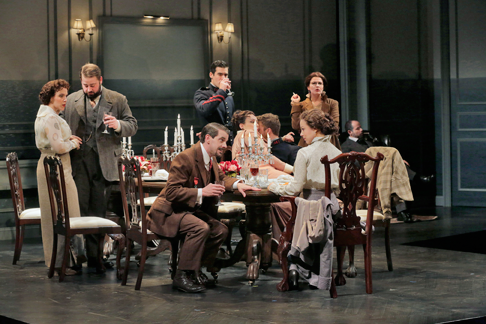 John McVeigh as Prunier and Corinne Winters as Magda
John McVeigh as Prunier and Corinne Winters as Magda
That puts a heavy burden on the performers to flesh out the consequences of their decisions and make you “feel their pain.” And to a large extent director Michael Gieleta and his accomplished cast and collaborators did just that.
Set Designer Alexander Dodge has created a marvel of a paneled box set drawing room, that at once evokes the confines of the Parisian salon where the story begins, and the freedom of the Nice seaside, where it ends. This is accomplished by an overall blue hue, with the bottom five feet or so subtly textured to resemble the sea. Gieleta and Dodge further choose to begin each act with a pre-set beach chair down center (soon struck) to presage the final act (when more chairs are added). The upstage “wall” is mostly a curtain, which pulls to reveal a platform that first contains Bullier’s tavern in Act Two, and then becomes a boardwalk and row of cabanas in Act Three. Very effective and attractive playing spaces, all.
Mr. Gieleta moves his forces about these environments exceedingly well. With the salon being dominated by a massive dining table, he invents any number of clever stage pictures while always maintaining good focus. I liked rolling in the piano from stage right when it is required for Doretta’s Song. In Two, the revelers vary between being contained on the tavern platform, or spilling onto the street which gets decorated with poles and strings of beer garden light bulbs as part of the action.
By Act Three, I began to fully appreciate the levels that Mr. Dodge created with not only the upstage platform, but by having the downstage drop off right and left of a central platform, to give three different heights. The director took full advantage of the possibilities, to include having Magda change clothes in her boudoir on the lower right level before dashing out on the town.
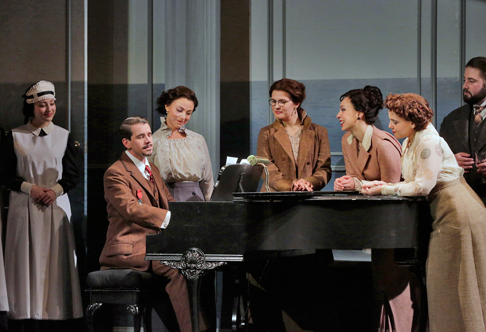 John McVeigh as Prunier, Corinne Winters as Magda, Ashley Milanese as Yvette, Elizabeth Sutphen as Bianca, and Hannah Hagerty as Suzy
John McVeigh as Prunier, Corinne Winters as Magda, Ashley Milanese as Yvette, Elizabeth Sutphen as Bianca, and Hannah Hagerty as Suzy
Gregory Gale contributed truly sumptuous costumes for the rich guests in the first act, then took it down a notch with colorful middle class street wear (and soldiers’ uniforms) in the Second Act. His casual beachwear in Three was simple and comfortable. This was beautifully detailed work. Only one thing bothered me and that was that Magda’s “simple black dress” that she wears out on the town kept parting in the front revealing her bloomers. Intentional? Hmm.
Christopher Akerlind made some bold lighting choices, with sharp rectangular specials, moody washes, and heightened, almost abstract atmospheres. It did inject a rhythm and visual excitement missing from the story. Tom Watson’s hair and make-up design was exceptional in delineating classes and temperaments.
Veteran Stephen Lord conducted a knowing, stylistically comfortable reading, and the musicians responded with generous playing that made them sound more lush and imposing than their numbers might imply. His communication with the singers was sensitive and the show breathed and surged as Puccini must. Maestro Lord also had a keen sense of pace and I was especially appreciative that he did not let the singers get too indulgent in the lovely, but repetitive quartet.
The chorus of Gerdine Young Artists performed superbly as trained by Chorus Master Robert Ainsley. Puccini has filled out much of the first two acts with choral effects, and they all made their impression. If you would take the time to look at the cast list, please realize that once you are past the first five names, all of the rest of the featured roles were taken with laudable and applaudable results, by members of the Gerdine Young Artists. These promising, talented singers covered themselves in glory the whole night., and they remain the heart of OTSL.
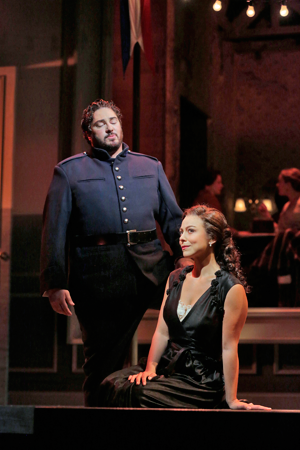 Anthony Kalil as Ruggero and Corinne Winters as Magda
Anthony Kalil as Ruggero and Corinne Winters as Magda
Matthew Burns brought admirable suavity and a bit of gravitas to Rambaldo’s scolding and blathering. As Lisette, the animated Sydney Mancasola was a delight, and her well-focused flights of fancy fell easily on the ear. Her enchanting portrayal was exceedingly well sung. John McVeigh, as Prunier, threatened to walk away with the show. Arguably the most complete characterization on the stage, McVeigh put his playboy good looks in service of creating a most lovable cad. John also sang with real refinement, his honeyed tenor encompassing all of the role’s demands.
Tenor Anthony Kalil is a big tall bear, a physical trait that might naturally work better for a bumbling-but-lovable Nemorino than for an OMG-love-at-first-sight Ruggero. That said, Mr. Kalil has an impressive, incisive tenor instrument. His ringing sounds filled theatre with real Puccinian squillo. His future seems assuredly bright.
Corinne Winters has all the necessary attributes for Magda. She is lovely and elegant. Her soprano can soar with the best of them, and her intelligence and attention to detail are second to none. Her seamless vocal production seems to have darkened just a bit since last I heard her, making her lower middle more forward placed. This resulted in some loss of diction in that range, especially when sustained banks of strings were playing. Ms. Winters made Doretta’s Song the showpiece it must be, and sang with luster throughout.
Whether it was her choice or the director’s, I found it hard to warm to her until well into Act Two. For all its vocal virtues, her Magda seemed too arch, too above it all. It improved and Corinne and Anthony sang the final scene very well indeed. But, while every phrase was well calculated, and every effect wholeheartedly attempted, I was longing for some real chemistry, some emotional connection, rather than two marvelous performers singing beautifully to the back wall. Both of these artists could deliver that real heartbreak with just a modest change in blocking and focus.
Everything about La Rondine was first class, and I greatly admired it. But I wanted to be touched by it. Truth in reporting, the audience received it rapturously.
James Sohre
Cast and production information:
Magda: Corinne Winters; Lisette: Sydney Mancasola; Ruggero: Anthony Kalil; Prunier: John McVeigh; Rambaldo: Matthew Burns; Suzy: Hannah Hagerty; Yvette: Ashley Milanese; Bianca: Elizabeth Sutphen; Gobin: Joshua Wheeker; Crébillon: Erik Van Heyningen; Périchaud: Luis Alejandro Orozco; Butler/Major Domo: David Leigh; Adolfo: Charles Sy; Rabonnier: Josh Quinn; Two Singers: Liv Redpath, Joshua Blue; Two Young Women: Jessica Faselt, Stephanie Sanchez; Grisettes: Anna Dugan, Lilla Heinrich Szász, Ann Toomey; Student: Todd Barnhill; Conductor: Stephen Lord; Director: Michael Gieleta; Set Design: Alexander Dodge; Costume Design: Gregory Gale; Lighting Design: Christopher Akerlind; Wig and Make-up Design: Tom Watson; Chorus Master: Robert Ainsley
image=http://www.operatoday.com/Rondine15.png
image_description=Corinne Winters as Magda and Anthony Kalil as Ruggero [Photo © Ken Howard]
product=yes
product_title=La Rondine Swoops Into St. Louis
product_by=A review by James Sohre
product_id=Above: Corinne Winters as Magda and Anthony Kalil as Ruggero
Photos © Ken Howard
Emmeline a Stunner in Saint Louis
Celebrating its fortieth anniversary, OTSL’s current season has favored us with a stunning new production of a late 20th Century masterpiece, Emmeline by composer Tobias Picker and librettist J.D. McClatchy. The piece was commissioned by Santa Fe Opera where it premiered in 1996. Having garnered glowing reviews and international attention, Emmeline was mounted to similar acclaim at New York City Opera in 1998. And then, like Evita’s corpse, it inexplicably disappeared. . .
Or almost. There was a scattering of scaled back performances, but the current revival is the first major full scale production in seventeen years. I would hope that the persuasive performance I experienced in the Gateway City might inspire other companies to similarly embrace its manifold riches.
First, Mr. Picker has fashioned an accessible, melodic score that nonetheless crackles with contemporary musical commentary and post-modern invention. The orchestral writing is lush one moment with undulating layers of overlapping neo-romantic strings, then jagged and impulsive the next with jittery winds skittering nervously above and around a cantus firmus.
Folk melodies are hinted at, although only Rock of Ages is a real quote and at that, it is ornamented with a disturbing subtext, a parody of a rather hysterical country fiddle. When tragedy looms there is an imposing, heart-sickening stretch of ominous themes intoned in quadruple (quintuple?) octaves that pierces the soul.
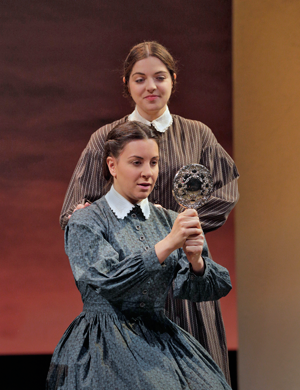 Nicole Haslett as Sophie and Joyce El-Khoury as Emmeline Mosher
Nicole Haslett as Sophie and Joyce El-Khoury as Emmeline Mosher
Best of all, this is Picker’s most accomplished vocal writing. Mr. McClatchy’s lean, mean libretto has nary a false move, and the composer responds with appealing, straight forward declamations that are natural yet pleasing to the ear and appropriate to the situation. When things get more heated, the composer uses the text as a springboard to craft escalating lines of arching intensity, mounting musical tension, and cataclysmic dramatic resolution.
In later operas (An American Tragedy, Dolores Claiborne) I sometimes felt Picker occasionally unnecessarily taxed the vocalist to, and sometimes beyond their limits. Not so here. Every phrase of Emmeline seemed apt, inevitable, and well considered.
In the pit, George Manahan commanded a compelling reading that found every soaring statement, every telling nuance in place. The Maestro elicited superb colors from his band and found an unerring balance with the stage. He ably partnered the drama at every moment, nay, he prodded it forward, in a thrilling reading that was by turns edgy, serene, searing, soaring, contemplative, and bombastic. Mr. Manahan has a reputation for drawing inspired work from instrumentalists and vocalists in such “new” works, and he united his forces in a spellbinding ensemble.
The title role is a tour de force for a soprano, and the original Emmeline, Patricia Racette found her career kicked into high gear with her Santa Fe success. I have no doubt the same should happen with the current star Joyce El-Khoury. She is luminous in the part. (Ms. Racette was in attendance opening night at OTSL to cheer on her successor.)
Ms. El-Khoury had it all. She is possessed of a substantial lyric voice that has spinto leanings. Her sound technique allows her to encompass every diverse requirement of the score. She has an attractive and appealing stage presence, and her stage savvy allowed her to completely immerse herself in the emotional journey of the unfortunate girl. And oh, the things she is called upon to communicate!
Emmeline is first used by her poor family. She must leave home and become the bread winner by working in a de-humanizing mill. When her loneliness leads her to become impregnated by her married employer, the family derides her. She never sees the child that is taken from her at birth. She matures into an aloof caretaker of her ineffectual parents, but then a young man unexpectedly enters her life, and they eventually marry. Emmeline soon discovers in horror that she has had an incestuous relationship with the son she had never known. Abandoned, she remains resolutely steadfast in her motherly love for her son. Such is the stuff of great tragedy.
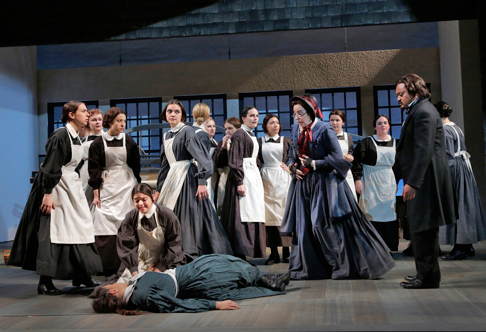 Nicole Haslett as Sophie, Joyce El-Khoury as Emmeline Mosher, Renee Rapier as Mrs. Bass, and Geoffrey Agpalo as Hooker
Nicole Haslett as Sophie, Joyce El-Khoury as Emmeline Mosher, Renee Rapier as Mrs. Bass, and Geoffrey Agpalo as Hooker
This dramatic evolution afforded ample opportunity for Ms. El-Khoury to regale us with the full gamut of a singers arsenal: gleaming phrases poured out above the staff, invectives hurled with fire and conviction, plangent utterances of despair, melting professions of radiant romantic happiness, and introspective pianissimo singing that touched the soul. Joyce El-Khoury’s Emmeline is the gold standard against which all future interpreters will be measured.
As her strapping son Matthew Gurney, tenor John Irvin was appealingly boyish and irresistibly charming. He used his secure, brightly focused lyric tenor to create a most engaging portrait. Mr. Gurney exhibited a fearless precision as he executed each and every high-flying outburst that the composer devised for the impassioned lad (some seemed scored where only dogs can hear!), while also commanding a warm and appealing sweetness as the situation required.
Meredith Arwady as the manipulating and judgmental Aunt Hannah proved once again to be a force of nature. I have always admired her, but this is her very best work to date. The part is tailor-made to her gifts, which includes those rock solid, sternum rumbling chest tones. Ms. Arwady’s top voice, on this occasion, was just as thrilling. It glistened with laser intensity. The voice is a seamless whole, and this performance may be one of those magic occasions where you have witnessed a major singer hitting the very top of her game.
Wayne Tigges is always a reliable and conscientious performer, and he does not disappoint as the seducer Mr. Maguire. Like Cornell MacNeil, he has such an imposing, steely instrument that I am always surprised by his ability to suddenly change gears to apply a sudden supple use of vocal colors and shading. The role lies high for him (or anyone else), but Mr. Tigges negotiated the angular leaps with skill, even if his baritone can tend to a bit of unruliness approaching the passaggio.
The entire ensemble cast proved to be of the highest standard. Renée Rapier made her mark as Mrs. Bass, the school-marmish owner of the boarding house. Ms. Rapier sang with clarity and finesse, and communicated a completely realized character (thanks in part to Tom Watson’s effective wig and make-up design). Mill girl Sophie was assumed by Nicole Haslett who sported a shining, fresh soprano in a fiery and sympathetic performance. She was complemented by a nice turn from Lilla Heinrich Szász as millworker Ella, who offered a limpid, pure vocal characterization.
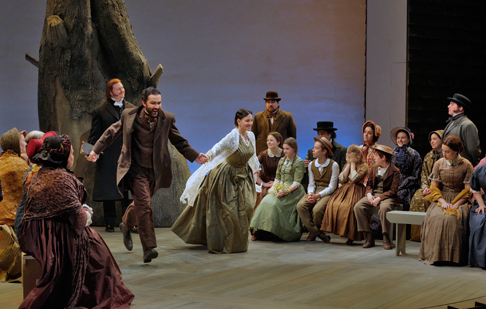 John Irvin as Matthew Gurney and Joyce El-Khoury as Emmeline Mosher
John Irvin as Matthew Gurney and Joyce El-Khoury as Emmeline Mosher
As the mean-spirited sister Harriet, Felicia Moore was every inch the woman-we-love-to-hate. Her solid singing was tinged with spite and provocation. Pastor Avery was well-served by Daniel Brevik’s ample bass. Erik Van Heyningen’s pleasing baritone shone in the brief phrases allotted to Simon Fenton. Matthew Lau’s characterful baritone struck just the right note as the hapless father Mosher. As Hooker (the factory foreman, not a lady of the night) Gerdine Young Artist Geoffrey Agpalo just flat out nailed the part, as much for assured temperament as for spot-on stratospheric outbursts of steely tenor tone. Mr. Agpalo won a deserved ovation at curtain call for his impressive contribution.
In fact, the afore-mentioned supporting cast was peopled with former and current members of the Gerdine Young Artist Program, one of the company’s glories and a major training ground for performers who often move on to world-wide careers.
An episodic, highly theatrical piece like Emmeline is red meat to director James Robinson, who excels in making riveting, poetic theatre from such source material. Allen Moyer’s well-chosen set pieces were spare and evocative. The paucity of stage clutter suggested the limited means of the characters and the dehumanization of the industrial revolution (the three imposing looms were awesome!).
The company’s new turntable was immediately justified as a worthwhile purchase as Mssrs. Robinson and Moyer put it to effective use beginning with the opening reveal of the family gathered at a funeral. As cast and scenery spun into different positions the effect not only suggested a cinematic cross-fade, but also visualized the shifting emotional states of the leading character. Christopher Akerlind’s haunting lighting design perfectly captured the expansiveness of the bucolic milieu as well is the claustrophobia of societal pressures. James Schuette’s masterful costumes did much to establish time, place and character. The subtle color difference that sets Emmeline apart from the other mill girls in their work dresses is only one of many lovely touches.
But ultimately, it was Robinson’s vision that made Emmeline come leaping to vibrant life on the stage. He ensured that every moment was truthful and focused. His stage pictures evolved naturally. Each transition was carefully choreographed to keep moving the story forward. One beautiful touch was to have Matthew and Emmeline circle the stage and walk past each other repetitiously, pausing to flirt, as the passage of time (and their developing love) was indicated by the yearning orchestral passages.
If there is a better case to be made for the tragedy of poor Emmeline, well, I am not sure my heart could stand it. Opera Theatre of Saint Louis has delivered another definitive performance, one that is a perfect fit for the intimate Loretto Hilton theatre. Is there any space more congenial to experience the immediacy and import of a riveting operatic performance?
Forget about the Arch. Forget about the Cardinals. Emmeline is currently “the” reason to visit Saint Louis.
James Sohre
Cast and production information:
Emmeline Mosher: Joyce El-Khoury; Aunt Hannah Watkins: Meredith Arwady; Matthew Gurney: John Irvin; Mr. Maguire: Wayne Tigges; Sophie: Nicole Haslett; Harriet Mosher: Felicia Moore; Mrs. Bass: Renée Rapier; Pastor Avery: Daniel Brevik; Hooker: Geoffrey Agpalo; Henry Mosher: Matthew Lau; Townswomen 1, 2, 3: Anna Dugan, Ashley Milanese, Kelsey Lauritano; Simon Fenton: Erik Van Heyningen; Ella Burling: Lilla Heinrich Szász; Conductor: George Manahan; Director: James Robinson; Set Design: Allen Moyer; Costume Design: James Schuette; Lighting Design: Christopher Akerlind; Wig and Make-up Design: Tom Watson; Chorus Master: Robert Ainsley
image=http://www.operatoday.com/EMM_1699a.png
image_description=John Irvin as Matthew Gurney and Joyce El-Khoury as Emmeline Mosher [Photo © Ken Howard]
product=yes
product_title=Emmeline a Stunner in Saint Louis
product_by=A review by James Sohre
product_id=Above: John Irvin as Matthew Gurney and Joyce El-Khoury as Emmeline Mosher
Photos © Ken Howard
Luminous Handel in Saint Louis
Remarkably, George Friedrich Handel’s 1727 opera Richard the Lionheart (Riccardo Primo) is receiving its US premiere in this 40th Anniversary season in a felicitous and eminently singable English translation OTSL commissioned for the occasion from Lee Blakely and Damian Thantrey.
I am not sure what the rest of the opera world is doing for virtuosic singers this month since they all seem to have converged on the stage of the Loretto Hilton Theatre for this memorable production. OTSL has assembled a brilliant cast of vocalists that more than meets the interpretive challenges of this rich and diverse Handelian score.
In the title role, counter tenor Tim Mead is a revelation. His is a major operatic talent. His pliable, meaty vocal gifts are wedded to a trip hammer technique that not only accommodates unimaginable rapid-fire delivery, but can also bend to the requirements of limpid, bel canto singing of the first rank. As an interpreter, he is meticulously stylish but also quite fearless.
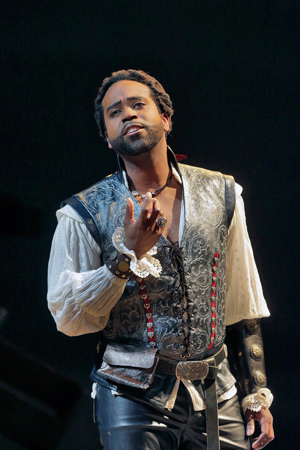 Tai Oney as Oronte
Tai Oney as Oronte
Mr. Mead’s take-no-prisoners presentation of his Act One closing aria was one of the most exciting, raw moments I have experienced in many a day. He is a consummate technician, to be sure, but Tim also takes risks. He lets it all hang out. His abandoned emotional investment in the moment worked the audience into a cheering frenzy at curtain. Later, he paired with Costanza in a languid, extended duet of romantic lyricism that bordered on the erotic. With this totally winning traversal of Handel’s Richard, Tim Mead has served notice that he is a new star in the operatic firmament.
As Costanza, Susannah Biller was every bit his equal. Having only ever experienced her accomplished Adina in last summer’s Elixir of Love I had no idea that she was capable of such depth and daring. As one of the “dueling divas of the day” in this opus, the role of Costanza has much of the pained, limpid, melancholy singing at which Ms. Biller certainly excels. But there is much more in reserve in her arsenal.
When real spunk and fire are required, she can deliver the goods with astonishing results, refulgent tone, and apparent ease. The duet I already mentioned was a highpoint, the emotional and musical core of the production. But Susannah also made the most of her opportunities to shock and awe with confrontational outbursts when her soprano found even more delicious fullness.
Her rival (and “diva challenger”) Pulcheria was no demurring seconda donna, no. Devon Guthrie took the stage with consummate professionalism and knocked our socks off with pyrotechnical vocal displays that make the New Year’s Eve fireworks in Sydney Harbor pale in comparison. And while we were sitting there duly dazzled, Ms. Guthrie changed gears and showed an effortless affinity for comedy and dramatic commitment alike. Her aggressive, flashy soprano reminds me of the colorful Simone Kermes, without the eccentricity.
I can remember a time in a galaxy far away when the world’s counter tenor roster began and ended with Paul Esswood. How times have changed. It is a case of an embarrassment of riches that the Richard the Lionheart cast list also includes the likes of countertenor Tai Oney as Oronte. Mr. Oney sports a sound technique and spotless coloratura delivery, but what I especially liked was his personalized, dusky timbre. His handsome bearing is icing on the cake of such distinctive artistry.
 Susannah Biller as Costanza and Devon Guthrie as Pulcheria
Susannah Biller as Costanza and Devon Guthrie as Pulcheria
Brandon Cedel excels as the calculating Isacio, his virile, resonant baritone rolling out effortlessly through the house. Mr. Cedel is a skilled villain and his poised vocalism made us love him in spite of himself. This is a gorgeous, mellifluous instrument. Even in the least flashy role of Berardo, Adam Lau makes a substantial impact with his full throated, robust baritone. He is one of the most sympathetic characters in the opera, and his vocal performance was emphatically in a league with his colleagues.
The physical production was a thing of sublime achievement. Jean-Marc Puissant has devised sets and costumes that give significant pleasure. I loved the simplicity of the raked platform with the textured ground cloth. I loved the presence of the “artistic” ship wreck upstage in Act One, and the re-invention of that concept in subsequent scenes. Act Two might have provided a rustic hut for Peter Grimes had it not also included a royal throne. In fact, each scene uses “the shipwreck” as its visual inspiration. Puissant’s evocative, luxurious costumes were grounded in the century of the opera’s premiere, rather than the Crusades of Richard’s experience.
The peripatetic Christopher Akerlind designed lighting that was in complete service of the direction and the dramatic moment. The lantern effect for the love duet alone was worth the price of admission. Gorgeous atmospheric illumination from first to last. As always, Tom Watson’s wigs and make-up were so good as to be taken for granted. Mr. Watson is a real company treasure.
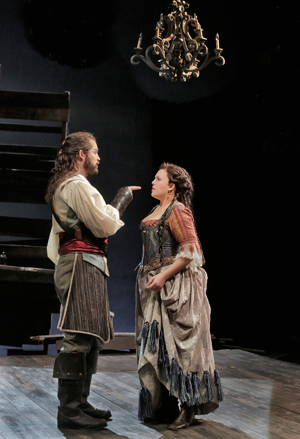 Brandon Cedel as Isacio and Devon Guthrie as Pulcheria
Brandon Cedel as Isacio and Devon Guthrie as Pulcheria
Director Lee Blakely has contributed a vision seeming so spontaneous as to be invisible. But make no mistake, Mr. Blakely has made some bold and innovative decisions. I loved the uses of levels to convey power struggles. The character relationships are richly detailed and commendably specific. How about that incestuous kiss dad Isacio forces on daughter Pulcheria in Act One? The audience shifted in their seats uncomfortably. Electric!
Grant Lewellyn led a taut performance that gave much musical satisfaction. Some judicious cuts may not please all purists, but the flow and running time of the show benefited greatly. Maestro Lewellyn exerted supreme control over his forces, and conducted a commendable, dramatically and musically compelling performance of Handel’s Richard the Lionheart.
My only quibble in a night that went from strength to strength is that the exit of soloists immediately after they had finished singing a few of the arias prompted the audience to applaud over the remaining orchestral playoffs. I would very much like to have heard those pieces through to musical conclusion. But that is a small (and fixable) consideration in a totally enjoyable evening spent reveling in the discovery of a ‘new’ opera.
James Sohre
Cast and production information:
Richard the Lionheart: Tim Mead; Costanza: Susannah Biller; Pulcheria: Devon Guthrie; Oronte: Tai Oney; Isacio: Brandon Cedel; Berardo: Adam Lau; Conductor: Grant Lewellyn; Director: Lee Blakely; Set and Costume Design: Jean-Marc Puissant; Lighting Design: Christopher Akerlind; Wig and Make-Up Design: Tom Watson; Choreography: Seán Curran
image=http://www.operatoday.com/RL_3145a.png
image_description=Susannah Biller as Costanza and Tim Mead as Richard the Lionheart [Photo © Ken Howard]
product=yes
product_title=Luminous Handel in Saint Louis
product_by=A review by James Sohre
product_id=Above: Susannah Biller as Costanza and Tim Mead as Richard the Lionheart
Photos © Ken Howard
June 21, 2015
Two Women in San Francisco
Possible answers multiply. San Francisco Opera music director is the Italian conductor Nicola Luisotti who will have held sway. Perhaps San Francisco Opera concurs that it has not had success with its recent premieres by American composers so thinks a journey back to the wellspring of opera might be a good idea.
A further and more palatable idea is that Two Women is potentially a rare story that supports operatic treatment. It is, at least in the eponymous Vittorio De Sica film, a story that has not been artistically explored — the sharing of the sublimely delicate moment when a girl becomes a woman (well, let us forget about Salome for the moment). The De Sica film explores this passage, this dramatic moment, in subtle and startling psychological terms laden in existentialism. The film is a masterpiece. Indeed ripe for opera.
The sound world of composer Marco Tutino supports such atmospheres. Tutino is a colorist who offers surprise after surprise in his score for Two Women, timbres that are hardly new — the bass clarinet for example — but were strategically placed to evoke heretofore unfelt sensations. Without creating an explicitly individual style Tutino avoids any derivative definition, though one might say that his conservative twentieth century sound has its roots in the verismo of Giordano but remains open to incorporating later techniques when called upon, like his very effective use of minimalism.
The opera Two Women or its Italian title La ciociara surely rides the coattails of the De Sica film so to be able to gain Italian and international attention. Comparison is therefore unavoidable, appropriate and in fact enlightening.
The De Sica film is derived from a novel, La ciociara (1957) by Italian novelist Alberto Moravia (Ciociara is a region of bleak and rocky hills south of Rome). Two Women was the title given the English language translation of La ciociara. The libretto for the opera Two Women is derived from a script by one Luca Rossi, it in turn derived from the Moravia novel.
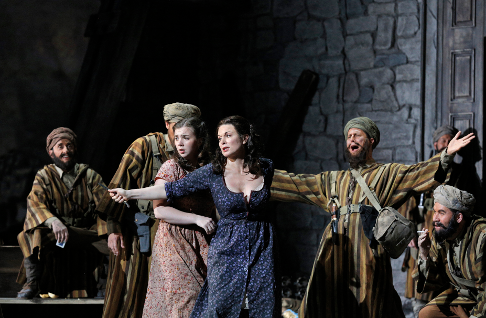 The two women and their Moroccan rapists
The two women and their Moroccan rapists
Unlike the film which focuses on the complex psyches of the two women and absolutely nothing else the libretto delves into the Italian or rather human psyche that in wartime abdicates principle to collaborate with whoever or whatever is powerful at the moment. The libretto creates villains, from the Nazi commander to his local collaborators and to the Moroccan mercenary thugs who rape the two women. A powerful sense of evil is created that is pitted against the survival of the two women and their young male soulmate. That the daughter achieves womanhood in a singularly brutal fashion becomes the secondary, and less important story.
Though it is a thoroughly Italian event the only Italian in the cast was mezzo-soprano Anna Caterina Antonacci as the mother (who by-the-way gives Sophia Loren a run for her money as the costuming intends). Her daughter was sung by American ingenue soubrette Sarah Shafer. While vocally appropriate — a warm, lower voice for the mother and a higher, much brighter voice for the daughter — the two heroines were not physically matched, troublesome in the often cinematic circumstance of this production.
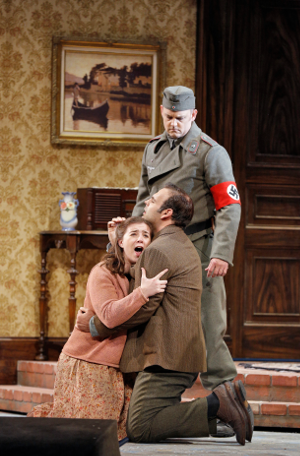 Sarah Shafer as Rosetta and Dimitri Pittas as Michele with Nazi soldier
Sarah Shafer as Rosetta and Dimitri Pittas as Michele with Nazi soldier
The young, pacifist school-teacher who infatuates both mother and daughter was sung by American tenor Dimitri Pittas (enough of a look-alike for Jean-Paul Belmondo from row P). The two villains were San Francisco Opera’s Scarpia, Mark Delavan as Giovanni and SFO’s Hoffmann villain, Christian Van Horn as the Nazi commandant.
Marco Tutino also created the libretto for his opera. It was staged by an all-American team (or at least all English speakers). The staging was a combination of cinematic scenes, docudrama of the advancing American forces in the liberation of Rome, the storybook fantasy of a verdant hilltop village in the arid region south of Roma as a sort of paradise, cut-out sets à la American musical and, yes, even moments of old fashioned opera.
The action unfolded in a series of vignettes that incorporated this potpourri of styles culminating in a complex, indeed impressive number (it is a numbers opera) where the action flip flopped between the rape of the women and the murder of Michele (the Belmondo role). Effective also was the scene of the Italian pop-crooner allowing composer Tutino to indulge in musical collage before he imagined a fairytale ending for his opera — a vision of the dead Michele walking toward the dream hilltop village.
The opening night audience accepted the opera as an old fashioned melodrama booing the villains, cheering the damsel (forgetting for the moment that she perhaps was not saved after all), and of course warmly thanking Mme. Antonacci and Mr. Pittas for ably holding their own against their cinematic competition (Loren and Belmondo). Comments overheard as the crowd left the theater were less enthusiastic.
As usual Maestro Nicola Luisotti forced his superb orchestra front and center, and it surely sang out all magic possible in Marco Tutino’s score. Interestingly and uncharacteristically the maestro allowed the singers to be actors in this drama rather than his musical puppets.
Said and done, the real opera remains the De Sica film. It creates one hundred minutes of pure lyricism, never descending to the cliches of movies or theater, or in the case of the opera Two Women to the cliches of musical theater.
Michael Milenski
Cast and production information:
Cesira: Anna Caterina Antonacci; Rosetta: Sarah Shafer; Michele: Dimitri Pittas; Giovanni: Mark Delavan; John Buckley: Eddie Nelson; Pasquale Sciortino: Joel Sorensen; Fedor Von Bock: Christian Van Horn; Maria Sciortino: Buffy Baggott; Italian Singer: Pasquale Esposito; Country Woman: Zanda Svede; Old Woman: Sally Mouzon. Orchestra and Chorus of the San Francisco Opera. Conductor: Nicola Luisotti; Stage Director: Francesca Zambello; Set Designer: Peter Davison; Costume Designer: Jess Goldstein; Lighting Designer: Mark McCullough; Projection Designer: S. Katy Tucker. War Memorial Opera House, San Francisco, June 13, 2015.
image=http://www.operatoday.com/TwoWomen_SF1.png
image_description=Sarah Shafer as Rosetta and Anna Caterina Antonacci as Cesira [Photo by Cory Weaver}
product=yes
product_title=Two Women in San Francisco
product_by=A review by Michael Milenski
product_id=Above: Sarah Shafer as Rosetta and Anna Caterina Antonacci as Cesira
Photos by Cory Weaver courtesy of San Francisco Opera
June 19, 2015
Les Troyens in San Francisco
Often these days the two parts are separated by a break of a couple hours thus enabling an audience to transcend the horror of the Trojan slaughter before settling into the beatific idyll of Dido’s Carthage and the fervors of founding Rome.
No such good fortune in San Francisco. It was done as one long moment, over five plus straight hours, its temporal monumentality forced into a single span of unrelenting musical and dramatic intensity. The action was so tightly drawn that British director David McVicar forced Susan Graham’s Dido to stand before a naked black stage curtain to deliver her impassioned adieu to Carthage (while her pyre was rolled onto the scene behind the curtain) — no pause before immediate immolation.
There was not a moment to be wasted in the race to the end.
On good days conductor Donald Runnicles brought the show in at just under five hours.
The McVicar production can indeed boast theatrical efficiency. It was all effected in front of a massive amphitheater shape set, its convex face apparent for Troy, its concave face exposed for Carthage. Both sides of the scenic unit were tiered so that the choristers could be deployed on the structure almost concert style gracefully eliminating the problem of how to stage the massive choruses.
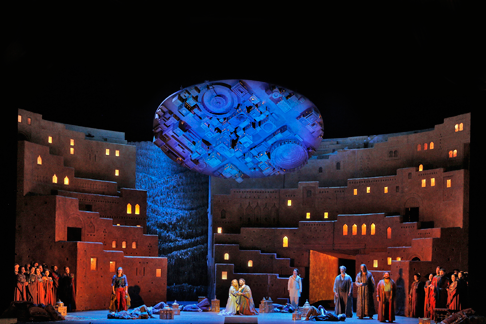 A scene from Act IV
A scene from Act IV
Carthage was first a floor placed oval platform of miniature buildings on which McVicar’s signature male acolytes cavorted. The platform was tilted on its side and raised high, moonlike (deep blue light) for the garden, and then split, its halves moving to the sides of the stage when the love affair fell apart.
No stranger to heroic proportions the production designer, Es Devlin designed the closing ceremony of the 2012 London Olympics and will design the opening ceremony of the 2016 Rio de Janiero games. Maximum of effect with a minimum of means (someone mentioned there are 35 tons of Trojans scenery). Not to be confused with minimalism.
The McVicar direction was absolutely straightforward. The action was exactly the old story and exactly the music, like the choristers raining confetti onto their queen at the precise moments the Berlioz music spilled into momentary ecstasies. We were simply swept along by the action, no roadblocks to the inexorable destruction of a queen and her city.
Strangely the gigantic Trojan House head was made of bits of industrial revolution detritus plus a Greek shield or two, as was the gigantic torso of Aeneas that would one day squash Carthage. Dress was nineteenth century (a bewildered audience member was overheard explaining that maybe this was because there are a lot of nineteenth century operas so San Francisco Opera has a lot of old costumes that could be used).
If there was a concept besides theatrical efficiency it was not discernible. The McVicar production was heavy on solutions for easy story telling and quick scene changes. These solutions did make those five hours fly by with not a lot to think about!
Berlioz was left in the dust. Berlioz is an iconoclast, a misfit, a dreamer, an egomaniac, and of course a genius. His music is at once naive and brilliant. He absorbed Gluck and Beethoven making them uncomfortable partners. He could write meltingly beautiful music and at the same time relish in pushing harmonic rhythms beyond academic acceptability. It is not easy music.
Furthermore and by the way his estranged wife was an English Shakespearean tragedienne, he detested Rome as much as he detested (and was detested by) the operatic establishment.
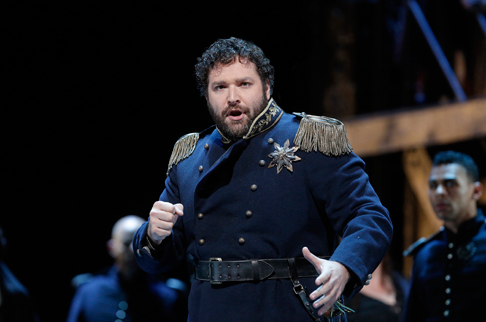 Bryon Hymel as Aeneas
Bryon Hymel as Aeneas
There were many, many fine performances (it is a huge cast) in this San Francisco edition, certainly beginning with the conducting of Donald Runnicles who carefully, even too carefully integrated his musical flow into the slick McVicar storytelling. There was wonderfully direct communication and understanding between the stage and pit in measured — huge or intimate as needed — never unleashed musicality.
Italian mezzo soprano Anna Caterina Antonacci created a riveting Cassandra at the San Francisco premiere, her voice lying comfortably in the role, no hint of the careful control she exerts in creating her higher Gluck heroines, rather she was a beautiful, human Cassandra in warm, strong and open tone and in honest, agonized posture. This made her love duet with her husband-to-be Coroebus, sung by Brian Mulligan, the most splendid moment of these performances. Baritone Mulligan, a catch-all San Francisco Opera regular, here found a role where his voice flowed in quite beautifully smooth, French colored tones, his persona constrained in mannered postures consistent with this brief and sad final encounter with his fiancé.
At the second performance one week later the role of Cassandra was taken by American soprano Michaela Martens. She is known to broader audiences for brilliantly portraying the passivity of Marilyn Klinghoffer both at ENO and the Met. A fine singer with a sizable voice (and career) she does not have the persona or experience to embody this epic character role, begging the question why she was cast.
There is no question that the role of Aeneas currently belongs to American tenor Bryan Hymel. He is handsome and heroic, his voice lies perfectly in the French heroic style pioneered by Berlioz. He has a sound that is uniquely French (he is from New Orleans) the strength of voice to portray a hero, a top that is open, secure and thrilling. Most of all he exudes youth and discovery creating an Aeneas who is emotionally connected to discovering love and discovering the world.
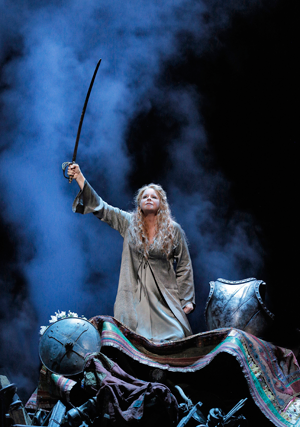 Susan Graham as Dido
Susan Graham as Dido
Esteemed American mezzo Susan Graham donned the long blond tresses of the tragic queen Dido. Mme. Graham is an exquisite singer, able to elegantly carve the ecstatic and desperate outpourings of this unfortunate, operatically over-exposed queen. Mme. Grahams’ Dido was sculpted art. It was not Dido the tragic queen.
The expanded San Francisco Opera Chorus was magnificent, as prescribed. Operatic ballet is famously maligned (remember the ballet in Samson et Dalila?). Here, if ever, operatic ballet has been exonerated. Sixteen dancers superbly executed the original Covent Garden Broadway style choreography by Lynne Page.
Michael Milenski
Cast and production information:
Cassandra: Anna Caterina Antonacci (June 7); Cassandra: Michaela Martens (June 12); Dido: Susan Graham; Aeneas: Bryan Hymel; Ascanius: Nian Wang; Anna: Sasha Cooke; Coroebus: Brian Mulligan; Narbal: Christian van Horn; Pantheus: Philip Horst; Iopas: Renè Barbera; Helenus: Chong Wang; Hylas: Chong Wang; King Briam: Philip Skinner; Queen Hecuba: Buffy Baggott; The Ghost of Cassandra: Buffy Baggott; The Ghost of Hector: Jordan Bisch; Greek Captain: Anthony Reed; Trojan Soldier: Matthew Stump; Trojan Chief: Jere Torkelsen; Andromaque: Brook Broughton; Polyxena: Rachel Speidel Little. Orchestra, Chorus and Ballet of the San Francisco Opera. Conductor: Donald Runnicles; Production: David McVicar; Stage Director: Leah Hausman; Choreographer: Lynne Page; Set Designer: Es Devlin; Costume Designer: Moritz Junge; Lighting Designer: Wolfgang Göbbel. War Memorial Opera House, San Francisco, June 12 and June 17, 2015.
image=http://www.operatoday.com/Trojans1.png
image_description=Anna Caterina Antonacci as Cassandra, Brian Mulligan as Coroebus [Photo by Corey Weaver, courtesy of San Francisco Opera]
product=yes
product_title=Les Troyens in San Francisco
product_by=A review by Michael Milenski
product_id=Above: Anna Caterina Antonacci as Cassandra, Brian Mulligan as Coroebus
Photos by Corey Weaver, courtesy of San Francisco Opera
Dog Days at REDCAT
On Saturday evening June 13, 2015, Los Angeles Opera presented Dog Days, a new opera with music by David T. Little and a text by Royce Vavrek. Audiences had already seen the work in Montclair, New Jersey, and Fort Worth, Texas. Los Angeles Opera presented it at the Roy and Edna Disney CalArts Theater (REDCAT), a tiny black box theater located in Walt Disney Hall. In the opera adopted from a story of the same name by Judy Budnitz, thirteen-year-old Lisa tells of her family’s mental and physical disintegration resulting from the ravages of a horrendous war.
Baritone James Bobick sings the part of her harried father who would have provided for his wife and children if he could. Since that was not possible, his emotions turned to anger. Although he walked around with a gun, there were no animals to hunt. Bobick’s part was huge and he sang it with gusto even though most of it was declamatory. His wife, sung by Marnie Breckenridge, tried to keep up appearances, but that, too, was impossible.
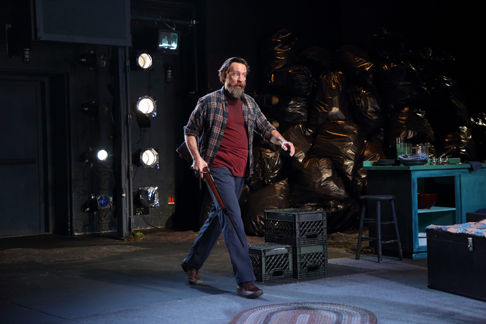 James Bobick as the Father
James Bobick as the Father
Except for a harmonized prayer before each of the family’s scant meals, the orchestral instruments seldom backed up the vocal line. Thus, the voices often lacked the support of traditional opera accompaniment. The Newspeak Orchestra, conducted by Alan Pierson, consisted of clarinet, guitar, piano, violin, viola, cello, double bass, and percussion team. This unusual group of instruments produced some interesting sonorities that were most effective in the instrumental interludes.
If your idea of opera is melodic music sung unamplified by some of the world’s most beautiful voices, Dog Days is not for you. Garth MacAleavey’s sound engineering amplified the voices as well as the noise and vibrations of a helicopter, which brought the family food, water and blankets. I wished Little had chosen to write his musical impression of a helicopter instead of using the actual sounds.
Lauren Worsham gave a magnificent interpretation of the teenaged Lisa who carefully chronicled this horrific story, knowing all the time that those who were most likely to read it had already died. Strangely, there were no supertitles shown except for a short space of time when Lisa wrote to a friend who might no longer have been living. Perhaps Lisa is a fictional Anne Frank for post apocalyptic times. As the reader can see by now, there is little uplifting about this opera.
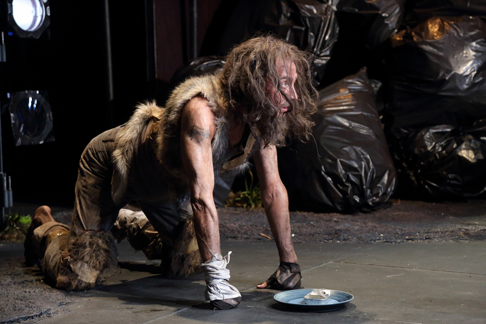 John Kelly as the Dog
John Kelly as the Dog
The Dog, played by actor John Kelly, is actually a young man who wears a dog suit and crawls around on all fours. After a while, he seemed more human than the people. The least savory family members were Lisa’s two brothers, Elliott, sung by Michael Marcotte, and Pat, played by Peter Tantsits. They spent the last days of their lives smoking pot and looking at pornography.
The one scene that brought out some emotional reactions from the audience occurred when Lisa realized her mother had died. She looked at the dirt on her mother’s face and began to wash the body in an attempt to give her mother a decent burial. A moment later the helicopter noise and vibration was back and the emotional impact vanished. David T. Little has the makings of an interesting composer. I hope he will continue to write for the voice, possibly having learned some lessons from this opera.
Maria Nockin
Cast and production information:
Father, James Bobick; Mother, Marnie Breckenridge; Captain, Cherry Duke; Dog, John Kelly (actor); Elliott, Michael Marcotte; Soldier, Steve Polites; Pat, Peter Tantsits; Lisa, Lauren Worsham; Creative Producer, Beth Morrison; Director, Robert Woodruff; Scenic and Video Design, Jim Findlay; Lighting Design, Christopher Kuhl; Costume Design, Victoria “Vita”; Tzykun; Sound engineering, Garth MacAleavey; Musical Direction, Alan Pierson; Newspeak Ensemble.
image=http://www.operatoday.com/Dog_Days01.png
image_description=Marnie Breckenridge as the Mother and Lauren Worsham as Lisa [Photo by Greg Grudt]
product=yes
product_title=Dog Days at REDCAT
product_by=A review by Maria Nockin
product_id=Above: Marnie Breckenridge as the Mother and Lauren Worsham as Lisa
Photos by Greg Grudt
June 18, 2015
Opera Las Vegas Presents Exquisite Madama Butterfly
There, it was a resounding success. Nevertheless, the composer continued making revisions. He presented a third version for the Metropolitan Opera premiere in 1906, and more changes on two occasions in 1907. That fifth version from 1907 is the standard score generally heard today.
Giacomo Puccini saw David Belasco’s one-act play Madame Butterfly: A Tragedy of Japan in London during the summer of 1900. Adapted from John Luther Long's 1898 short story, Madame Butterfly was based on the recollections of his sister, Jennie Correll, who had been to Japan with her husband as Methodist missionaries. The play opened at the Herald Square Theatre in New York City before moving to London. Puccini’s librettists, Luigi Illica and Giuseppe Giacosa, used Belasco’s play, Long's short story and Pierre Loti’s semi-autobiographical 1887 French novel, Madame Chrysanthème, as the basis for the opera’s text.
Audiences at the Teatro alla Scala in Milan first saw Madama Butterfly on February 17, 1904. It was not the success it is these days, and Puccini revised it before its scheduled performances in Brescia. There, it was a resounding success. Nevertheless, the composer continued making revisions. He presented a third version for the Metropolitan Opera premiere in 1906, and more changes on two occasions in 1907. That fifth version from 1907 is the standard score generally heard today.
On June 12, 2015, Opera Las Vegas presented Madama Butterfly at the University of Nevada’s Judy Bayley Theater. Ian Mangum’s scenic design consisted of a small Japanese style house with flowering trees on either side. The Japanese ladies looked most attractive in Jennifer Van Buskirk’s flowered kimonos while the male characters wore period outfits appropriate to their nationalities.
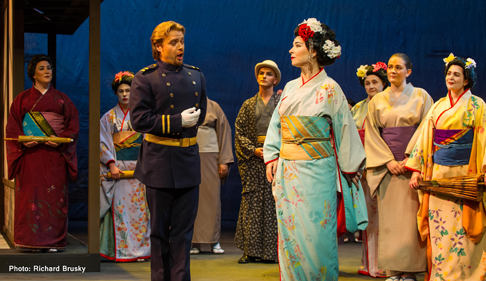 Suzuki, Stephanie Weiss; Pinkerton, Viktor Antipenko; Goro, Joseph Gaines; Butterfly, Inna Los; with chorus.
Suzuki, Stephanie Weiss; Pinkerton, Viktor Antipenko; Goro, Joseph Gaines; Butterfly, Inna Los; with chorus.
Following the tradition of Japanese theater, Director Henry Akina used graceful stagehands completely dressed in black with veiled faces to perform onstage tasks such as supplying lanterns for the love duet. Akina showed his audience both sides of the story, Butterfly’s desire to become an American wife and her life in the Japanese society that surrounded her. He enabled the singers to create memorable characters that will live on in the minds of onlookers long after the end of each performance.
General Director Luana DeVol chose large voiced singers and the performance was a golden age singfest. Russian tenor Viktor Antipenko had a bright burnished tone and the ability to connect with the audience’s emotions. In the first act he was a patient and devoted lover who never expected Butterfly to think of him as a long-term husband. Despite Sharpless’s warning, it was not until the last act that Pinkerton realized what he had done. His “Addio, fiorito asil di letizia e d'amor!” (“Farewell, flower-clad refuge of joy and love”) was heart rending as he realized that Cio Cio San’s face would always haunt his dreams.
Moldavian soprano Inna Los is a small woman with a huge voice, and that makes her a perfect choice for Madama Butterfly. Puccini accompanied Cio Cio San’s music with a relatively heavy orchestration, but the story tells us that she was only fifteen years old. At the end of Act I Pinkerton carried his young wife upstage toward their bedroom.
Los’s characterization matured over the space of the opera. A giddy young girl enjoying her wedding at the beginning, Butterfly later became a caring wife and mother who knew how to economize when times were difficult. She sang her aria “Un bel dì” (“One Fine Day”) with powerful tones and passionate involvement that brought tears to many eyes and won her a well deserved round of applause. At the end she had to realize that there was no longer a place for her in Pinkerton’s world. Like her father before her, Butterfly concluded that if she could no longer live with honor she would be strong enough to do what her culture demanded. When she tumbled out from behind the screen there was not a dry eye in the house.
As American Consul Sharpless, Daniel Sutin was a bureaucrat who paid more attention to form than he did to Butterfly’s emotional well-being. He sang with dark tones and his voice was a good contrast to that of Antipenko. Actually, the whole cast was well balanced. As Suzuki, Stephanie Weiss sang substantial harmonies with Los and their Flower Duet was enchanting.
Joseph Gaines was an amusing Matchmaker who added a bit of levity to a tragic story. The choice of Brian James Myer’s obviously shallow Yamadori as a suitor for Butterfly showed how little the men of the Nagasaki paid to serious matchmaking. Eugene (Trey) Richards was an impressive Bonze whose curse colored much of the rest of the opera. Valerie Sokolov Ore sang Kate Pinkerton’s few lines well and gave the audience the impression that she would be a good mother to little Dolore.
Megan Frank’s choristers sang their Humming Chorus with plangent harmonies presaging the tragedy to come. It is the conductor who holds the entire performance together and Gregory Buchalter’s attention to detail made this production memorable. His interpretation involved brisk pacing and increasing tension along with subtly nuanced expressivity as the gripping story drew ever nearer to its inevitable conclusion. Buchalter, the company’s artistic director, is a find for Opera Las Vegas. I wish they would present more than one opera a year with this fine conductor.
Maria Nockin
Cast and production information:
Madama Butterfly, Inna Los; Lt. Pinkerton, Viktor Antipenko; U.S. Consul Sharpless, Daniel Sutin; Suzuki, Stephanie Weiss; Goro, Joseph Gaines; Prince Yamadori, Brian James Myer; The Bonze, Eugene (Trey) Richards; Imperial Commissioner, Nathan Van Arsdale; Registrar, John Wennstrom; Yakuside, Kurt Sedlmeir; Butterfly’s Relatives: Gloria Grev, Patricia Newell, Claire Marie Reynolds; Kate Pinkerton, Valerie Sokolov Ore; Dolore, Noah Sirulnik; Conductor, Gregory Buchalter; Director, Henry Akina; Chorus Director, Megan Franke; Scenic Design, Ian Mangum; Costumes, Jennifer Van Buskirk; Lighting Design, Virginia Adams; Supertitles, Wendy Moss.
image=http://www.operatoday.com/_D3S4-RICHARD-BRUSKY-872-2.png
image_description=Viktor Antipenko and Inna Los as Pinkerton and Butterfly [Photo by Richard Brusky]
product=yes
product_title=Opera Las Vegas Presents Exquisite Madama Butterfly
product_by=A review by Maria Nockin
product_id=Above: Viktor Antipenko and Inna Los as Pinkerton and Butterfly
Photos by Richard Brusky
Yardbird, Philadelphia
Recent years have seen memorable performances of Britten’s Rape of Lucretia and several operas by Hans Werner Henze, as well as the company’s new American Repertoire Program, which has commissioned new works on American themes, including Kevin Puts’ Silent Night.
As part of the latter program, Opera Philadelphia has recently presented the world premiere of Daniel Schnyder’s Charlie Parker’s Yardbird. This project could not go far wrong. The idea of jazz-classical fusion is attractive to many people, and Parker is a jazz icon who remains popular and influential today. All five performances were sold out well in advance. On June 12th, the night I attended, the audience was noticeably more diverse than usual—and they rewarded the performance with a standing ovation.
This reflects not just bold repertoire, but consistently classy artistic choices. Opera Philadelphia casts excellent young singers, assures intense music preparation, and maintains solid production values. The cast of Yardbird was headed by three company veterans: Lawrence Brownlee, one of the world’s great bel canto tenors, as Charlie Parker; Angela Brown, a talented spinto soprano, as his mother; and Tamara Mumford, a rising young mezzo, as the Baroness.
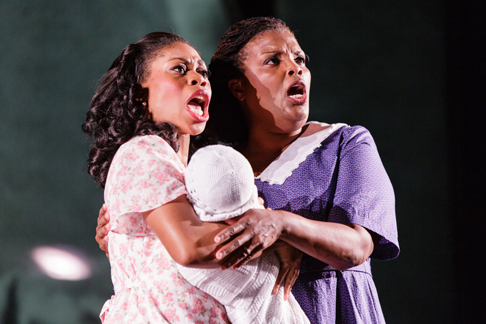 Chrystal E. Williams as Charlie’s first wife, Rebecca Parker, and Angela Brown as Charlie’s mother, Addie Parker
Chrystal E. Williams as Charlie’s first wife, Rebecca Parker, and Angela Brown as Charlie’s mother, Addie Parker
Each sang well in Yardbird. Brown’s large, warm voice easily filled the hall. Mumford provided a consistent combination of elegant focus, rich color and sensitive phrasing. And Brownlee, on stage almost all night, sang with tireless elegance and passion, particularly at the top of his voice. Two Virginians, mezzo Chrystal Williams and baritone Will Liverman, made promising company debuts as Rebecca and Dizzy Gillespie respectively. All seemed comfortable singing in the grey area between jazz and classical music. The company’s music director Corrado Rovaris led a skilled pit band of 15 skillfully, if a bit cautiously. The sets were simple, yet effective.
Still, I believe—in contrast to what most critics have concluded—one essential ingredient was clearly missing: a great opera. Neither the words nor music of Yardbird matched the quality of the premise, the singers, the production and the musical preparation.
Yardbird’s greatest weakness lies in its libretto, which lacks narrative coherence and lyrical depth. The initial premise of the plot is absurd: Parker languishes in quasi-limbo for two days after his own death, trying to finish a large classical work, which he never writes. In fact this is simply a plot device to permit flashbacks, focusing on Parker’s complex relationships to women: his mother and two wives, plus his patron and hostess, Nica de Koenigswarter.
But why should we care about Parker’s relationships? As a man, Bird was charismatic and inconstant. Yet his personal life creates a static plotline. He made a mess of his love life, but with nothing special is describing his various wives and children, the drama lacks weight. Episodes follow one another without any clear sense of direction. Feeble efforts to create links to civil rights—a movement with which Parker never had anything to do—only serves to highlight the central void.
This lack of content is reinforced by pop-style lyrics that range from the banal to the unintelligible. One example must suffice. Just before Parker dies (for real, this time), Nica sings:
“Bird. Bird is gone.
Gone to that place, that place, that place between darkness and night,
Brightness and light, where the stars go on a starless night.
…Boundless gravity of a star no more. No more, no more.”
I do not know what precisely this means, what deeper theme about Charlie Parker it expresses, or why Nica is the appropriate character to sing it.
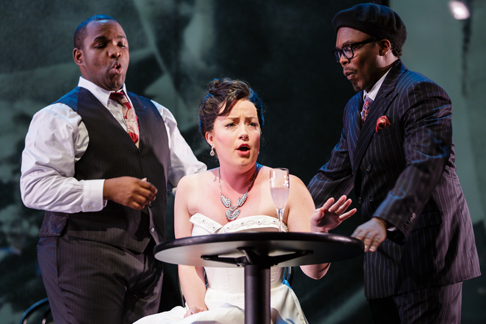 Will Liverman as Dizzy Gillespie, Lawrence Brownlee as Charlie
Parker, and Rachel Sterrenberg as Chan Parker
Will Liverman as Dizzy Gillespie, Lawrence Brownlee as Charlie
Parker, and Rachel Sterrenberg as Chan Parker
The truth this libretto evades is that we remember Charlie Parker for one reason only: he revolutionized jazz. In Miles’ famous (if surely apocryphal) quip: “You can tell the history of jazz in four words: Louis Armstrong, Charlie Parker.” While it is difficult for an opera librettist to dramatize musical creation, it is possible, as Wagner’s Die Meistersinger, Rimsky-Korsakov’s Mozart and Salieri, Pfitzner’s Palestrina, and even Frank Zappa’s Joe’s Garage demonstrate. It is a pity this libretto, one number excepted, hardly tries to do so.
So for depth and weight, we must look to Yardbird’s musical score. The composer, Swiss-born and New York-based composer Daniel Schnyder, is a remarkably prolific and multi-talented musician. He tours as a jazz saxophonist and writes prolific so-called (“third stream”) music combining jazz and classical elements. Some of his compositions, notably his concertos (above all the one for bass trombone), chamber music, and arrangements of jazz standards have become minor classics. He has also written pieces for non-Western instruments, incidental music, and at least two previous operas: Casanova and The Tempest.
With Yardbird, however, it is clear from the start that Schnyder is shying away from the central challenge facing any third stream composer, namely to find a way to integrate classical and jazz music, as Gershwin did 80 years ago in Porgy and Bess, but in a way that takes account of the subsequent evolution of jazz from swing to the modern style. Since the modern style began with Charlie Parker’s be-bop, what could be a more appropriate platform on which to do this than an opera on his life? Surely Schnyder is more qualified than any other contemporary composer to take on this challenge. And precisely because this innovation is very hard to achieve—it is difficult even to imagine what it would mean—I would prefer to hear an opera that really tries to achieve it, even if it fails.
Instead, Yardbird follows a cautious and tired formula already employed by other post-serialist operas that seek to synthesize classical and jazz genres, such as John Harbison’s The Great Gatsby. Let’s call it a “classical-pop pastiche.” Number after number repeats the same scheme: a modern quasi-atonal classical introduction morphs into to jazzy dance tune with modern harmonies (diminished chords, prominent 9ths and 13ths), to which characters sing. The score is sprinkled with many—sometimes quite humorous—musical references and quotations. Little snatches of “Cherokee,” “Round Midnight,” “Moose the Mooche” and other Parker tunes and licks, not to mention a bit of Beethoven’s Eroica, float through the orchestra.
The result is a clever and well-crafted score that makes for modestly entertaining listening minute by minute. A few moments, not coincidentally notably those having to do with Parker’s music—Bird’s soliloquy to his horn and his duet with Dizzy Gillespie—stand out as truly memorable. Yet most of the individual arias and ensembles lack dramatic shape and, not being coherently written through, fail to gather and maintain musical momentum across longer spans of time. Ultimately the score becomes repetitive and tiresome, just as similar operas by Harbison and other worthy and talented composers did.
Whatever Yardbird’s underlying merits, Opera Philadelphia should be praised for taking risks on innovative new operas and has every reason to be proud of this interesting musical experiment.
Andrew Moravcsik
image=http://www.operatoday.com/yardbird_024.png image_description=Lawrence Brownlee as Charlie Parker sings “My Horn” [Photo by Dominic M. Mercier] product=yes product_title=Yardbird, Philadelphia product_by=A review by Andrew Moravcsik product_id=Above: Lawrence Brownlee as Charlie Parker sings “My Horn”Photos by Dominic M. Mercier
June 15, 2015
Giovanni Paisiello: Il Barbiere di Siviglia
Rossini was ruthless, rippling off swaths of both Paisiello’s libretto and his music. This infuriated diehard Paisiello fans, whose cries of anger famously caused the 1816 premiere of Rossini’s opera to flop. Yet they could not keep a good work down for long. Rossini trumps his predecessor at every turn: his music has greater vitality, originality and wit, and his dramatic conception imbues the stock characters of Italian commedia dell’arte with a universal humanity that we still recognize today.
This famous history poses a psychological problem for any listener at a rare revival of Paisiello’s opera: how can one avoid keeping score? One is constantly tempted to engage in number-by-number comparison with the more famous version, which distracts from the virtues of the earlier one. After all, Paisiello’s Barbiere was famous for a reason: it is a minor masterpiece on its own terms, with simplicity of musical expression, directness of utterance and suave 18th century gentility all its own.
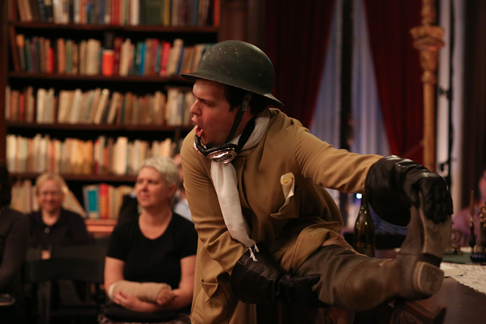 David Blalock as Count Almaviva
David Blalock as Count Almaviva
A recent production at On Site Opera in New York achieved the seemingly impossible. The performance I attended on June 11th was so fresh, original and immediate that, within minutes, it banished any thought of Rossini from my mind.
Much of the success was due to the magic of in situ performance, which is the calling card of this company: its productions are set in appropriate “everyday” spaces throughout New York, where singers perform just a few feet from a small audience. This Barbiere was presented in and around the lovely Fabbri Mansion on East 95th Street, built in Italian Renaissance style. For the first scene, an audience of just 80 was seated in a small front courtyard. Figaro and Almaviva entered through a front ironwork gate, Bartolo peered out of the front door of the mansion, and Rosina sang from a second-story window. We then moved upstairs to a balconied Italianate library room that might have been in Pesaro, Parma or Seville. Throughout, there were no sets and few props, just this appropriate setting. All this seemed just right for an opera written for audiences of a few hundred gathered in small theaters, often in mansions or palaces. Though the combination of intimate surroundings, superb diction and fine acting all but dispensed with any need for supertitles, they were provided on modest HD screens.
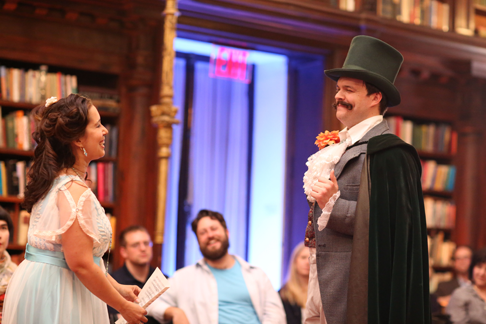 Monica Yunus as Rosina and David Blalock as Count Almaviva
Monica Yunus as Rosina and David Blalock as Count Almaviva
To revive a second-tier opera in an intimate setting, a company needs singing actors who are completely secure technically and credible, musically and dramatically, even with spectators just three feet away. Credit for the brilliant success of this production is thus due, above all, to the cast. Despite oppressive 90+ degree heat, they rendered this opera as fresh and immediate as it must have appeared to listeners in Paisiello’s heyday. The performers, mostly in their 30s with solid national and international successes, seemed to revel in the challenge, responding with completely credible singing and acting.
Andrew Wilkowske’s warm and full-voiced baritone was well-suited to his charismatic and characterful portrayal of Figaro. His voice sounds like it has the potential to evolve into the rarest of all things in modern opera: a great Verdi baritone. Soprano Monica Yunus made a winning Rosina. She succeeded almost entirely in warming up an essentially lyric coloratura voice to fit this more lyric role—musically and dramatically, Paisiello’s Rosina is more pensive and less forward than Rossini’s—aided by exceptionally lovely breath control and phrasing. As Almaviva, tenor David Blalock looked the part and sang competently, though he struggled at times to generate an appropriately light and warmly elegant tone, for example in Lindoro’s serenade (in the 18th century, the opera’s most famous number). Bass Rod Nelman blustered his way through Bartolo’s travails with a focused, brilliant tone, while bass-baritone Isaiah Musik-Ayala acted and sang well in the part of his buddy Basilio, paying scrupulous attention to Paisiello’s dynamics in the big aria, which are subtler than those of Rossini. Baritone Benjamin Bloomfield and Jessica Rose Futran rendered the servant’s slapstick credible, with the former deploying an extraordinarily large voice and the latter a voice noticeably smaller than those around her.
The orchestra was a slimmed down to eight and played under the inspired direction of Geoffrey McDonald. A few intonation issues aside, inevitable at that scale and with different environments, the players were skilled and energetic. The musical preparation was superb. At no moment did the flow of the music threaten to fray, despite the extraordinary challenges of conducting a group of singers often facing away from the conductor.
Overall I enjoyed this evening as much as any live opera I’ve attended in the last decade. The performance captured the spirit of the work. I was surely not alone: I looked around the room as we exited and everyone was smiling. More than that, this performance spoke to the state of opera as an art form. As larger companies like the Met, just across the park, continues to struggle with resources and relevance, smaller companies like On Site Opera are experimenting with performance in non-traditional spaces, generally at something closer to the scale at which these many works were historically meant to be heard. Perhaps they are have found a viable route back to the future.
Andrew Moravcsik
image=http://www.operatoday.com/15-OSO-BARBER-LIBRARY.png image_description=Andrew Wilkowske as Figaro and Monica Yunus as Rosina [Photo by Rebecca Fay] product=yes product_title=Giovanni Paisiello: Il Barbiere di Siviglia product_by=A review by Andrew Moravcsik product_id=Above: Andrew Wilkowske as Figaro and Monica Yunus as RosinaPhotos by Rebecca Fay
Princeton Festival: Le Nozze di Figaro
This summer the festival is offering an enjoyable and compelling production of Mozart’s Le Nozze di Figaro, which demonstrates not just the enduring beauty of this evergreen opera, but the high quality of young singers available to sing it today.
The cast was headed by three uncommonly large-voiced Mozartians. Jonathan Lasch, a burly bass-baritone who has trained in numerous young singers’ programs, sang a lusty, heavy-weight Figaro. His best moments came in Act IV, when he relaxed and demonstrated more vocal colors. Baritone Sean Anderson brought similar vocal force to the role of Count Almaviva, making much of his angry Act III aria. The rest might have profited from a bit more aristocratic restraint.
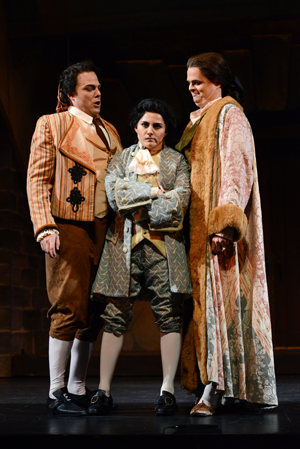 Jonathan Lasch as Figaro, Cassandra Zoé Velasco as Cherubino, Sean Anderson as Count Almaviva
Jonathan Lasch as Figaro, Cassandra Zoé Velasco as Cherubino, Sean Anderson as Count Almaviva
Canadian soprano Katherine Whyte portrayed the Countess Almaviva as a deeply passionate woman. She demonstrated a keen artistic sensibility throughout, for example with lovely pianissimo phrasing in the second verse of “Dove sono.” Still, the sustained notes in her two big arias cruelly exposed a wobble in the voice—which disappeared, however, in ensembles and swifter passages, where she was uncommonly dramatic. Overall, one wonders if Whyte is a budding spinto who has outgrown this role.
Another bit of slightly problematic casting is Haeran Hong, a Korean-born Juilliard-trained soprano who won the Queen Elizabeth competition in 2011, as Susanna. To be sure, hers was a polished performance from an artist who is going places. She sang precisely and tastefully: I particularly liked the delicately interpolated B-flat at the end of “Deh vieni.” She looked lovely and acted sympathetically. That being said, the lighter weight and coolly metallic edge of her voice betrays a lyric coloratura or “soubrette”, rather than a warmer lyric soprano for which the role of Susanna was written. For me, this type of vocal mismatch undermines both characterization and ensemble.
A worthy audience favorite was 25-year old Mexican Cassandra Zoé-Velasco, who already has a career well under way. She possesses a mezzo voice with real color and depth. She phrased with mature artistic sensibility while believably portraying Cherubino as an awkward adolescent.
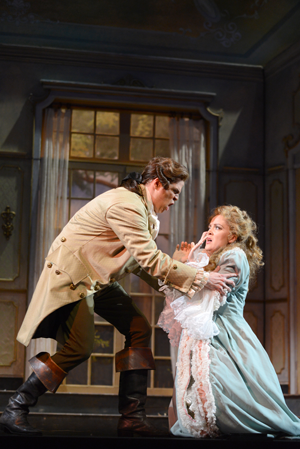 Sean Anderson as Count Almaviva, Katherine Whyte as the Countess
Sean Anderson as Count Almaviva, Katherine Whyte as the Countess
The rest of the cast was solid down to the shortest role. Two veterans, American Katheryn Krasovec and Puerto Rican Ricardo Lugo, memorably assumed the roles of Marcellina and Bartolo. Both are fine singing actors, with Krasovec’s Marcellina in particular making much of her character’s humanity, while remaining genuinely funny. Jessica Beebe, a doctoral candidate at Indiana with a lifetime of experience as a young choral soloist, made the most of Barbarina’s half aria. David Kellett, Studio Instructor on the Princeton faculty, lacks the extra bit of edge one has come to expect in the character role of Don Bazilio and he transposed some words, but he acted and sang well in this character’s insinuating asides. Paul An, a versatile young American bass, and Vincent DiPeri, a musical theater singer trained at the local Westminster Choir College, turned in creditable performances as Antonio and Don Curzio.
The greatest room for improvement of this production during the run, I believe, lies in the conducting. On the plus side, conductor Richard Tang Yuk’s conception of Mozart is smooth and unfussy. Conducting one or two beats to the bar, he quickly established the elegant flow that is a hallmark of fine Mozart operatic accompaniment—yet is often absent from performance-practice renditions. The ensemble was tight, with only a few opening-night bobbles.
On the minus side, Yuk’s dynamics remain rather unvaryingly and unnecessarily loud, given the small size of the pit band—a quality even more distracting in a hall ill-designed for opera. It is easy to forget that in this opera Mozart specifically marked most non-choral numbers and almost all vocal entries piano, with forte employed almost exclusively only for occasional emphasis, climaxes, and choral numbers. In the few moments when the scoring forced the orchestra down to a steady piano (e.g. “Voi che sapete” and “Deh vieni”), it was as if a sonic scrim had lifted and the singers could reach over the orchestra and touch the audience directly. Lower volume, combined with a warmer more yielding orchestral timbre and a bit more rubato, might also encourage the young singers to take the edge off of what was (despite slow tempi) a needlessly boisterous account and, rather, to highlight the elegant vocal colors and subtle Italian wordplay so central to this opera.
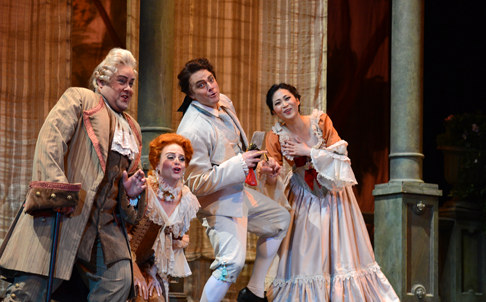 Ricardo Lugo as Bartolo, Kathryn Krasovec as Marcellina, Jonathan Lasch as Figaro, Haeran Hong as Susanna
Ricardo Lugo as Bartolo, Kathryn Krasovec as Marcellina, Jonathan Lasch as Figaro, Haeran Hong as Susanna
The hyper-traditional and realistic stage design by Peter Dean Beck was so pleasing to the eye that it elicited audience applause. Stephen LaCosse’s direction, while largely following time-tested formulas, included at least one original idea borrowed from Rosenkavalier: Marcellina, Cherubino, Susanna and the Countess (as well as Don Basilio!) each looked into a hand mirror and all saw the different things that the passage of time had wrought. A few other notions were misconceived: for example, no matter how much of an impulsive teenager he is, Cherubino would never reach up and grab the Countess’s face, while, for her part, the Countess would surely take the Count’s arm in public, if only to save face.
The opening night performance I attended was sold out, and the audience gave a standing ovation. This worthy production returns for Sunday matinees on June 21 and 28.
Andrew Moravcsik
image=http://www.operatoday.com/06.10.15_Princeton_Figaro_1238_EDIT.png image_description=Jonathan Lasch as Figaro (photo courtesy of Jessi Franko) product=yes product_title=Princeton Festival: Le Nozze di Figaro product_by=A review by Andrew Moravcsik product_id=Above: Jonathan Lasch as FigaroPhotos courtesy of Jessi Franko
June 14, 2015
Die Entführung aus dem Serail,
Glyndebourne
But, to modern directors and company it presents a host of challenges: the extreme vocal virtuosity of the principal roles, its juxtaposition of genres and stylistic eclecticism, and, not least, its dubious political agendas.
At Glyndebourne, director David McVicars, directing his first Mozart opera for the company, plays it straight, setting the opera during the time of composition, while confirming that the clashing cultures of East and West, and the problems which arise when they attempt to co-exist, are no less relevant today than in 1782. For McVicars, however, Die Entführung is less concerned with cultural value judgements than with the examination of the various mores and social forces which are antithetical to individual freedom, especially that of women. And, the director illuminates the way that Mozart’s opera adopts a foreign perspective in order to critique the practices of a supposedly enlightened European society.
McVicars’ message is communicated with a light touch, though, and vocal and visual beauty far outweigh didacticism. Vicki Mortimer’s beguiling visual designs are economical and efficient, synthesising the Middle East and the Mediterranean, and combining the decorative elements of the European Baroque and Rococo with the ornate trellises and arabesque-adorned walls and arches of the waterside yali.
Layered sliding screens glide in geometric networks allowing glimpses of secluded interiors — private chambers, inner and outer courtyards, alcoves, vaults — their pierced openwork and tracery permitting in shards of light and air. Between the weathered stone façade and the ocean-fringed rear terrace, we gain an impression of the vast expanse of the Pasha’s mansion, from the basement kitchen to the recesses of the intimate boudoir, via stairwells and passageways, to the elegant topiaried rose garden. Paule Constable’s lighting creates subtle shifts of solid and void, a play of sunlight and shadow, and through the intersecting polygons of the latticework we glimpse the secret movements of the seraglio — a world which is populated by the Pasha’s wives, children, concubines and eunuchs, overseen by the imperial guard. Constable’s lighting is also effective in merely hinting at the sensuousness of the seraglio; colour is used sparingly — the boudoir burns with an opulent red glow, flame-topped columns flicker agitatedly through Osmin’s gloating celebration — and it is the formality and decorum of the Ottoman world which is emphasised rather than its exotic or erotic excesses.
McVicars neatly balances movement and tableaux. Counter-posing crockery-throwing tantrums, bacchanalian dissipation, and clumsy ladder-born escapades are carefully composed visual portraits. Thus, their flight interrupted by a vengeful Osmin, Belmonte and Konstanza say their final farewells as they await the Pasha’s dreaded judgement, ‘Welch ein Geschick! O Qual der Seele’ (What dreadful fate conspires against us). Beside and beyond them, Pedrillo and Blonde cower, watched over by the scimitar-wielding vigilant guard, and the overall effect of the composition recalls the paintings of Eugene Delacroix. The final vignette frames the Pasha within a monumental portal, silhouetted against the sparkling blue-black Bosphorus; as he affectionately bears one of his small children aloft, his gaze poignantly follows the lovers’ ship as they sail to their freedom.
The production also effectively blends frivolity and genuine menace. The humour is judiciously measured: there are outlandish gestures which take us by surprise — Osmin’s inebriated belly-slide along the stretched table, or the exuberant cartwheel with which he anticipates and celebrates his triumphant hour in Act 3 — but also small touches which raise a gentle laugh: ‘exhibited’ on a three-legged stool, sporting a fancy frock coat and feathered hat as Blonde attempts to ‘civilise’ him, Osmin shows more interest in the tiered tray of dainty cakes on the table beside him, than in becoming the ‘European gentleman’ who might have a chance of winning her heart. But, alongside the humour is terrorising aggression: we are reminded of Osmin’s brutality, and his power, when he savagely demands ‘love’ from Blonde — unlike his master, he entirely lacks compassion and virtue. And, although the conventions of the genre may reassure us that the lovers will ultimately be forgiven by the high-minded, magnanimous Pasha, there is a threatening tension as we wait to learn their fate.
Lithuanian tenor Edgaras Montvidas, last year’s Lensky, returns to the house to tackle the demanding role of Belmonte. Montvidas seemed nervous in his opening aria: his tenor was rather tight and unyielding, and he struggled to shape the phrases with requisite graceand to control the expressive upward chromatic inflections. The tension, however, did fittingly convey Belmont’s inner conflict, torn as he is between his fervent hopes of seeing his beloved Konstanze again and his fretful fear that she may not have remained faithful under the duress of the Pasha’s passionate advances.
However, while his tone is not the most seductively lyrical, Montvidas displayed greater vocal suppleness as the opera proceeded, coping well with the high range, and the pliant phrases of his Act 3 aria, ‘Ich baue ganz auf deine Stärke’ (Love, only love, can now direct me) demonstrated excellent breath control. Throughout he acted with thoughtfulness, ever the elegant Spanish aristocrat.
Sally Matthews, as Konstanze, also grew into the part. It’s a formidable role with its taxing diversity of moods and styles, extensive coloratura, wide range, and stamina-sapping Act 2 show-stopper ‘Martern aller Arten’ (Tortures of all kinds), in which the action pauses for 10 minutes while Konstanze delivers music of astonishing virtuosity to ensure that the Pasha recognises her unassailable honour.
Konstanze also embodies one of the opera’s more general problems; that is, the need to integrate the seria style within a Singspiel. And, this difficulty was apparent in Matthews’ first aria, ‘Ach ich liebte’ (How I loved him), where her somewhat hard, glinty tone seemed at odds with the ardency Belmonte’s preceding aria, in which he vows to rescue her, and the jubilant warmth of the chorus of Janissaries which welcomes the Pasha’s arrival. However, her Act 2 lament ‘Welcher Wechsel herrscht in meiner Seele’ (Oh what sorrow overwhelms my spirit) was more dramatically direct, and the fioritura fireworks of ‘Martern aller Arten’ served not only as a demonstration of technical brilliance but were employed expressively to reveal Konstanze’s emotional schisms and distress.
The aria also introduced what I found a questionable line of argument: for this Konstanze seemed rather too attracted to the dark and dashing Pasha, the respect and esteem that she avers coming close to outright adoration and sexual desire as gazed with intense longing into his dusky eyes. How is one to interpret her protestation, ‘Nothing, nothing, nothing — nothing will shake me!’? Honourable defiance or an attempt to deter her own wavering heart from temptation? Though her emotions have undoubtedly been moved by the Pasha’s nobility, surely the aria’s long instrumental introduction and Konstanze’s own tender appeal to his benevolence, ‘Let yourself be moved, spare me, and may heaven’s blessing be your reward’, suggests a woman of heroic forbearance and courage, who sees her suffering as a trial to test her love for Belmonte?
McVicars, however, imagines her declaration as an almost sadistic, manipulative rebuke. The Mozart scholar, Alfred Einstein, criticising what he saw as the aria’s excessive length, once described the number as a ‘long piece of heroic virtuosity to which the poor Pasha simply is compelled to listen’, and the Pasha’s presence on stage throughout does present dramatic difficulties. But, even Einstein could not have imagined that Konstanze would dismiss her master’s threatened tortures and refuse to yield to his demands all the while caressing his naked chest as the Pasha pants and palpitates. His after-words, ‘Is this a dream? Where does she get the courage to behave in such a manner towards me?’, suggests a man transfixed by her dignity and elevated righteousness, which deflect him from force to stratagem. Moreover, the apparent boldness of Konstanze’s desire made her subsequent angry refutations of Belmonte’s suspicions less than credible, and weakened the contrast between her own steadfastness and the less constant pragmatism of Blonde. This was a shame as musically the Act 2 finale was a highlight of the production, moving persuasively from elation, through doubt and indignation, to reconciliation.
In the comprimario roles of Blonde and Pedrillo, Norwegian soprano Mari Eriksmoen and American tenor Brenden Gunnell, almost upstaged the principals. Both displayed impeccable comic timing and nuance, and their fresh, alluring singing inspired affection. Gunnell’s Pedrillo was a resourceful, boisterous scallywag with a warm heart and an understandable concern to save his own skin. His exuberant delight at arrival of Belmonte was infectious, a perfect foil for his master’s refinement, and his final tentative requests for mercy — after all, he’s been a loyal servant — understandably disarming. Gunnell’s lovely warm tone and relaxed naturalness made his folksy Act 3 Serenade a real treat, and his tenor was coloured with baritonal tints which nicely countered Belmonte’s high register.
As the stripy-stockinged Blonde (a nod, perhaps, towards the ‘bluestockings’ who during the 1750s became a leading force for enlightened feminism?), Eriksmoen combined the feisty attitudes and sharp tongue of a champion for female equality with the manipulative guile of a servant wench. Her first aria, ‘Durch Zärtlichkeit und Schmeicheln’ (With smiles and kind caresses), in which she sets out the strategy for success in courtship — tenderness and flattery, not terror and force, are the way to a to the European woman’s heart -was sweet-toned, cleanly delivered and charming. But, should we be tempted to see Blonde as the opera’s voice of reason, her comical irrationality and emotional instability were immediately exposed by her hysterical threats to scratch Osmin’s eyes out.
German bass Tobias Kehrer was a terrific Osmin: a blond-dreadlocked oaf, whose genuine feelings are suppressed by his inarticulacy and brutishness, he prowled the palace like a frustrated Heathcliff — without the romantic hero’s redeeming good looks — a Caliban of the citadel, whose Ottoman ear was, unlike Shakespeare’s ‘beast’, ill-tuned to its civilised music. Unable to comprehend, let alone communicate, the hurt caused by Blonde’s contemptuous rejection of his advances, Kehrer’s Osmin retreats to cold-hearted callousness, wallowing in violent, vengeful fantasies of ‘poison and daggers’. He delights in vandalising Pedrillo’s gracious topiary, snipping the secateurs with glee and maliciously squashing the round top-piece, presumably as he imagines crushing Pedrillo’s own head. But, when we have witnessed his humiliation at the hands of Blonde, who mocks his masculinity, and Pedrillo, who tricks him into breaking his Muslim vow to forswear alcohol, who could not feel some pity when, bewildered by the compassion of the master he has loyally served, Osmin lays down his scimitar and departs, isolated and irredeemable?
Kehrer was not tested by the extensive range of the role, and the suavity of his subterranean notes, complemented by hints of a softness buried deep in his heart, were intriguing and moderated our distaste for his pitilessness. This was a vocally and dramatically commanding performance.
The spoken role of Pasha Selim is a tough one to bring off, for while the absence of song emphasises the Pasha’s difference, it is difficult to create a convincing, three-dimensional character in the absence of the music which humanises and defines the other characters. However, Franck Saurel did much to convey the Pasha’s noble civility and self-controlled reserve, and his final declaration of clemency — ‘It is a far greater pleasure to repay injustice with a good deed than to repay one depravity with another’ — surprised both the Christians and the Turks, suggesting that the opera is less concerned with cultural judgements and more with the nature of human goodness. That Konstanze will indeed regret turning him down was intimated by the ardent kiss she bestowed before the lovers’ departure, as a troubled Belmont turned his gaze aside.
Conducted by Robin Ticciati, the Orchestra of the Age of Enlightenment made evident the profundity of the music. Ticciati negotiated the intricate structures — the long ritornelli introductions, the complicated instrumental dialogues with the voices, the independence of the contrapuntal vocal lines in the ensembles — cogently, and made the wealth of thematic material and diverse orchestral colours clear and well-defined. The instrumental concertante lines in ‘Martern aller Arten’ and Belmonte’s ‘Ich baue ganz auf deine Stärke’ entwined enchantingly around the solo voices. The sudden fortes of the overture erupted like a bursts of sunlight and the warmth and brightness was sustained throughout.
The Glyndebourne Chorus — comprising the Pasha’s harem and guard, and a host of hopeful hangers-on seeking the Pasha’s patronage — sang lustily in the final chorus of praise to their master. The ending sparkled with the vitality of youth and love, and shone with the heroism of honour. At the first performance, Emperor Joseph reportedly remarked to Mozart that there were an ‘extraordinary number of notes’. This charismatic and compelling Glyndebourne production suggests that he may have been right: that these copious riches form music which is indeed almost ‘too beautiful for our ears’.
Claire Seymour
Cast and production information:
Konstanze, Sally Matthews; Belmonte, Edgaras Montvidas; Osmin, Tobias Kehrer; Blonde, Mari Eriksmoen; Pedrillo, Brenden Gunnell; Klass, a sea captain, Jonas Cradock; Mute, Adrian Richards; The Guard, Daniel Vernon; Conductor, Robin Ticciati; Director, David McVicar; Designer, Vicki Mortimer; Choreographer, Andrew George; Lighting Designer, Paule Constable; Orchestra of the Age of Enlightenment, The Glyndebourne Chorus. Glyndebourne Festival Opera, Saturday 13th June 2015.
image=http://www.operatoday.com/MATTHEWS-Sally%28c%29Johan-Persson.png image_description=Sally Matthews [Photo © Johan Persson] product=yes product_title=Die Entführung aus dem Serail, Glyndebourne product_by=A review by Claire Seymour product_id=Above: Sally Matthews [Photo © Johan Persson]German Lieder Is Given a Dramatic Twist by The Ensemble for the Romantic Century
Writer James Melo adapted Johann Wolfgang von Goethe's novella into a series of monologues (engagingly performed with the perfect balance of youth and gravitas by actor Bobby Seggert) interspersed with songs from Schumann's Dichterliebe, sung by Sidney Outlaw, and then a mix of songs from the German Lieder repertoire, sung by mezzo-soprano Rinat Shaham.
The evening was visually stunning, with a soft pink lighting that suggests the pastoral love that will eventually turn to tragedy. Additionally, the lighting team expertly executed each lighting cue. Three projections on each side of the audience offer translations of the texts on the backdrop of various bucolic images. While subtitles are not always an aspect to be remarked upon, these were so astutely designed and well-executed that it would be remiss not to mention them. The production team of The Sorrows of Young Werther managed to cultivate the idyllic backdrop of Goethe's tale using atmospheric lighting, projections, and minimal set pieces. The only main distractor was a large screen on the back of the stage on which gritty, modern scenes of various men and women were projected, which seemed to make very little sense in the overall ambience of the evening. At best, these projections were confusing; at worst, they were completely distracting from what were otherwise moments of real beauty in the show.
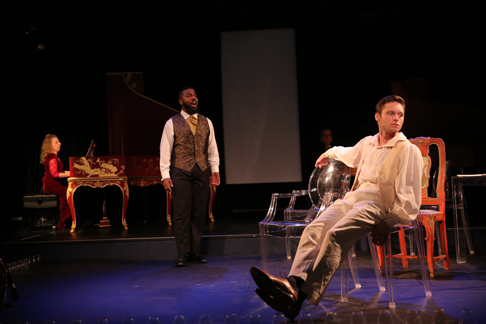 Sidney Outlaw and Bobby Seggert
Sidney Outlaw and Bobby Seggert
The two-hour evening flowed comfortably between Werther's monologues and the chosen Lieder. Bobby Seggert fluctuated between casual emoting and full realization of his tragic situation, with a boyish charm that highlighted the naiveté that ultimately leads to Werther's downfall. James Melo's adaptation for the stage never felt tiresome, but instead engaged the audience between moments of tranquil calm and bitter angst. Indeed, the text adaptation held some of the strongest moments of the evening.
Baritone Sidney Outlaw is one of those consummate professionals who is an absolute pleasure to behold onstage. His rendition of Schumann's Dichterliebe, carefully disseminated throughout Melo's adaptation of Goethe's novella, was crisp, thoughtful, and intelligent. He employed a gentle, intimate style of singing, until the final song when he unleashed a rich baritone voice of impressive size and power.
Mezzo-soprano Rinat Shaham had a rich, shimmering voice that filled the theater well. However, in contrast with Outlaw's easy confidence, Shaham spent the entire concert attached to a musical score on a stand or in her hands. In the context of a chamber music concert, it normally would not be remarkable, but some seeming insecurity with the music created moments of tension in Shaham's voice. She blossomed on songs with which she seemed to have more confidence, in particular on two Liszt songs.
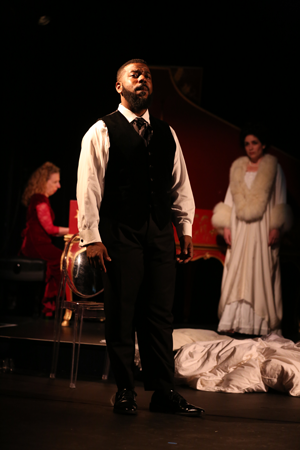 Sidney Outlaw with Rinat Shaham in background
Sidney Outlaw with Rinat Shaham in background
Pianists Eve Wolf and Max Barros gave beautiful performances on piano. Barros in particular made the piano drip with beauty and elegance, with an incomparable grace in his legato.
An evening such as this is something that needs to be done more often. The Ensemble for the Romantic Century manages to make a chamber music concert into so much more, adding drama, narrative, and production value that goes beyond the beauty of an art song concert. Using the inherent drama in German Lieder to create an evening of storytelling is a brilliant way in which to transform the landscape of average concert-going. The Ensemble for the Romantic Century not only does this creatively, but with nimble execution.
Alexis Rodda
image=http://www.operatoday.com/RinatShaham_byJoanMarcus.png image_description=Rinat Shaham [Photo by Joan Marcus] product=yes product_title=German Lieder Is Given a Dramatic Twist by The Ensemble for the Romantic Century product_by=A review by Alexis Rodda product_id=Above: Rinat ShahamPhotos by Joan Marcus
June 12, 2015
Hans Werner Henze: Ein Landarzt and Phaedra
It comprised two operas which date from opposite ends of Henze’s career but which share themes such as the decline in religious certainty and the rise in scientific confidence and optimism, and also create similar sound worlds — a dense chromaticism combined with naturally unfolding melodic arcs, and appealing colourings and timbres.
Originally composed for radio, Ein Landarzt (A Country Doctor) dates from 1951 and is based upon a short story by Franz Kafka, while Phaedra was written for the Berlin State Opera in 2007, five years before Henze’s death, and relates the tragedy of Phaedra and her step-son Hippolytus as told by Euripedes and others, developing the Classical tale to depict the return of Hippolytus from the dead to a world which he finds strange, disorientating and terrifying.
Henze adapted the radio version of Ein Landarzt into a monodrama for Dietrich Fischer-Dieskau. Baritone Martin Hässler showed great courage in taking on the challenge of the role of the country doctor who, woken in the night by an urgent call to attend a sick patient ten miles away, finds himself in a succession of ever more bizarre predicaments. He becomes indebted to a mysterious groom who arrives with a team of horses and who promptly bites the face of his maid, Rosa; he is transported as if by magic to the house of the sick child, who then implores the doctor to let him die; he is forced by the village elders to lie in bed beside the child and threatened with death if he does not heal the boy; ultimately he finds himself condemned to spend eternity struggling to return home.
I wondered whether it would be possible to ‘act’ this surreal tale — or if it was indeed even necessary — but Hässler’s strong dramatic presence and intensely focused musical delivery immediately banished any doubts. The stage set comprised just a few items of simple furniture — a bed, a desk, a cabinet — but as the baritone moved around them, leaned and stood on them, his posture and body language created a dramatic world. He displayed impressive physical and musical stamina and concentration. The vocal part is a demanding one, through-composed and with extensive use of sprechgesang; but the pitch was convincingly well-centred — and confidently projected against an austere instrumental accompaniment, played with precision and clarity by the Guildhall Orchestra, which faithfully evoked the threat and confusion of the doctor’s nightmare.
Hässler’s German diction was exemplary, and a summarising English translation was projected in large font onto the black back wall — creating a slightly alienating effect, not unlike an epic placard. There is much relation of direct speech in the text of the monodrama, and the baritone skilfully used tone and colour to create rhetorical effects which were dramatic and animating. He used his voice not only to make himself a character in his own narration, but he brought the other characters before us too; the soft head voice which embodied the enervating cry of the child was full of pathos without being overly sentimental.
As the Country Doctor relates his experiences he is conversing with himself — questioning events and the reliability of his own memory of his experiences, much like a Schubert lied — as much as communicating with his audience, and Hässler powerfully conveyed the sense of the doctor’s volatility and disquiet in the face of the grotesque twists which turn an ordinary event into a metaphysical mystery.
Phaedra is a larger scale work — Henze termed it a ‘concert opera’, which in the first act innovatively presents the story of Phaedra’s tragic love for her step-son, Hippolytus, and in the second, sees Hippolytus transported to modern-day Italy and brought back to life — under the name of Virbius, by the goddess Artemis — only to find that his consciousness is fragmented and kaleidoscopic. Hippolytus’ identity becomes ever more abstract until it is subsumed into nature itself.
Director Ashley Dean and his designer, Cordelia Chisholm, adopt an imaginative and engaging approach. The first act recreates the ruins of the labyrinth, the grey circular centre of which evoking the sacred horse-shoe arenas of Classical tragedy. The transformation from the ‘Morning’ of Act 1 to Act 2’s ‘Evening’, and from the stark, grey, antique past to the present-day, is effected by the injection of a lurid yellow-green glow which infuses the circular operating theatre (lighting design, Mark Doubleday). Classical gods and goddesses are translated into modern day ‘miracle workers’ — nurses, surgeons — and Hippolytus is revived, given new limbs, a new identity. Dean avoids ‘Rocky Horror Show’ grotesquery, and Hippolytus’ ‘resurrection’ is disturbing but not ludicrous.
In subsequent scenes Hippolytus, struggles to recognise and know his ‘self’, and Dan Shorten’s video designs were very effective in creating an ambience of alienation; tele-screens rose and fell projecting a fragmented sequence of images. The moment when Hippolytus becomes the King of the Woods was startlingly theatrical, as the disorientating static fuzz morphed into vibrant, clean-cut flowers plucked from a Georgia O’Keeffe painting.
Henze’s lean melodic lines were satisfyingly communicated by the cast of five singers. Tenor Lawrence Thackeray exhibited considerable musico-dramatic awareness, even if he didn’t quite have the vocal shine to convey Hippolytus’ heroism. But, his singing unwaveringly balanced lyricism and vigour; this was a fine performance. In Act 1, Phaedra finds Hippolytus asleep in a thicket and sings of her passion for her step-son; Ailsa Mainwaring used the full range of her soprano — from its dusky depths to its gleaming top — to convey the intensity of her sensual desires. Mainwaring was also able to communicate Phaedra’s unpredictability, as she and Laura Ruhl-Vidal’s strongly assertive Aphrodite swore jealous revenge against the one they love. The countertenor role of Artemis was sung by Meili Li, who captured the strange beauty of the goddess’s voice.
The opera’s end is both transcendental and inconclusive. The Minotaur sings, ‘We are all born naked. We press towards mortality and dance’, and bass Rick Zwart’s hymn was rich and life-affirming. It was a shame that the spell had been broken by the descent of the curtain at end of previous scene.
The instrumental playing was again impressive. Henze’s instrumental voices are quite soloistic, and the transparency and depth of the woodwind and brass textures was dramatic — they were capable of powerfully creating the mythic earthquake, but also of spinning sinuous threads of sound. Conductor Timothy Redmond paced things well: the urgency of the first act gave way to more mystical meanderings in the second — there’s a lot of symbolism and metaphor but not much action in Christian Lehnert’s libretto — but Redmond sustained the dramatic moment by foregrounding the textural variety of the score, as groups of instruments formed sub-sets of colour.
The GSMD made two operas that are ‘not quite operas’ seem entirely at home on the stage.
Claire Seymour
Casts and production information:
Ein Landzart : Landarzt, Martin Hässler.
Phaedra : Aphrodite, Laura Ruhi-Vidal; Phaedra, Aisla Mainwaring; Artemis, Meili Li; Hippolytus, Lawrence Thackeray; Minotaur, Rich Zwart.
Timothy Redmond, conductor; Ashley Dean, director; Cordelia Chisholm, designer; Mark Doubleday, lighting designer; Victoria Newlyn, movement director; Dan Shorten, video designer. Guildhall School of Music and Drama, Silk Street Theatre, Barbican, London, Monday 8th June 2015.
image=http://www.operatoday.com/Henze.png image_description=Hans Werner Henze [Photo by Badische Zeitung] product=yes product_title=Hans Werner Henze: Ein Landarzt and Phaedra product_by=A review by Claire Seymour product_id=Above: Hans Werner Henze [Photo by Badische Zeitung]Dido and Aeneas, Spitalfields Festival
The venue describes itself as ‘Part creative community, part arts venue … a non-profit space for creativity and culture in the heart of East London’: ‘High above Great Eastern Street, atop the venue, four recycled Jubilee line train carriages and shipping containers make up the creative studios of Village Underground’ — but for this performance (part of the Spitalfields Festival) by the Armonico Consort and soloists, under the direction of conductor/harpsichordist Christopher Monks, we were located in the main auditorium, a ‘renovated turn-of-the-century warehouse primed for everything from concerts and club nights to exhibitions, theatre, live art and other performances’.
It’s not a very ‘opera-friendly’ auditorium: although one might expect the warehouse to offer helpful reverberation, the high roof sucks up the voices and the T-shaped configuration and absence of raked seating makes it a challenge for the singers to project and communicate. But without undue theatricals the cast, attired in modern evening dress, engaged our attention throughout, aided by energised and colourful instrumental support from the players of the Armonico Consort.
Christopher Monks — musical director and founder of the Armonico Consort — evidently had a clear conception of what he wanted, what was possible given the constraints, and of how to achieve his aims. He whipped the action along at a cracking pace — which did sustain dramatic interest but was not always in the best interests of his singers (the h’s in the ‘Ho, ho, ho’ chorus were entirely lost) — and moved easily between the various tempi and time signatures. Monks urged his players and singers to robust, carefree joy in the chorus, ‘Fear No Danger to Ensue’ — although I’d have liked more rhythmic bite and spring in the dotted rhythms of ‘To the hills and vales’ to complement the vivacious baroque guitar of Robin Jeffrey — and created a sense of spaciousness in ‘Thanks to these lonesome vales’ (for Belinda and Chorus). Monks sought to exaggerate instrumental colours but occasionally this was less successful, for example in scene II, ‘The Cave’, where the dark, resonant bass upset the balance which would allow the harmonic dissonances above to tell.
The cast — the two principal roles were supplemented by members of the chorus — were unfailingly committed and engaging, if varied in their levels of vocal accomplishment.
Elin Manahan Thomas, as Belinda, struggled to project: her soprano was worrying unsupported, the tone was often quite thin, ornaments approximate, and she sounded anxious (and not just because of her fears for her mistress). Perhaps this was why Eloise Irving, taking the roles of the Second Woman, the First Witch and the ‘Spirit’ was assigned some of Belinda’s lines? Irving has a vibrant tone and presence, but she did tire (the Spirit’s trills were rather lacklustre) and found it a challenge to find a distinct vocal colour for each of the three different roles. But, overall, her performance and sustained focus were admirable.
Countertenor William Towers was a Sorceress of the hooty kind and his diction was poor; perhaps he was over-compensating in order to project for in the final chorus, as he faced one section of the audience, I found his singing much more moving and expressive. Penelope Appleyard (singing from the score) rose from the chorus to join Irving in duets for the First and Second Witch; her stringent cackles and snarls may well have been dramatically apt but they gave little clue as to her vocal capacities.
Robert Davies Aeneas was pleasant of tone but made little vocal or dramatic impact (this is not entirely his fault given that the role is underdeveloped — a consequence, perhaps, of the context of the first performance in that the opera was presented by a girls’ school). But the somewhat woolly melodic runs, the approximations ‘covered’ by a wide vibrato, and the lack of yearning lyricism did inhibit the characterisation and the dramatic tension that might be established between Aeneas and Dido.
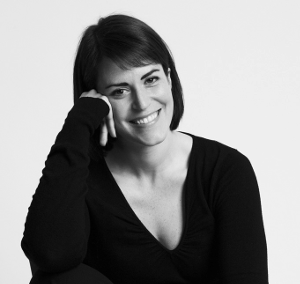 Rachael Lloyd
Rachael Lloyd
As Dido, Rachael Lloyd was in a class of her own. In her first aria, ‘Ah, Belinda, I am press’d with torment’, Monk’s precipitous pace made it hard for Lloyd to convey the depth of Dido’s suffering (the plaintive lament of the ground bass felt rushed and the extraneous vocal ornamentations sounded frivolous and superfluous), but Lloyd’s dark, vibrant lower register was still expressively provocative and theorbo player, Jeffrey, offered a beguiling accompaniment. Subsequently, Lloyd coloured the arioso most intelligently and her diction was excellent. She rose to expressive heights in the opera’s closing stages — ‘But Death, alas, I cannot shun;/ Death must come when he is gone’ — and the revered lament was controlled and focused, even if the line and phrasing did not feel entirely settled and the repetitions of ‘Remember me’ did not quite conjure a penetrating insistence.
The Chorus, processed in and exited as a chain of ‘blind’ prisoners, each connected to his partner by a hand upon the shoulder. The choral tone was appealing and, singing one voice to a part, they made the movements of the inner lines clear. There were some surprises too: just as we expected tenor Matthew Sandy to launch into the First Sailor’s shanty, ‘Come away, fellow sailors, come away’, we found violinist Miles Golding in full voice, and following his vocal exhibition with a surprisingly vigorous string rendition with his baroque bow.
So, this wasn’t an ‘ideal’ Purcellian performance, but it was an honest and entertaining one. The Underground’s clientele were appreciative, Monks was eloquent in introducing his endeavour to the audience, and much pleasure was had by performers and listeners alike. Perhaps next time we’ll venture into one of those Jubilee Line carriages …
Claire Seymour
Cast and production information:
Belinda: Elin Manahan Thomas, Dido: Rachael Lloyd, Aeneas: Robert Davies, First Witch/Second Woman/Spirit: Eloise Irving, Second Witch: Penelope Appleyard, Sorceress/Stage Director: William Towers; Christopher Monks: conductor, Armonico Consort (Matthew Golding and Ben Sansom: violins, Nichola Blakey: viola, Natasha Kraemer: cello, Andrew Durban: double bass, theorbo: Robin Jeffrey), Chorus (Penelope Appleyard, Eloise Irving, William Towers, Matthew Sandy, Robert Davies). Spitalfields Music Summer Festival 2015, Village Underground, Shoreditch, London, Tuesday 9th June.
image=http://www.operatoday.com/Manahan-Thomas-Elin-12%5B2007%5D.png image_description=Elin Manahan Thomas product=yes product_title=Dido and Aeneas, Spitalfields Festival product_by=A review by Claire Seymour product_id=Above: Elin Manahan ThomasIntermezzo, Garsington Opera
Well, only if you take as given the increasingly untenable assumptions some ‘major’ opera houses trumpet concerning their audiences – and perhaps not even then. That Birmingham Opera can sell out Stockhausen immediately and that the Royal Opera House – by any standards, a different animal – can sell out operas by Benjamin and Birtwistle puts paid to lazy talk and should put paid to lazy programming, though does so far less often than should be the case. If one takes as one’s core lazy listeners, consequences will follow; if one leads, and especially if one acts upon widespread thirst for modernist repertoire, broadly conceived, other, better consequences will do so. Strauss, it might be countered, is a different matter again, and perhaps he is. But he is hardly unpopular, and if many people have not heard Intermezzo, despite a recent staging at Buxton, then grant them an opportunity such as Garsington has.
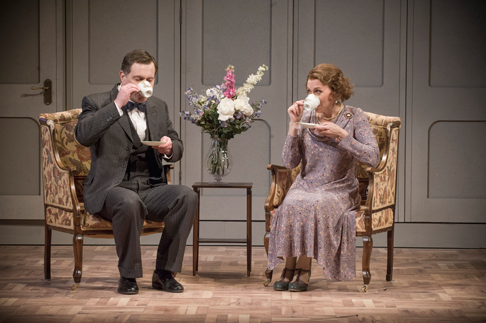 Mark Stone as Robert and Mary Dunleavy as Christine
Mark Stone as Robert and Mary Dunleavy as Christine
An excellent performance was given by the Garsington Orchestra – only once, early in the second act, did I sense a little tiredness – under the baton of Jac van Steen. The conductor’s deep knowledge and understanding of the score, of its post-Ariadne idiom, of its opportunities and challenges had been displayed in my interview with him; it was displayed just as clearly here. Everything was in its place, as it must be; Strauss at his most unsparing allows no room for error. The orchestral interludes put me a little in mind of the ‘closed forms’ of Busoni and Berg, whilst very much retaining their own character. It was perhaps most of all, though, Strauss’s economy, which yet never denies his love of musical proliferation, that shone through. Not a note is wasted; nor was it in performance.
The cast proved persuasive advocates too. Mary Dunleavy’s vocal security was matched to a subtle reading of Christine’s character that extracted her from the realm of patronising, even misogynistic caricature: no mere ‘shrew’ here, but a credible woman of strengths, weaknesses, above all agency. Mark Stone made a powerful impression as her husband, perhaps the closest of all Strauss came to a self-portrait. (The creator of the role wore a mask so as to make him resemble the composer all the more closely. As Norman del Mar observed, this was a ‘striking volte-face after Strauss’s anxieties over the Young Composer in Ariadne’.) One could have taken dictation, verbal as well as notational, from most of his crystal-clear performance: Lied writ large in the best sense. Sam Furnes’’s Baron Lummer offered a well-judged mixture of vocal allure and immaturity of character. Ailish Tynan’s perky Anna proved just the right sort of knowing, informed servant. In a fine company performance, other singers to stand out included Oliver Johnston’s finely sung – and acted – Stroh, Gerald Collett’s equally impressive Legal Counsellor, and Benjamin Bevan’s honourable Notary. Everyone, however, made a considerable contribution.
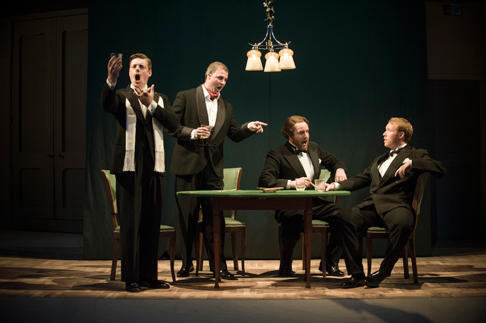 Barnaby Rea (Singer), James Cleverton (Commercial Counsellor), Oliver Johnston (Stroh), Gerard Collett (Legal Counsellor)
Barnaby Rea (Singer), James Cleverton (Commercial Counsellor), Oliver Johnston (Stroh), Gerard Collett (Legal Counsellor)
Bruno Ravella’s production takes the work seriously, on its own terms, and succeeds accordingly. Giles Cadle’s resourceful set moves us in and out of a Garmisch-style villa, modern (to Strauss), without being avant garde. There is always a strong sense of who everyone is, and why he or she is acting in the manner we observe. The card game is, as the conductor observed to me, wonderfully, knowingly realistic; such understanding could hardly be feigned. The crucial element of communication and its speed – the telephone, the telegram, Strauss’s pace of conversation delivery – offered an excellent example of musical performances and production acting as one.
One can speak of the plot being trivial, if one wishes. (I suppose one can speak about anything if one wishes, so that was an especially meaningless claim!) But some of that seems to be snobbery; would we think differently, were these gods, or indeed from another class, ‘higher’ or ‘lower’. In his original Preface, replaced when the score was published, Strauss not unreasonably claimed to break genuine new ground in the variety of everyday life he had brought to the stage; Hindemith and Schoenberg would follow suit in Neues vom Tage and Von heute auf morgen. Still more to the point, though, (high) bourgeois domesticity matters to those involved in it; it certainly matters to the little boy caught at the centre of marital dispute and potentially breakdown, as countless children, sleepless with worry at raised voices downstairs, will tell you. (Young Louis Hynes deserved great credit for his portrayal of that difficult role, here rendered more difficult still.) Now Intermezzo is not essentially ‘about’ that, although I think it is more concerned with it than, say, Elektra is; but a subtle yet perceptible shift in that direction from the production did no harm in opening up the work.
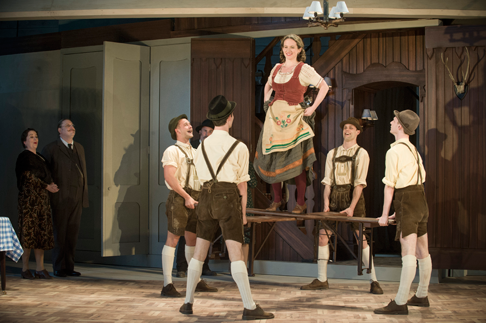 Sarah Redgwick as the Notary’s Wife, Benjamin Bevan as the Notary, and Anna Sideris as Resi
Sarah Redgwick as the Notary’s Wife, Benjamin Bevan as the Notary, and Anna Sideris as Resi
Only one gripe, really: it was a great pity that the opera was sung in English, and that Andrew Porter’s translation was the version used. Given surtitles, there really is no need; Strauss really does not sound right in translation, still more so as here, when odd words remained in German, the contrast jarring. Moreover, accents tended to slide – or at least to slide more noticeably to an English ear. But, as ever with Strauss, in the battle of Wort with Ton, there was little doubt which would emerge victorious. This was a far from insignificant victory over Strauss’s critics, Garsington’s latest estimable contribution to a hero’s after-life.
Mark Berry
Cast and production information:
Robert Storch: Mark Stone; Christine: Mary Dunleavy; Anna: Ailish Tynan; Franzl: Louis Hynes; Baron Lummer: Sam Furness; Notary: Benjamin Bevan; Notary’s Wife: Sarah Sedgwick; Stroh: Oliver Johnston; Commercial Counsellor: James Cleverton; Legal Counsellor: Gerard Collett; Singer: Barnaby Rea; Fanny: Alice Devine; Marie: Elka Lee-Green; Therese: Charlotte Sutherland; Resi: Anna Sideris. Director: Bruno Ravella; Designs: Giles Cadle; Lighting: Bruno Poet. Garsington Opera Orchestra/Jac van Steen (conductor). Garsington Opera House, Sunday 6 June 2015.
image=http://www.operatoday.com/Intermezzo-2015-Garsington-Opera-Mary-Dunleavy-Christine-credit-Mike-Hoban.png image_description=Mary Dunleavy as Christine [Photo by Mike Hoban] product=yes product_title=Intermezzo, Garsington Opera product_by=A review by Mark Berry product_id=Above: Mary Dunleavy as ChristinePhotos by Mike Hoban
June 8, 2015
Cosi fan tutte, Garsington Opera
Though the opera is extremely popular, modern taste has problems with the deliberate artifice of the theatrical concept used and many directors nowadays choose to adjust the ending, moving the plot towards greater realism. For his debut production at Garsington Opera, director John Fulljames chose to set the Cosi fan tutte (seen 7 June 2015) in a milieu which would be familiar to many of the audience, a contemporary country house wedding. The lovers were played by a nicely balanced quartet of young singers, Andreea Soare, Kathryn Rudge, Robin Tritschler and Ashley Riches, with Lesley Garrett as Despina and Neal Davies as Don Alfonso. Designs were by Dick Bird, lighting by Bruno Poet and choreography by Tim Claydon. Douglas Boyd, artistic director of Garsington Opera, conducted the Garsington Opera Orchestra.
The opera opened with something of a visual coup, the wedding breakfast at a country house wedding. The men, including the groom, were largely from Ferrando and Guglielmo’s regiment, including Don Alfonso who seemed to be their colonel. The bride and most of the young women were in fancy dress, in elaborate 18th century costumes. During the overture the party broke up and dancing, formal at first, started.
This was the context for the whole production. John Fulljames and Dick Bird might have re-set it in modern Britain, but had clearly read the libretto and the entire action took place within one day. This was one of those weddings from hell which go one interminably and everyone gets drunk, with much hi-jinks from the young men of the regiment. For the second act, the marquee had been re-configured slightly but this was a simple and elegant solution to creating a fluid flow of scenes within Garsington Opera’s rather limited stage facilities. And the production did flow. John Fulljames ensured that the action moved along, and scenes flowed into each other, whilst Douglas Boyd’s speeds with crisp to the point of briskness.
However, John Fulljames gave the opening pair of scenes an entirely new context by having them played ensemble. The discussion and wager between Don Alfonso (Neal Davies), Ferrando (Robin Tritschler) and Guglielmo (Ashley Riches) played out in front of the whole company including Fiordiligi (Andreea Soare) and Kathryn Rudge (Dorabella). The two women’s scene (intended by Mozart and Da Ponte as a complementary pair to the first) was played almost as a revenge for this, with Ferrando and Guglielmo acting as unwilling, live portraits. This, combined with Neal Davies’ slightly aggressive manner as Don Alfonso, put rather a nasty, knowing edge on the whole construct.
Thereafter the action unfolded pretty much as the libretto requested, except that very rarely were people alone; this was a wedding so much wandering about happened and the principals tended to constantly eaves drop on each other. Lesley Garrett’s Despina was more wedding planner than maid, and the mesmer scene at the end of Act 1 was played straighter than usual with Lesley Garrett as a St John’s Ambulance woman wielding a defibrillator.
The production set up multiple layers of artifice over the top of, and deliberately obscuring, the theatrical artifice of the plot. The women played Act 1 in their 18th century costumes complete with huge wigs whilst the men’s formal regimental dress had a timeless element and by re-setting the first two scenes it was unclear quite who was knowing what about whom. The male lovers’ Albanian disguise was in fact sub Vivienne Westwood of 20 years ago, with a pair of nasty wigs and some very fake facial hair, some of which deliberately came off during the women’s first meeting with the Albanian. The garden for the Act 2 serenade was an entirely artificial grotto constructed within the marquee.
Though in one area there was no artifice, the ‘token’ that Guglielmo receives from Dorabella was in fact a pair of panties, but this simply reflected the level of smut and corny sex-related gags in the production (Despina and a young man disappearing under a table, which shuddered perpetually during Don Alfonso’s following scene).
One of the problems, of course, with Cosi fan tutte was that within a plot full of the traditional artifice of opera buffa, Mozart introduced many elements from opera seria so that arias like Fiordiligi’s ‘Come scoglio’ are moments of pure serious opera. One of the joys of the production was the high level of the musical performance. All four of the young lovers, Andreea Soare, Kathryn Rudge, Robin Tritschler and Ashley Riches sang with a combination of style and technical precision. All produced extremely creditable elaborate passage-work even at the fast-ish tempos.
Romanian soprano Andreea Soare made a charming Fiordiligi, rather more girlish and less severe than sometimes. She and mezzo-soprano Kathryn Rudge made a lovely balanced pair with the two reflecting each other rather than being complementary. Their voices blended well, with Andreea Soare having a lovely warm soprano with a nicely rich middle range though the tone suffered at the very lower end of the tessitura. Both sisters skittishly egged each other on, and it was only when the going got tough in Act 2 that Andreea Soare’s Fiordiligi brought out the character’s uncertainty. Her account of ‘Come scoglio’ (with its taxing leaps) was technically very strong, notable for its fluid flexibility and the way the aria seem less severe than usual. Kathryn Rudge was a complete delight as Dorabella. If Fiordiligi was less severe than usual, Dorabella was perhaps less skittish. Kathryn Rudge executed both arias with a lovely casualness, for all their technical complexity, making them less statements and simply part of the natural flow.
Robin Tritschler and Ashley Riches were more obviously contrasting, in terms of their voices and their characters. Robin Tritschler’s Ferrando was the quieter one, with moments of uncertainty and a certain callowness underlying the sometimes brash manner. This was allied to Robin Tritschler familiar lyric tenor voice with which he caressed the tenor line beautifully, making ‘Un’aura amorosa’ almost heart-stoppingly beautiful, particularly the pianissimo second verse. Ashley Riches’ Guglielmo was the more brash one, almost a braggart and Ashley Riches used his remarkable dark baritone to strongly characterful effect. His account of ‘Non siate ritrosi’ was a comic delight as he elucidated his many charms (making one particular one very clear). Though the voice is quite dark, there was no lack of flexibility with an admirably free top. The two made a strong double act, clearly having fun on stage as the Albanians.
But the singers’ performances ensured that we recognised the real emotional damage of the action. As Act 2 progressed the tint of the evening got darker, there was no stinting here on the underlying hurt that the games make, something Mozart’s music makes abundantly clear.
Despina is a role that Lesley Garrett has sung extensively earlier in her career though her recent appearances in opera have been relatively few. It is clear that the middle of the voice is not what it was, and the recitative relied rather heavily on comic timing rather than accuracy of notes. Overall she gave a bravura comic performance whose impact, frankly, was more visual than aural.
Neal Davies was an unregenerate cynic as Don Alfonso, with the wedding bringing out the worst in him and being the regiment’s colonel was obviously a reason for the two young men obeying him. I would have liked more back story, why is he like this. The cynicism seemed to affect Neal Davies musically as his performance, though accurate, seemed to have a harder edge than usual. This was a highly believable performance, but certainly not the most likeable.
The young chorus sang their role beautifully and clearly had a great time during the rest of the opera, with the young men lurching drunkenly around the gardens at various times.
In the pit, Douglas Boyd and the Garsington Opera Orchestra made brilliant work of Mozart’s score. But though speeds were on the faster side, it was never too driven and you felt Boyd was allowing time for the music to shape. The various instrumental solos which Mozart’s gives the orchestra members were all finely done. We had a lively, but not intrusive, forte-piano and cello continuo from Andrew G Smith and Jane Fenton.
The production is a co-production with Bucharest National Opera and I do wonder what the audience in Bucharest will make of all the hi-jinks at a typical British country house wedding.
For the ending, John Fulljames seems to have followed his instincts for realism, and we were left in no doubt that there was no resolution, with neither of the possible pairings happening and all the characters left alone. A very modern solution but surely no one which Mozart would have appreciated.
I have to confess that John Fulljames sense of detail in the production did get a bit wearing after a bit. The sense of realism even extended to Andrea Soare and Kathryn Rudge being dressed in costumes supposedly made last minute from bits of the furnishings of the marquee. I would have preferred the setting to have been somewhat calmer and simpler. Whilst John Fulljames and Douglas Boyd elicited fine performances from all the singers, rather than illuminating this complex and subtle opera, the setting seemed to reduce it. The evening was redeemed, however, by the strong musical performances.
Robert Hugill
Cast and production information:
Fiordiligi: Andreea Soara, Dorabella: Kathryn Rudge, Ferrando: Robin Tritschler, Guglielmo: Ashley Riches, Despina: Lesley Garrett, Don Alfonso: Neal Davies. Director: John Fulljames, conductor: Douglas Boyd, designer: Dick Bird, lighting: Bruno Poet, choreographer: Tim Claydon. Garsington Opera at Wormsley, 7 June 2015.
image=http://www.operatoday.com/GO-Pavilion-Clive-Barda.png image_description=Garsington Opera Pavilion [Photo by Clive Barda] product=yes product_title=Cosi fan tutte, Garsington Opera product_by=A review by Robert Hugill product_id=Above: Garsington Opera Pavilion [Photo by Clive Barda]The Queen of Spades, ENO
The protagonist, Hermann, is selfish, obsessive and remorseless: fixated on the pursuit of love and riches, in his fanatical determination to learn the secret of the three cards he threatens to shoot the Countess, who drops dead from fright. Later, he abandons his beloved Lisa, who goes on to drown herself. Tchaikovsky, however, gives us a more sympathetic hero: a mysterious, romantic figure, wrought by passionate yearnings and suffering which are eloquently conveyed.
One question which haunts both novel and opera is, ‘Is he bad or mad?’ Pushkin’s epilogue seems to leave no doubt: the novelist’s Hermann pays for his self-regarding mania with his sanity. His mind torments him: he imagines that he sees the dead Countess winking at him as she lays in her open coffin; then, she comes to him in his room, an apparition promising the secret of the three cards if Hermann marries Lisa and renounces gambling. In one final game, believing he is playing an ace, he turns over the Queen of Spades — which copies the Countess’s wink. Hermann loses both his money and his mind, and is condemned to an asylum where, trapped in his neurosis, he mutters unremittingly, ‘Three, seven, ace! Three, seven, queen!’ What is less clear, though, is whether Hermann’s visions are just a drunken dream, have sprung from his own paranoia and twisted passions, or whether he really has communed with black spirits from ‘the other side’.
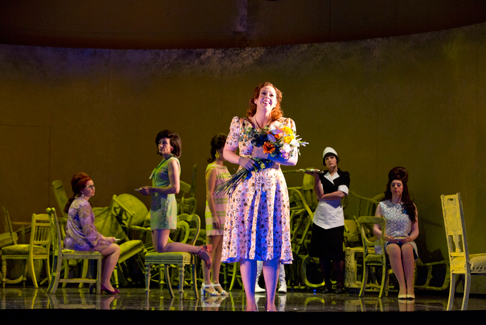 Giselle Allen as Lisa with ENO chorus
Giselle Allen as Lisa with ENO chorus
David Alden’s new production for ENO, with designs by Gideon Davey, begins in the asylum: sitting alone on a sparse iron bed-stead, under the unforgiving glare of a hanging lampshade and the passive gaze of an unmoving clock-face stuck obstinately at five minutes to midnight, Hermann’s mental and emotional distress are clear. Women and children ‘promenade’ in the sunshine outside (or rather appear through a sliding hatch set into the chilly green walls of the institution), but Hermann is as isolated from this normality as he is from the uniformed aristocrats who swig champagne, chain-smoke, and try to guess Hermann’s dark secret. The sickly light (Lighting design, Wolfgang Goebbels) is broken by the flashes and shadows of the coming storm, which disperses the crowds and foreshadows the trouble ahead. A carved angel — which seems to have stepped out of one of Gustave Doré illustrations for Paradise Lost — perches aloft.
In the second scene, the asylum wall is raised to reveal Lisa’s vast ‘chamber’. It’s hardly a boudoir, more of a ballroom — a sort of Wonderland, where Tchaikovsky’s spinet has morphed into a grand piano, the chairs have taken on a life of their own, leaping and landing in a byzantine mound, and the fallen angels have multiplied. The time-scheme also becomes somewhat ambiguous. Alongside the Red Army uniforms, Lisa is attired in a rather un-fetching apricot 1940s frock, while Pauline and her friends sport the minis, PVC and psychedelic print of the 60s.
And, if at this point Alden starts to blur time and place, in the Masquerade Ball that follows things really get skewed. After the tableau of the ‘Faithful Shepherdess’ (the sliding hatch comes in useful, retreating to provide a ready-made stage platform), the arrival of a bar-tender wearing a blue anthropomorphic animal head signals that the masked ball is about to become a plush party. For those not in the know, Alden provides a helpful programme note: ‘A plushie is an individual who has a strong, usually erotic, attraction to stuffed animals … Plush parties are adult lifestyle events for which people dress up in life-size furry animal costumes often for the purpose of anonymous sex’. So, served champagne by a periwigged, purple frock-coated, outsize sun-glass donning Karl Lagerfield look-a-like, the hippies and hipsters — elephants, bears, pandas, wolves — indulge in a furry frenzy of orgiastic pleasures. The one moment of sanity is Prince Yeletsky’s passionate aria to Lisa — sung with a lovely round tone and impassioned sentiment by baritone Nicholas Pallesen.
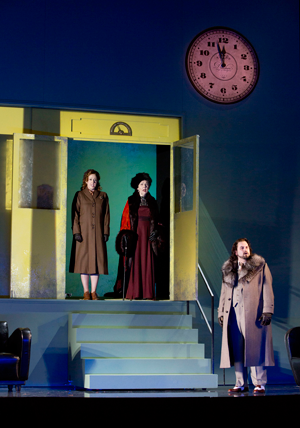 Giselle Allen as Lisa, Felicity Palmer as the Countess, and Nicholas Pallesen as Prince Yeletsky
Giselle Allen as Lisa, Felicity Palmer as the Countess, and Nicholas Pallesen as Prince Yeletsky
Disco-chandeliers resembling pendulous cellular atoms cast garish gleams and shadows, and as Goebbel’s lights swirl we are not sure if this a drunken maelstrom or mad delusion. But, some might argue that in this regard Alden is true to Pushkin, in whose fantastical tale the dividing line between fantasy and actuality is difficult to distinguish. Alden takes us inside Hermann’s mind in which supernatural phantasmagoria mingle with the erotic and manic imaginings of his own subconscious. The problem is that the tight emotional drama established in the opening scene has been sacrificed for the sake of Alden’s trademark visual and ‘erotic’ overload, and the tension dissipates as the animal heads are tossed in the air.
Fortunately, after the interval the furry friends go back to the zoo, and things get back on track. Indeed, the confrontation between Hermann and Felicity Palmer’s Countess is the heart of production. Palmer, a frail figure in a white nightgown — a cross between a Miss Havisham and a Bertha Mason — emits an eerie Gothic pallor, but is still a terrifying force when she interrupts the assignation of Hermann and Lisa in the second scene and demands that Lisa close the window and go to bed. We see what Hermann is up against: for the Countess is both a literal barrier between Hermann and his love, and an embodiment of the secret knowledge which he desires. At the start of Act 2, Palmer occupies a lone chair in the centre of the wide stage and her chillingly quiet but penetrating rendition of ‘Je crains de lui parler la nuit’ seals Hermann’s fate.
Tenor Peter Hoare takes on the title role. Although he seemed vocally underpowered at the start, Hoare grew in dramatic and vocal stature as the evening progressed, coping well with the demands that Tchaikovsky makes on the singer’s stamina, strength and tessitura. Hoare shows us the disintegration of Hermann’s mind, and his scene with Palmer’s Countess is terrific: by the end of the opera we have witnessed the painful psychotic breakdown of Hermann’s ‘mad aria’ and a delirious final scene of great power and pathos. But, as he lurches from passion to despair, Hoare doesn’t have quite enough lyric warmth to capture the devil-may-care heroism of Pushkin’s and Tchaikovsky’s Byronic bad boy, or to fully win our sympathy.
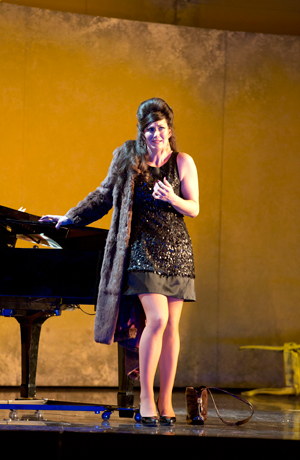 Catherine Young as Pauline
Catherine Young as Pauline
Moreover, it’s a big weakness of this production that there is almost no spark of passion, even genuine interest, between Hoare and Giselle Allen’s Lisa. Alden presents Hermann wandering in a hinterland between neurosis and psychosis, which may be true to Pushkin’s tale, but Tchaikovsky gives us a slightly different story — a love-triangle which ends with a double-suicide. By inventing a new character, the worthy Prince Yeletsky, Tchaikovsky and his librettist (his brother Modest) offer a foil to Hermann and a rival for Lisa’s devotions — a human story alongside the Gothic equivocations. In Alden’s production, there is no love, only sex and gambling. In the penultimate scene, realising that Hermann revered the cards above her, Allen sang with real vocal power and expressive impact, but it was rather too late in the day for us to believe that there was genuine love between her and Hermann. Lisa’s interactions with the vampish Pauline — the latter role was sung with voluptuous richness and manner by Catherine Young, working her way through an array of eye-catching lamé mini-dresses — and her maid Masha (Katie Bird), were more convincing. The rest of the supporting cast were accomplished, especially Gregory Dahl who, as Tomsky, exhibited a relaxed manner, robust tone and superb diction.
The enlarged ENO Chorus were superb: stentorian in the rumbustious numbers, wonderfully compassionate and restrained in their final muted pleading for pardon and rest for Hermann’s raging spirit. Edward Gardner, in his last production as Music Director, conducted the ENO Orchestra with the combination of precision, clarity and dramatic sweep to which we have become accustomed. In the orchestral prelude we had both the tenderness of Hermann’s love and the turbulence of his fate motif. He both urged his singers on, and supported sympathetically: in the Countess’s aria, the low vocal line was never overwhelmed yet we could hear every nuance of the clarinet commentary, the muted string lines and eerie viola gestures. The players gave their all, through the gamut of the opera’s different styles: we had a vivacious polonaise for arrival of Catherine the Great, and Classical grace for faux Mozartian accompaniment to the tableau (a fitting parody, of course, for in Act Two of Mozart’s The Magic Flute, the bird-catcher Papageno declares he will hang himself because he fears he has lost his beloved Papagena — a parodic foil to Hermann’s angst).
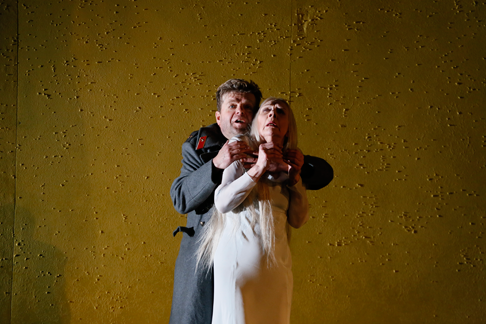 Peter Hoare as Hermann and Felicity Palmer as the Countess
Peter Hoare as Hermann and Felicity Palmer as the Countess
ENO will be hoping that the trick of the cards will play its part in assuaging their own financial problems. And, there are many dramatic and musical treats that merit taking a gamble on a ticket. However, the final scene in which, having witnessed Hermann’s demise, the aristocratic in-set nonchalant drink, smoke and flick cards into the air, seems hard of heart. Alden suggests: Hermann is gone and forgotten and let that be a lesson to you all. But, given that Hermann has paid with his soul, he might have been offered more compassion.
Claire Seymour
Cast and production information:
Hermann: Peter Hoare, Count Tomsky: Gregory Dahl, Prince Yeletsky: Nicholas Pallesen, The Countess: Felicity Palmer, Lisa: Giselle Allen, Pauline: Catherine Young, Chekalinsky: Colin Judson, Surin: Wyn Pencarreg, Chaplitsky: Peter Van Hulle, Narumov: Charles Johnston, Governess: Valerie Reid, Masha: Katie Bird; Director: David Alden, Conductor: Edward Gardner, Designer: Gideon Davey, Lighting designer: Wolfgang Goebbel, Choreography: Lorena Randi. English National Opera, London Coliseum, Saturday 6th June 2015.
image=http://www.operatoday.com/Peter_Hoare_ENO.png image_description=Peter Hoare as Hermann [Photo © Donald Cooper] product=yes product_title=The Queen of Spades, ENO product_by=A review by Claire Seymour product_id=Above: Peter Hoare as HermannPhotos © Donald Cooper
June 7, 2015
Il trittico, Opera Holland Park
At any rate, there is now no more need, if ever indeed there were, to ‘make allowances’, and it is difficult really to consider a company with such extensive programming as Opera Holland Park to be in any meaningful sense ‘smaller’. This new production — reusing its 2012 Gianni Schicchi — of Puccini’s complete Trittico may well be the best thing I have yet seen and heard at Holland Park.
Yet again, any reservations I might pre-emptively have held in abstracto concerning a small-ish orchestra (the outstanding City of London Sinfonia, strings 6:5:4:3:2) vanished within a few bars; the acoustic may sound unpromising in an unpromising performance, but in one such as this, with truly excellent conducting throughout from Stuart Stratford, there was no problem whatsoever. Dynamic contrasts and continuities could hardly have been more powerfully — and sensitively — communicated. Climaxes were shaped with unfailing conviction, matched, one felt, with as true an understanding as Puccini’s own of the dramatic ebb and flow. Indeed, the importance of rhythm, and its inextricable alliance to increasingly adventurous harmony, was projected in Il tabarro as almost a symphonic poem of the Seine itself — were that not woefully to underplay the role played by Stratford’s splendid cast. The post-verismo (if in fact we are post-) darkness of the score, lit by shards one might relate to Stravinsky, Schoenberg, or Debussy, but which one would be quite wrong to consider in any sense derivative, told of a Paris both distinct from and yet related to La bohème, Puccini’s self-quotation playful acknowledgement rather than necessity, so deeply imbued with style and meaning was the musical account.
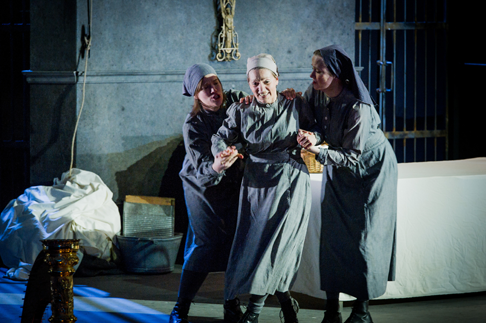 A scene from Suor Angelica
A scene from Suor Angelica
Different colours, different sound-worlds presented themselves in Suor Angelica and Gianni Schicchi, the tragic noose tightening inexorably in the former, all the more powerfully for its radiant feminity (from which Poulenc surely learned so much in Dialogues des Carmélites. I initially hardly felt like hearing the latter, immediately following the tragic denouement of Suor Angelica. Performance put me right, the revels now begun of a scherzo as full of zest and the comedic complexities of commedia dell’arte as the Petrushka score that more than once came to mind. Nothing was permitted to outstay its welcome, ‘O mio babbino caro’ for once a genuine moment of well-natured self-parody rather than a would-be reversion, in which members of the audience may sit back and ‘enjoy’. Indeed, Dante’s great comedy itself seemed to loom over the enterprise as a whole — just as, in very different circumstances, it had over Calixto Bieito’s brilliant Berlin double-bill of Schicchi and Bluebeard’s Castle earlier this year.
The casts were also as fine as I can recall from OHP, perhaps even finer still. Even given a certain amount of duplication, the number of singers involved is large, so as often put a strain upon one of those ‘larger’ houses. Here, no one disappointed, and the whole, as the well-worn cliché has it, was considerably greater than the sum of its parts; indeed, there was a real sense of company, such as one is more likely nowadays to find in relatively ‘smaller’ circumstances. Anne Sophie Duprels convinced equally in the conflicted roles of Giorgetta and Suor Angelica, her musical and dramatic focus and shaping every inch the equal of Stratford’s. Stephen Gadd and Jeff Gwaltney had one believe just as strongly in them and their plight in Il tabarro; it may not be a lengthy opera, but these felt like fully drawn characters, and the ‘smaller’ parts offered much of great interest too. So did those in the other two operas. Other singers to stand out — although it hardly seems fair to do anything but repeat the cast list — were a vehement, Rosalind Plowright as La Zia Principessa, nobler than the convent hierarchy, but possessed of similar, ruthless, yet perhaps ultimately more conflicted coldness. Family lines exert their own pressure, as we should shortly be reminded in Gianni Schicchi. Richard Burkhard’s protean Schicchi, Sarah Pring’s slightly but not too outlandish Zita, and Anna Patalong’s beautifully sung Lauretta headed a cast of true depth in that final instalment.
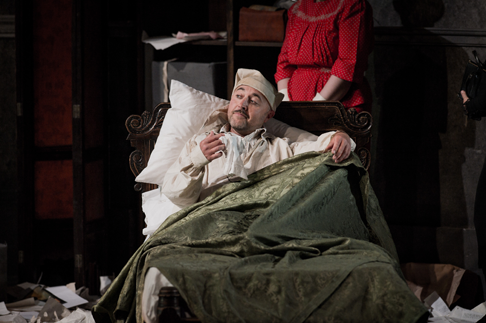 A scene from Gianni Schicchi
A scene from Gianni Schicchi
As night fell, the qualities of the three productions declared themselves in different ways; that change in light — and temperature — proved especially telling during the course of Suor Angelica. Neil Irish’s arched backdrop for Il tabarro, commenting yet expanding upon the ruins of Holland House, moved to the foreground for the laundry — inevitable thoughts concerning convent repression there — in Suor Angelica and the bedroom for Gianni Schicchi, laundered clothes serving dual purpose in the two latter operas. There was, however, no attempt to force the three operas closer together than that; they told their own stories, and we made connections as we would. Martin Lloyd Evans ( Il tabarro and original director of Gianni Schicchi) and Oliver Platt (Suor Angelica and revival director of Schicchi) respected the works, which in turn seemed to respect them for it. Movement and designs were in keeping with the dictates of the action, scenic and musical alike, keenly observed without drawing undue attention. The tragedy and comedy of human existence were the focus, from pit and stage alike.
Mark Berry
Cast and production information:
Michele: Stephen Gadd; Giorgetta: Anne Sophie Duprels; Luigi: Jeff Gwaltney; Frugola: Sarah Pring; Tinca: Aled Hall; Talpa: Simon Wilding; Soprano Amante: Johane Ansell; Tenor Amante: James Edwards; Sister Angelica: Anne Sophie Duprels; Princess Zia: Rosalind Plowright; Abbess: Fiona Mackay; Monitress: Laura Woods; Mistress of the Novices: Kathryn Walker; Sister Genovieffa: Johane Ansell; Sister Osmina: Kathryn Hannah; Sister Dolcina: Rosanne Havel; Nursing Sister: Chloë Treharne; Alms Sisters: Anna Patalong, Sarah Minns; Novices: Naomi Kilby, Ellie Edmonds; Lay Sisters: Rebecca Hardwick, Chloe Hinton; Child: Matteo Elezi; Gianni Schicchi: Richard Burkhard; Zita: Sarah Spring; Lauretta: Anna Patalong; Rinuccio: James Edwards; Gherardo: Aled Hal; Nella: Elin Pritchard; Betto: Simon Wilding; Simone: William Robert Allenby; Marco: Ian Beadle; La Ciesca: Chloe Hinton; Spinelloccio: Henry Grant Kerswell; Gherardino: Barnaby Stewart; Buoso: Peter Benton. Directors: Martin Lloyd-Evans, Oliver Platt; Designs: Neil Irish. Lighting: Richard Howell. City of London Sinfonia/Stuart Stratford (conductor). Holland Park, London, Friday 5 June 2015.
image=http://www.operatoday.com/Trittico_OHP.png image_description=Il Tabarro product=yes product_title=Il trittico, Opera Holland Park product_by=A review by Mark Berry product_id=Above scene from Il TabarroFlight, Opera Holland Park
At Opera Holland Park, the work was directed by Stephen Barlow withBrad Cohen conducting theCity of London Sinfonia.James Laing sang the Refugee, withJennifer France as the Controller,Jeffrey Lloyd-Roberts as Bill,Ellie Laugharne as Tina,Lucy Schaufer as the Older Woman,Kitty Whately as the Stewardess,George von Bergen as the Steward,Nicholas Garrett as Minksman,Victoria Simmonds as Minkswoman and John Savournin as Immigration Office, with lighting by Richard Howell, movement by Sam Spencer-Lane and video design by Jack Henry James.
Flight was commissioned by Glyndebourne, and premiered by Glyndebourne on Tour in 1998 with it going on to receive a main stage production in 1999. Glyndebourne revived the work in 2005 and British Youth Opera performed it in 2008 (in a production by Martin Lloyd Evans with Andrew Radley as the Refugee, Nicky Spence as Bill and Duncan Rock as the Steward). But rather amazingly this was the first time that a professional company had staged the work in London; a long overdue debut.
One of the beauties of Flight is that April de Angelis’s witty libretto is quite traditionally structured and is unashamedly an opera (rather than trying to pretend it is play where the characters happen to sing). So it is in three acts, with entrance arias for each of the characters, and a great use of ensemble. Reading a summary the piece could almost be a libretto for one of Rossini’s comedies. But within this Jonathan Dove’s music brings an accessible, yet contemporary resonance to everything. And though April de Angelis’s characters are simply archetypes, Jonathan Dove’s music fleshes them out and gives them humanity.
One of the strengths of Stephen Barlow’s production was that it took the whole piece seriously, so that each member of the cast created a naturally believable and real person. Yes, some parts were funny. Achingly so in the case of Kitty Whately and George von Bergen (Stewardess and Steward) with their tryst in the lift, with the lift doors repeatedly flashing open to reveal yet more flesh (this was definitely NSFW) and a more exotic pose; poignantly so in the case of the bickering of Jeffrey Lloyd-Roberts and Ellie Laugharne (Bill and Tina), a couple whose marriage is going on the rocks. But clearly the whole cast had great fun and the other strength of the production was that this was a real strong and balanced ensemble.
The plot is quite simple. Set in an airport terminal overseen by the Controller (Jennifer France) in her eerie high above the concourse, the Refugee (James Laing) is marooned there unable to enter or leave because of lack of papers (the plot was based on a real life case), constantly waiting for his brother who has his papers. Around him people come and go, and he scrounges bits and pieces to eat. We meet Bill and Tina (Jeffrey Lloyd-Roberts and Ellie Laugharne), hoping a holiday will bring back the sparkle in their relationship, and very dependent on a self-help book for relationship advice. The Older Woman (Lucy Schaufer) has come to meet her younger lover from Spain where she met him in holiday, he is 30 years younger than her and all she has is a postcard from him. Minksman and Minkswoman (Nicholas Garrett and Victoria Simmonds) are travelling to Minsk as he is a diplomat. She is heavily pregnant and at the last minute refuses to go, he goes alone. The Steward and Stewardess (Kitty Whately and George von Bergen) are both travelling to different destinations and grab their 17 minutes together for that quick tryst. The final piece in this jigsaw is the Immigration Officer (John Savournin) who appears periodically and forces the Refugee to hide.
An electrical storm cancels all flights and forces to them all to spend the night. The Refugee gives each of the women a magic stone to help them, in return for them helping him when the time comes. Feelings intensify in the confinement, the Steward and Stewardess find that their relationship only works when they are pressured for time, Tina and Bill bicker constantly with her saying that he is boring, the Older Woman loses confidence that her fiance is coming, the Controller gets jealous that the Refugee no longer focuses his attention on her, but concentrates on the other people. Strange things happen, going off on a wander to find the Stewardess, Bill finds the Steward and the two go off to drink and smoke dope, resulting in another hilarious tryst. The women all find out that the Refugee has given each of them a stone, they attack him and bundle him into the lift.
The last act sees flights resumed and relationships settled. Bill is no longer boring, and a bump on the head means he and Tina start their holiday with clean slate. The Older Woman decides she is going to go on another holiday. The Steward and Stewardess return to their status quo of quick trysts. Minskman returns and Minskwoman is delivered of her baby. The Immigration Officer returns and finally we hear the Refugee’s poignant story.
Andrew Riley’s set was simple yet elegant in shades of grey, Stephen Barlow made wonderful use of the three lifts which punctuated the stage. Onto the grey back-drop were projected Jack Henry James video designs to evoke the storm and other moments.
Though the Refugee is at the heart of the story, he is absent for much of Act 2 but in Act 3 with his recounting his tale the character is placed at the heart of the opera, turning it from an amiable comedy into something far deeper. James Laing sang with a gorgeously even and creamy tone throughout, and in the opening acts brought a lovely seedy, melancholy down at heel feel to the character. Then in his final recitation he was spellbinding in the way he wove story, text and music into a compelling tragic whole. This was singing of great poise and of real heart, and made a lovely change from seeing counter-tenors as eerie non-human beings or swaggering baroque heroes.
Jennifer France’s Controller was not only physically above everyone else, her vocal line was similarly stratospheric. There were times when the steely control and beauty if Jennifer France’s line threatened to veer into harshness, but she brought a wonderful glitter and a superb evenness of tone to all the higher register in a role which has lots of long high lying lyrical phrases. But she also brought real sense of character too, especially in the Controller’s Act 2 breakdown, and we left the opera at the end with a real sense of possibility of something between her and the Refugee. Jennifer France graduated from the Royal Academy of Music in 2013 in and is about to become a Scottish Opera Emerging Artist, and this role was a very notable assumption for her.
Kitty Whately and George von Bergen were a complete delight as the Steward and Stewardess, clearly having the time of their life and chaneling the TV series The High Life, but there was never a sense of send-up and each singer combined a nice musicality with a feeling of the personality beneath. Ellie Laugharne and Jeffrey Lloyd Roberts were funny in a more Woody Allen-ish way as we laughed to hide our embarrassment at recognising traits in their relationship. Ellie Laugharne brought just the right sense of brittleness to her bright lyric voice, whilst Jeffrey Lloyd Roberts used his dramatic tenor to great comic/tragic effect as well as bravely using his size too. Lucy Schaufer made the Older Woman both funny and touching, obviating the clear danger of finding her funny for the wrong reasons by the sheer poignancy of her performance. Nicholas Garrett’s role as Minksman was relatively concise, but he too gave a strongly believable performance. Whilst Victoria Simmonds as his wife was profoundly moving as a woman at the mercy of her body and her hormones, having her own moment of transition at the end with the birth. John Savournin had rather less to do as the Immigration Officer, and as a seasoned performer in G&S with his own Charles Court Opera it must have been tempting to send the role up. Wisely he did not, and it was all the stronger for it.
The opera uses quite a large orchestra with significant percussion and Jonathan Dove’s John Adams-like repetitive motifs mean that the piece works best if the orchestra is in a pit. Without a piece, Brad Cohen and the City of London Sinfonia gave a superb performance and kept balance problems to a minimum. True, there were often places where diction was occluded but the voices always remained paramount. Yet the orchestral contribution really told, and it makes a strong commentary throughout the action with some dramatic, magical and glittery moments, reflecting the emotional timbre of action. Throughout the City of London Sinfonia gave a beautifully poised and controlled performance and rightly received strong applause at the interval and at the end.
This was a notable achievement for Opera Holland Park, a production in which staging, performance, singing and playing all came together in a satisfyingly balanced whole without a weak link. Performances continue through June, but there are only four more (10, 12, 17 and 19 June), so catch it! But this is one of those productions which certainly deserves continuing life.
Robert Hugill
Cast and production information:
Refugee: James Laing, Controller: Jennifer France, Bill: Jeffrey Lloyd-Roberts, Tina: Ellie Laugharne, Older Woman: Lucy Schaufer, Stewardess: Kitty Whately, Steward: George von Bergen, Minksman: Nicholas Garrett, Minkswoman: Victoria Simmonds, Immigration Officer: John Savournin. Director: Stephen Barlow, conductor: Brad Cohen, design: Andrew Riley, lighting: Richard Howell, movement: Sam Spencer-Lane, video: Jack Henry James. City of London Sinfonia. Opera Holland Park, 6 June 2015.
image=http://www.operatoday.com/Flight_OHP.png image_description=Image courtesy of Opera Holland Park product=yes product_title=Flight, Opera Holland Park product_by=A review by Robert Hugill product_id=Above image courtesy of Opera Holland ParkJune 5, 2015
Coughing and Clapping: Investigating Audience Experience
Why do people seem to cough more frequently at live music events, anyway? Why are the audience members there in the first place—what motivates people to attend concerts in the YouTube era? And, finally, how do these audiences remember the concerts they attend?
These are the main questions that the collection Coughing and Clapping: Investigating Audience Experience (Ashgate, 2014) tries to answer, though some of the essays have more success than others. Edited by Karen Burland and Stephanie Pitts, the book explores broader issues of audience experience and memory while using specific statistics—for instance, one study shows that people really do cough twice as frequently during live performances—and specific artists and venues—ranging from the Australian Art Orchestra to Pink Floyd to Woodstock—to illustrate these issues’ applications in reality. Burland and Pitts acknowledge the relative futility of the endeavor (“...we have been aware of the danger that these [technology-focused chapters] will date quickly…”) in one of their “interludes”. The book is broken up into two sections, one on “preparing and anticipating” and the other on “listening and connecting”, with Burland and Pitts interjecting and bookending each section with their own commentary and contextualization (e.g. “...singing along is discouraged at the opera, but welcomed in a pop star’s arena tour”). Despite the editors’ own reservations, the book comes across as a worthy addition to the relatively sparse literature on audience psychology. The fact that the book manages not to mention the death of classical music until page 160 was really just the icing on the cake.
Of course, classical music isn’t the main focus of the book, which also makes observations on jazz, pop, rock, festivals in general, and several extra-musical areas such as marketing and and venues. These latter two concepts are the focus of two chapters in the shorter, first half of the book, “Before the Event: Preparing and Anticipating”. While the overviews of marketing live music and of the history of acoustic construction are perfectly fine, if a bit vague, it was Stephanie Pitts’s “Musical, Social and Moral Dilemmas: Investigating Audience Motivations to Attend Concerts” that stands out. Pitts poses clear questions about who attends concerts, offers empirical evidence in response to these questions, and discusses the hazards involved on both sides of the stage, stating that “being an audience member is an emotional risk, as well as a financial one” while also acknowledging “the consequent ‘safety’ in programming that can result from this need to create a reliable experience for occasional or unadventurous listeners”.
The second half of the book, “During the Event: Listening and Connecting”, is about three times as long as the first. Here the issues of real-time audience response and live experience are approached. Some of the passages are nearly unreadable in their efforts to serve up as many statistics and lists of numerals and in-paragraph citations as grammatically possible. However, the four authors of “In the Heat of the Moment: Audience Real-time Response to Music and Dance Performance” engage in a fruitful discussion of both performer-audience interaction (“the conductor did informally acknowledge the applause of some audience members who ‘incorrectly’ applauded between movements”) as well as the many divergences between live music and recorded music experiences. Most convincing, however, is Lucy Bennett’s “Texting and Tweeting at Live Music Concerts: Flow, Fandom and Connecting with other Audiences through Mobile Phone Technology”. Bennett uses Mihaly Csikszentmihalyi’s notion of “flow” on the one hand, and on the other, a group of Twitter-savvy Tori Amos fans, to delve into the issues of participation, engagement, and distraction concerned in live music. Using quotes from testimonials of a broad spectrum of Tori Amos fans, Bennett illustrates the vast variations of different personalities interpreting the same experience. While for some, tweeting during a concert connects them to others and makes them feel as if they are “giving back” to a larger community of online fans, others feel that “it is too distracting.[...] I can’t remain present or in the moment.” Csikszentmihalyi describes “flow” as “the state in which people are so involved in an activity that nothing else seems to matter”. Would he say the naysayers are not focused enough, since a few blinking or buzzing phones shouldn’t disrupt this level of involvement, or are the tweeters really just messing up everybody’s “flow”? Bennett admits that further research needs to be done, especially considering the rapid pace of technology, but at least takes a strong step forward in answering these questions.
The final three essays explore the questions of memory and the concert experience. Sara Cohen’s “‘The Gigs I’ve Gone To’: Mapping Memories and Places of Live Music” uses images and anecdotes of concert-goers in an attempt to unearth how individual personalities collect and connect memories of concert experiences. Following in the same vein, Paul Long’s “Warts and All: Recording Live Music Experience” delves into the process of immortalizing a one-time audience experience, whether it is recorded in written accounts, photographs, or CDs. Long spends a good deal of time exploring issues of concert recordings themselves: “Such recordings stand as monuments to moments in time that have served to fix an idea of the concert and in turn become ‘ideal’.” He relates anecdotes of individuals who have purposefully coughed or cheered at a certain point on a recording, thus becoming immortalized along with their favorite artist. Other sections of the book have pointed to the fact that most people find live music experiences more engaging and/or emotional than recordings, but Long holds up the concert recording as the paragon of musical experiences: “The desire for the live recording, officially sanctioned or otherwise, testifies to [...] yearning to retrieve and explore this shared experience.” With the concert recording, one can engage with the artists without actually having been present (like the Tori Amos fans) but likewise without any of the distractions or risks of a live concert (unlike the Tori Amos fans).
Pitts and Burland summarize their endeavor in their final postlude as follows: “In a society where there is concern about dwindling audiences for arts events and a climate of ever-decreasing funding for the arts, it is important to research and understand the value of live music for individuals and society.” Considering how many think pieces these days declare [x] music “dying” or even “dead”, I would heartily agree with their statement. The future of these events lies not in nitpicking past or even present figures or statistics, but in cultivating an understanding for audience experience.
Rebecca S. Lentjes
image=http://www.operatoday.com/9781409469810.png image_description=Coughing and Clapping: Investigating Audience Experience (ISBN: 978-1-4094-6981-0) product=yes product_title=Coughing and Clapping: Investigating Audience Experience product_by=Edited by Karen Burland, University of Leeds, UK and Stephanie Pitts, University of Sheffield, UK product_id=Ashgate, 2014. ISBN: 978-1-4094-6981-0 price=$99.95 product_url=http://www.amazon.com/gp/product/1409469816?ie=UTF8&camp=1789&creativeASIN=1409469816&linkCode=xm2&tag=operatoday-20
New Releases from Opera Rara
This month, Opera Rara embark on back-to-back recording projects — Donizetti’s Le duc d’Albe and Gounod’s La Colombe — with their Artistic Director Sir Mark Elder conducting the Hallé. Following last year’s release of Donizetti’s Rita which marked the company’s 50th complete opera recording to date, this is Opera Rara’s second collaboration with the Hallé. La Colombe will be released in November while Le duc d’Albe will be available next spring.
Click here for more information.
Mauro Peter at Wigmore Hall
In May of that year, he made his lieder debut at the Schubertiade in Hohenems, performing Die Schöne Müllerin with Helmut Deutsch; September saw him come to international prominence when he performed the same song cycle at the Schubertiade in Schwarzenberg.
Since then, Peter has been forging a successful international career. He made his debut, with Deutsch, at the Wigmore Hall in January 2014 and now, just as the Wigmore Live CD recording of that performance of Die Schöne Müllerin is released, the young tenor has returned to the Hall, with pianist James Baillieu, to perform songs by Beethoven, Schumann, Brahms and Wolf.
Peter has a flawless technique and a suavely appealing voice. The tone is bright and clear, the line wonderfully mellifluous, the intonation true and the phrasing sensitive. There was not the merest blemish during the whole evening. His manner on the platform was comfortable and courteous; indeed, everything about Peter’s performance was stylish and gracious. But, such qualities, while beguiling the listener’s ear, do not necessary make for a truly engaging lieder performance, and during the evening — most particularly in the first half of the recital — I felt that lyric beauty was often ‘standing in’ for musical probing and expressive nuance.
The same could not be said of Peter’s accompanist. James Baillieu, who himself won the Accompanist’s Prize at the Hall’s own International Song Competition in 2009, managed to be both restrained and unfailingly sensitive to his soloist and endless inventive with the musical details, all of which were communicated with clarity and elegance.
The duo began with Beethoven’s An die ferne Geliebte and made a coherent narrative of the sequence of songs. Peter’s long-phrased evenness and gentle tone was just right for the introductory song, ‘Auf dem Hügel sitz ich’ (I sit on the hill), in which the poet-narrator gazes mistily into the distant meadows dreaming of his lost love. Baillieu judged the final stringendo just right, conveying the protagonist’s optimism and joy. The subsequent ‘Wo die Berge so blau’ was also appropriately light and dreamy, and moved straight into ‘Leichte Segler in den Höhen’ (Light clouds sailing on high), in which Baillieu’s ability to paint visual and aural scenes was exemplified by the clearly defined, dancing triplets of the introduction — the reflection of the clouds in the rippling brook. Peter used the text well to create the springy buoyancy of these wisps as they are ruffled by the wind in ‘Diese Wolken in den Höhen’ (These clouds on high), while the concluding stanza of ‘Es kehret der Maien’ (May returns) was tenderly doleful: ‘Wenn alles, was leibet/ Der Frühling vereint’/ Nur unserer Liene/ Kein Frühling erscheint, Und Tränen sind all ihr Gewinnen.’ (When spring unites all lovers, our love alone knows no spring, and tears are its only gain.) The final song, ‘Numm sie hin den, diese Leider’ (Accept, then, these songs), injected greater emotional depth and tension, as the tempo urged forward, then ebbed. Peter found darker colours and a weightier, open sound as he impressed his songs upon the ‘beloved’, before the piano’s fading descent brought us back to the stillness of the opening.
Six songs from Schumann’s Myrthen followed, the best of which was ‘Der Nußbaum’ (The walnut tree) in which, above Baillieu’s even arcing semiquavers, Peter employed a beautiful, floating head voice to convey the delicacy of the tree’s blossoms, which gracefully bend their heads towards each other as if to kiss and caress. In a soft whisper he told of the blossom’s song, while Baillieu emphasised the harmonic nuances and subtle rubato to suggest the elusiveness of the maiden’s dreams which the melody relates. There was more variety of vocal hues than in the Beethoven cycle: ‘Wildmung’ (Dedication) had a firmer insistence, while the first of the ‘Lieder aus dem Schenkenbuch im Divan’ (Songs from the Book of the Cupbearer) was colourful and droll, closing with a witty piano postlude which recalled the chirpy confidence of the dotted rhythms of ‘Freisinn’ (Free spirit). The two ‘Venetianische Lieder’ (Venetian Songs) were disappointing, however, for while the piano’s harmonies, rhythms and textures twisted suggestively, the vocal line lacked the required air of expectancy and possibility. Schumann’s main aim when he published Myrthen in 1840 was to express the gamut and extremity of emotions that he felt for his new wife and to embody the richness of their life together which lay ahead, and I did not feel that Peter was successful in capturing the diversity and fullness evoked by these songs.
Musical mellifluousness similarly came before intensity of feeling and dramatic strength in the Brahms’ lieder which followed the interval. And while Peter enunciated the German text clearly, there was an occasional tendency to swallow syllables and consonants, sacrificing meticulousness of diction for the beauty of the melodic line. Generally I’d have liked Peter to have made much more of the text. In ‘Versunken’ (Drowned), for example, in which Brahms set words by Felix Schumann, the last son of Robert and Clara, there is passion and rapture in the poet-speaker’s account of his descent to the dark depths and transfiguration in the final stanza as the waves engulf him, as ‘Es schimmert in Regenbogen/ Die Welt von ferne herein’. But, while the grace and clarity of Baillieu’s rippling arpeggios suggested the sparkling illumination of the deep and the piano’s dissonances seemed to foreshadow tragedy, the vocal line was less theatrical and stirring.
The shapely arches and reflective mood of ‘Wie Melodien zieht es mir’ (Thoughts, like melodies), the text of which (by Klaus Groth) discusses the beauty of words and how they can guide our thoughts, suited Peter better, though. And, in ‘Feldeinsamkeit’ (Alone in fields), he found greater mystery, the final stanza sinking in register to calm slumberous depths: ‘Mir ist, als ob ich längst gestorben bin,/ Und ziehe selig mit durch ew’ge Räume.’ (I feel as if I have long been dead, drifting happily with them through eternal space.)
A selection from Wolf’s Mörike Lieder concluded the recital and at last there was drama and a conscious attempt to convey conflict, resolution and change, as well as to capture single moods. ‘Lied eines Verliebten’ (A lover’s song) was a strong start to the sequence: the dynamic contrasts of the piano introduction, with its tense off-beat right-hand semiquavers established a restless mood, and the melodic curves of the vocal line, while characteristically smooth and even, were more diversely and piquantly coloured. The frustration and self-disgust caused by the poet-speaker’s obsession with ‘the unruly girl’ was brilliantly captured in the piano’s final stabbing sforzando chord. In ‘Der Knabe und das Immlein’ (The boy and the bumble bee) there was an intriguing contrast between the sparkling clarity of the piano accompaniment, with its buzzing trills and its delicate counter-melodies, and the almost ethereal abstraction of the vocal line, as Peter perfectly communicated the hesitancy and timidity, interrupted by moments of fierce elation, of first love. In ‘An die Geliebte’ (To the beloved), the tenor’s head voice was used most expressively, first conveying the deep calm of the poet-speaker as he gazes at his angelic beloved, then the weightlessness he feels as he plunges through emotions chasms. The illustrative gestures of the piano accompaniment in ‘Der Tambour’ (The drummer-boy) brought both humour and pathos as Baillieu tapped out the drum’s sleepy beat above tremulous rolls in the bass, the exaggerated tightness of the rhythms mocking the young soldier boy’s homesick fantasies. The latter are sharpened by his sighting of the moon which, though it shines ‘in French’, still reminds him of his loved one, and here Peter delicately floated the phrase, ‘Da scheint der Mond in mein Gezelt’ to evoke the pathos of the boy’s reflections.
It seems to be tempting fate to write about the final song, ‘Abschied’ (Goodbye), which depicts a critic being kicked down the stairs to the strains of a drunken Viennese waltz, but here I felt that the markedly different approaches of the two performers was sharply foregrounded. Peter struggled to summon the requisite theatricality for the opening recitative-like section while Baillieu entered fully into the spirit of the satire romping through the postlude with flair and wit. That’s not to suggest that the duo were ‘at odds’ during the performance. Certainly the musical accomplishments were many and considerable, and Baillieu was an unwaveringly sensitive support for the tenor. Peter has all the technical weapons in his arsenal; now he needs to reflect on how he wants to use them.
Claire Seymour
Artists and programme:
Mauro Peter, tenor; James Baillieu, piano. Wigmore Hall, London, Thursday 4th June 2015.
Ludwig van Beethoven: An die ferne Geliebte Op.98; Robert Schumann Myrthen Op. 25 (‘Widmung’, ‘Freisinn’, ‘Der Nußbaum’, ‘Lieder aus dem Schenkenbuch im Divan I and II’, ‘Zwei Venetianische Lieder I and II’, ‘Du bist wie eine Blume ‘; Johannes Brahms ‘Meerfahrt’ Op.96 No.4, ‘Nachtigall’ Op.97 No.1 , ‘Versunken’ Op.86 No.5 , ‘Wie Melodien zieht es mir’ Op.105 No.1, ‘Feldeinsamkeit’ Op.86 No.2, ‘Geheimnis’ Op.71 No.3; Hugo Wolf Mörike Lieder (‘Lied eines Verliebten’, ‘Der Knabe und das Immlein’ ‘An die Geliebte’, ‘Nimmersatte Liebe’, ‘Der Tambour’, ‘Abschied’).
image=http://www.operatoday.com/Mauro_Peter.png image_description=Mauro Peter [Photo © Franziska Schrödinger] product=yes product_title=Mauro Peter at Wigmore Hall product_by=A review by Claire Seymour product_id=Above: Mauro Peter [Photo © Franziska Schrödinger]June 2, 2015
A Time-Out With Isabel Leonard: In 'L'Heure Espagnole' at San Francisco Symphony
By Sean Martinfield [Huffington Post, 2 June 2015]
Mezzo-soprano Isabel Leonard appears with conductor Charles Dutoit and the San Francisco Symphony this week in Ravel's one-act comic opera, L'Heure espagnole. (The Spanish Hour). The program opens with Ravel's brief "morning song," Alborado del gracioso and concludes with Manuel de Falla's Nights in the Gardens of Spain featuring pianist Javier Perianes. The opera (not quite an hour) also features tenors Jean Paul Fouchécourt and John Mark Ainsley, along with baritones Jean-Luc Ballestra and David Wilson-Johnson. Isabel sings the role of Concepion, a clockmaker's wife with way-too-much time on her hands. And with three potential lovers in the shop - two of them hidden in tall standing clocks - each counting the minutes until her buffoon of a husband returns, Isabel says, "She's hysterical! A woman on the edge of a nervous breakdown."
Falling in love with Wolf-Ferrari — An interview with Friedrich Haider
But the Slovak National Theatre (SND), based in Bratislava, has as its Music Director and Opera Director the Austrian conductor Friedrich Haider who has spent the last 12 years exploring, conducting and recording Wolf-Ferrari’s music, and the opera company there has the sort of large permanent ensemble which is necessary to bring off I gioielli della Madonna, an opera with around two dozen named roles.
I was in Bratislava to attend the premiere of SND’s I gioielli della Madonna and interviewed Friedrich Haider in his office in SND’s modern offices in their new building. Performances of opera are split between the old building (built in 1886 and last renovated in the 1970's) and the new one (designed originally in the 1980's but not completed until 2006), which is shared with the ballet company. The drama theatre uses another auditorium in the same new building and there is also a studio theatre.
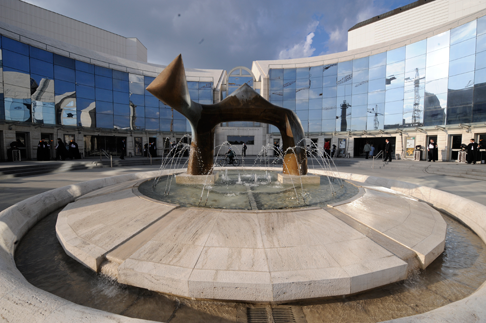 The new Slovak National Theatre
The new Slovak National Theatre
In person, Friedrich Haider is lively and affable, eager to communicate his love for the music of Wolf-Ferrari and full of questions, so that our interview was very much a dialogue and we concluded with a discussion of initiatives in the UK to attract younger audiences, something that interests him keenly.
We started with Wolf-Ferrari, a composer about whom Friedrich Haider feels very strongly. He first came across Wolf-Ferrari's work in 2002. In London for a recording with the London Symphony Orchestra, he found a score of Wolf-Ferrari's opera Il segreto di Susanna (Susanna's Secret) in a second hand book-shop. Reading the score through for the hour until the shop closed, he fell in love with the work and bought the score. A performance on the radio in Munich followed, with baritone Renato Bruson, and subsequently Friedrich Haider made a recording live recording with the Oviedo Filarmonia. After this first big step with Wolf-Ferrari, he looked at all the composer’s scores that he could find, and was not disappointed. Friedrich Haider regards over 70% of Wolf-Ferrari's music to be good, and certainly above average for many of the composers being discovered today.
Wolf-Ferrari was of mixed Italian and German heritage and trained in Munich. Though he loved Wagner's work he was against both Wagnerism and Verismo in his own operatic style. His first comedy Le donne curiose (1903) demonstrated his lighter touch, and made him an overnight success; Mahler heard it and conducted it in Vienna. Though Wolf-Ferrari would write 9 comedies, I gioielli della Madonna which SND is performing, is very different in style, being darker, eclectic and more dramatic (and is often erroneously regarded as an essay in Verismo). Friedrich Haider feels that you must know it to truly appreciate it, but that the work has everything that an Italian opera needs.
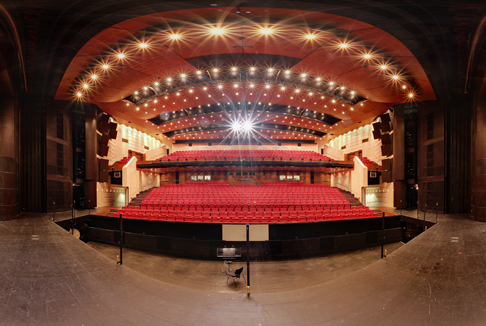 The interior of the new Slovak National Theatre
The interior of the new Slovak National Theatre
The plot is, on the surface, quite simple: two men Gennaro and Rafaele compete for the same woman, Maliella, and Gennaro steals the jewels of the Madonna to get her, with tragic results. Friedrich Haider sees the musical style of the piece arising because the plot demands it. It is the only work in which Wolf-Ferrari demonstrates that he can be a modernist, with passages at the end of Act 3 which blast tonality with a sequence of chords which you can no longer analyse. There are four bars which Friedrich Haider calls futuristic and remind him of Shostakovich, demonstrating that Wolf-Ferrari had post-Romantic harmony at his finger tips.
Friedrich Haider does not see Wolf-Ferrari's eclectic style as conscious, but rather it reflected the way the composer felt about the needs of the plot. He quotes Wolf-Ferrari as saying that when you write in D major it is important that it is a new D major, and he goes on to point out that Wagner followed the harmonic complexity and daring of Tristan und Isolde with the opening of Die Mestersinger which is in C major, which Friedrich Haider calls a C major which has never been heard before.
Friedrich Haider, isn’t interested in the particular style of a piece, for him if a work is good or not is expressed by the work itself and not its style, and he emphasises that he does not believe in the linear development of music, pointing to Richard Strauss's development after the daring of Elektra. Also a pianist, Friedrich Haider goes on to comment that having played many of Richard Strauss's songs he has realised that the C major which Richard Strauss writes at the beginning of his career is very different to the C major at the end.
I gioielli della Madonna can seem just a common criminal story But Friedrich Haider finds a deep psychological meaning in the work which makes it more rewarding to interpret. The society depicted in the piece is very much of the South, with a strong connection to religion and a cult of the Madonna which he calls much more than religion, being positively existential. The whole piece rooted in this society and for a production to work it needs to have Southern Italy (or perhaps Southern Spain) as its setting. For the people in this area, Gennaro's stealing of the jewels from the statue of the Madonna is the most terrible thing that he could do.
Friedrich Haider is also keen to explore Wolf-Ferrari’s links with analytical psychiatrist Carl Jung (1875-1961) whom he met in Vienna, citing the way Gennaro’s obsessions with his mother, the Madonna and with his step-sister Maliella link to Jung’s woman/Madonna/mother archetypes. He also points out the way Wolf-Ferrari characterises Rafaele and the Camorra with jolly music (including a waltz) rather than solemn, dangerous music. It shows they are like you and me, and not always dangerous.
Perhaps the most interesting aspect is the way Friedrich Haider links the
jewels of the Madonna to Rafaele’s attitude to Maliella. She is his Madonna,
and when she loses her virginity (her Jewels) he is no longer interested. During the rehearsal process they realised that the piece was still relevant
as papers were full of an event when in Southern Italy a procession of the
Madonna stopped and made a bow outside the house of a Mafia boss who was under
house arrest. Wolf-Ferrari's opera buffa works can be difficult to perform because of the
transparency of their orchestration, but Friedrich Haider sees the difficulties
of performing I gioielli della Madonna arise because of the work's
complexity, both in terms of harmony and instrumentation. It is not simply
written and for a conductor it is not easy to manage. (I suspect that this and
the large number of small solos are perhaps also behind the work's absence from
the opera stage). The large chorus and number of soloists make the work logistically difficult
to stage though Friedrich Haider has benefited from the big SND ensemble and
the strong choral scene in Bratislava, thus making it easy to cast the many
smaller roles with quite a few being sung by members of the choir. The response
to the work of all the performers has been consistently enthusiastic and there
was a lot of positive energy in rehearsals. Rather intriguingly not only are
Wolf-Ferrari and Friedrich Haider of mixed Italian and German heritage, but so
is the stage director of the production Manfred Schweigkofler. Friedrich Haider has recorded a number of Wolf-Ferrari's works, including
the violin concerto which Wolf-Ferrari wrote in 1943 for the young violinist
Giulia Bustabo with whom he had fallen in love. When planning the recording,
the young violinist Benjamin Schmidt agreed to look at the score (it was a work
he did not know), but after reading the score through Schmidt was highly
enthusiastic. And the press were equal in their enthusiasm for the work, when
the recording was released. Friedrich Haider feels a strong connection with
Wolf-Ferrari, and regards such success as not so much his as for the composer.
Other recordings planned includea setting of a Biblical story,
Talitha Kumi (a sacred mystery for tenor, baritone, choir and
orchestra), all the overtures and intermezzos, an early serenade and the late
missa brevis. They will also be recording the performances of I gioielli
della Madonna and are currently seeking a record company. I gioielli della Madonna is being performed in SND's new building,
which Friedrich Haider regards as being acoustically too dry, but it has
excellent technical facilities. SND is a substantial organisation with 950
employees and they do 150 operas per year (reduced from 170 by Friedrich Haider
in order to facilitate more rehearsal time), along with ballet and drama. There has been a 20% increase in ticket sales since he took over, and
Friedrich Haider comments that though they are never totally happy and always
find something to improve, their work is there to be judged by critics and
people and this increase shows that people appreciate the work. Friedrich
Haider has also tried to have a fresh, more modernist approach in the stage
direction, though he admits that the production of I gioielli della
Madonna is perhaps conservative. Regarding modernist direction, Friedrich Haider takes a pragmatic approach
commenting that he does not want stupid things, but some modern direction can
be good and he cites as an example the Peter Konwitschny production of La
Boheme which the company premiered in January 2014. But an audience must
want to see a production, and there is the cost to consider, but Friedrich
Haider wants productions in a style which will speak to the audience of today.
He regards direction in Germany today as being in something of a corner.
Directors need to remember that an audience is coming to the work and it should
be appreciated by them, and understood by them and for Friedrich Haider too
many directors forget this. As with most other opera companies he is concerned
with the number of young people coming to see productions, and is pleased that
their numbers in Bratislava have increased, pointing out that this is not the
case in many companies in Italy and in Germany. SND is doing more young
people's productions and these have been received fantastically. Up until now Friedrich Haider has been both Music Director and Opera
Director, but he is stepping down as Opera Director feeling that combining the
two roles is too tiring and he wants to devote his energy to the music but will
feel that he can still comment. He also wants to continue his campaign to
attract young people, taking it out of the opera house and go to universities
and schools to speak about music and opera. He points out that though when you
talk to them people are interested, they need to know about opera first, to
know that it exists and what it is about. Though we come to the end of our allotted time, our discussions continue as
Friedrich Haider escorts me out of his office, still full of alert energy
despite being interviewed by a series of journalists and highly interested in
what is going on in musical and operatic life in the UK. Robert Hugill 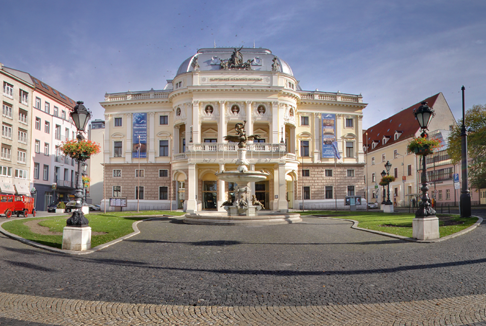 The old Slovak National Theatre
The old Slovak National Theatre
June 1, 2015
On Site Opera Presents 'Barber of Seville' at Fabbri Mansion on New York’s Upper East Side
By K. Young [Classicalite, 31 May 2015]
This summer, On Site Opera (OSO) will present a new production that personifies the company's mission to produce operas in non-traditional locations ideally suited to the stories they tell. This June (9-13), OSO will stage a site-specific production of The Barber of Seville at the opulent Fabbri Mansion (House of the Redeemer) on New York City's Upper East Side.
